BACKCOUNTRY JOURNAL







Imagine the excitement and anticipation after a long week of work as you load up the jon boat and head out to one of your favorite hunting or fishing spots. It’s going to be a glorious day, you think to yourself.
On the drive, you might ruminate about the grudge bass that you hooked a couple of times but couldn’t bring to the net, or the time you took your two young boys for their first waterfowl hunt or maybe the occasion when you just paddled around with your wife years before officially tying the knot. It’s a special place for you and countless others. And you probably never imagined you’d arrive there only to find the access illegally blocked by the adjoining landowner.
But that’s exactly what happened on Creslenn Lake in East Texas. Back in 2022, a private landowner made damn sure that no one could enjoy this treasured spot – except for himself – by illegally extending the land area between the road and the water using a backhoe to dredge up soil from the surrounding banks and installing an iron fence.
Down along the border of Henderson County, an oxbow lake that stretches for 12 miles parallel to the Trinity River has become a battleground for access to a public waterbody. Known locally as “The Cutoff,” Creslenn Lake has afforded generations of locals the right to hunt, fish, paddle and generally enjoy a variety of recreational opportunities available on public waters.
Access to this beloved resource has been affirmed by over a century of public use, as well as a “public waterbody” declaration by the Texas Parks and Wildlife Department. There is a wellestablished public right-of-way and public easement to access this navigable body of water and on two occasions the state even stocked it with Florida bass. In short, the Cutoff’s status as a public resource is not in question, even if inaction by public officials responsible for enforcing legal access is highly questionable. It might sound overly simplistic, but this really has become an issue of right vs. wrong.
The often-tenuous nature of access to public lands, waters and wildlife transcends geography. Look no further than just how much the mission of Backcountry Hunters & Anglers has resonated well beyond the region of our founding. And while there’s no qualifier or explanation needed to underscore the tremendous value of public natural resources across North America, when the right to enjoy these treasures is taken away, it might matter just a bit more in places where public resources are already limited. And in Texas, over 95% of landholdings are privately held.
So what happens when a private landowner illegally prohibits already limited access and violates a number of state and federal regulations in the process? Well, so far, nothing.
Despite three letters of formal notice by the Texas Department of Transportation regarding alteration of the transportation rightof-way and demands the fence be removed, a cease and desist order issued by the U.S. Army Corps of Engineers for illegal dredging and filling, and over $800,000 in damages documented by TPWD, the landowner’s underhanded action still stands. Hunters and anglers have rebuffed repeated attempts to privatize the Cutoff over the years, including passing a bill in 1931 that affirmed “[the Cutoff] shall not be sold and shall remain open to the public for hunting
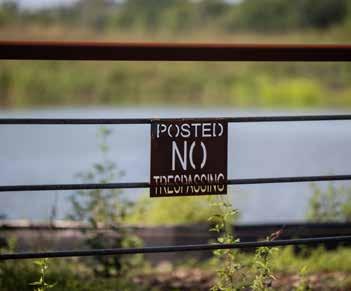
and fishing,” but that doesn’t seem to matter either.
So, what’s the barrier to enforcing the law and taking decisive action? Politics, of course. Or more accurately in this case, political connections. It’s a classic case of regular, hard-working citizens getting screwed by good-ol’-boy politics and a landowner with deep pockets.
A local citizen’s group called “Save the Cutoff” was created in response to the circumstance and has filed multiple lawsuits to restore access. These efforts have garnered strong support from the Texas Rivers Protection Association and, more recently, BHA’s Texas chapter – which has contributed directly to legal fees and filed an amicus brief to the court in support of public access. It’s truly a maddening state of affairs in which citizens who have historically enjoyed recreating on the Cutoff have been draining their own financial resources to restore ownership of something that never should have been taken away in the first place. So far, close to $200,000 in legal fees have been spent taking action to restore access.
The first lawsuit filed by Save the Cutoff seeks to enforce provisions in the Clean Water Act that prohibit discharge of dredged or fill materials into waters of the United States. The second lawsuit is aimed directly at the landowner for blocking public access to a navigable waterway. This second legal action seeks to reaffirm that the Cutoff is a navigable stream, declare that the landowner violated the Texas Water Code with the placement of obstructive fill, and assert that construction of the illegal fence is a nuisance that has violated their right to fish. The third lawsuit is directed at the county and county commissioner for failure to maintain access to an adjacent roadway that has provided historic access to the Cutoff.
To date, the riprap and fill continue to pollute the water, hunters and anglers continue to be blocked by the illegal fence, and the shocking display of inaction continues to affirm that money and power matter more than clearly settled law. This is exactly why BHA exists, and knowing this could just as easily happen in your part of the world, I hope you can all find a few dollars to donate to the cause. To learn more, check out backcountryhunters.org/ save_the_cutoff
-Patrick Berry, President & CEO

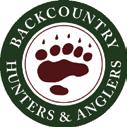

“There is pleasure in the pathless woods.” - Lord Byron
Ryan Callaghan (Montana) Chairman
Dr. Christopher L. Jenkins (Georgia) Vice Chair
Jeffrey Jones (Alabama) Treasurer
Katie Morrison (Alberta) Secretary
Patrick Berry, President & CEO
Frankie McBurney Olson, Vice President of Operations
Dr. Keenan Adams (Puerto Rico)
Bill Hanlon (British Columbia)
Jim Harrington (Michigan)
Hilary Hutcheson (Montana)
Ted Koch (Idaho)
Nadia Marji, Vice President of Marketing and Communications
Katie DeLorenzo, Western Field Director
Britney Fregerio, Director of Finance
Chris Hennessey, Eastern Field Director
Dre Arman, Chapter Coordinator (ID, NV)
Brian Bird, Chapter Coordinator (NJ, NY, New England)
Chris Borgatti, Eastern Policy and Conservation Manager
Kylee Burleigh, Digital Media Coordinator
Tiffany Cimino, Membership and Community Development Manager
Trey Curtiss, Strategic Partnerships and Conservation Programs Manager
Robert DeSoto, Habitat Stewardship Coordinator (OR)
Bard Edrington V, Habitat Stewardship Coordinator (NM)
Brady Fryberger, Office Manager
Mary Glaves, Chapter Coordinator (AK)
Chris Hager, Chapter Coordinator (WA, OR)
Contributors in this Issue
On the Cover: BHA North American Board Member Hilary Hutcheson with a westslope cutthroat trout. Photo by Aaron Agosto Above Image: Samantha Lewis, 2022 Public Lands and Waters Photo Contest
Col. Mike Abell, Charlie Booher, James Brandenburg, T. Travis Brown, Jamie Cameron, Curtis Collins, Michael Drew, Luke Etchison, Heather E. Goodman, Millie Hibbs, K.C. Huxtable, Cameron J. Kirby, J.J. Laberge, Paul Lask, Jordan Lefler, David Lien, Jesse C. McEntee, Matthew Meyer, Harley McAllister, David O. Miller, Eric Nuse, Anthony Pozzi, Kurt Ratzlaff, Taylor Twisdale, Kelsey Wellington, Ben Wiley, Kelly Williams, Corey Zimmerman
Journal Submissions: williams@backcountryhunters.org
Advertising and Partnership Inquiries: mills@backcountryhunters.org
Ray Penny (Oklahoma)
Don Rank (Pennsylvania)
Peter Vandergrift (Montana)
J.R. Young (California)
Michael Beagle (Oregon) President Emeritus
Andrew Hahne, Habitat Stewardship Coordinator (MT, ID, WY)
Aaron Hebeisen, Chapter Coordinator (IA, IL, MN, MO, WI)
Jameson Hibbs, Chapter Coordinator (IN, MI, OH, OK, KY, TN, WV)
Bryan Jones, Chapter Coordinator (CO, WY)
Kaden McArthur, Goverment Relations Manager
Josh Mills, Corporate Conservation Partnerships Coordinator
Devin O’Dea, Western Policy and Conservation Manager
Brittany Parker, Habitat Stewardship Manager
Thomas Plank, Communications Manager
Kylie Schumacher, Chapter Coordinator (MT, ND, SD)
Max Siebert, Operations Coordinator
Harrison Stasik, Events Assistant
Joel Weltzien, Chapter Coordinator (CA)
Briant Wiles, Habitat Stewardship Coordinator (CO)
Zack Williams, Backcountry Journal Editor
Interns: Lars Chinburg (Backcountry Journal intern), Maisie Kroon, Sylvie Poore, Taigen Worthington
P.O. Box 9257, Missoula, MT 59807 www.backcountryhunters.org admin@backcountryhunters.org (406) 926-1908
Backcountry Journal is the quarterly membership publication of Backcountry Hunters & Anglers, a North American conservation nonprofit 501(c)(3) with chapters in 48 states and the District of Columbia, two Canadian provinces and one Canadian territory. Become part of the voice for our wild public lands, waters and wildlife. Join us at backcountryhunters.org
All rights reserved. Content may not be reproduced in any manner without the consent of the publisher.
Published July 2024. Volume XIX, Issue III
General Inquiries: admin@backcountryhunters.org JOIN THE CONVERSATION



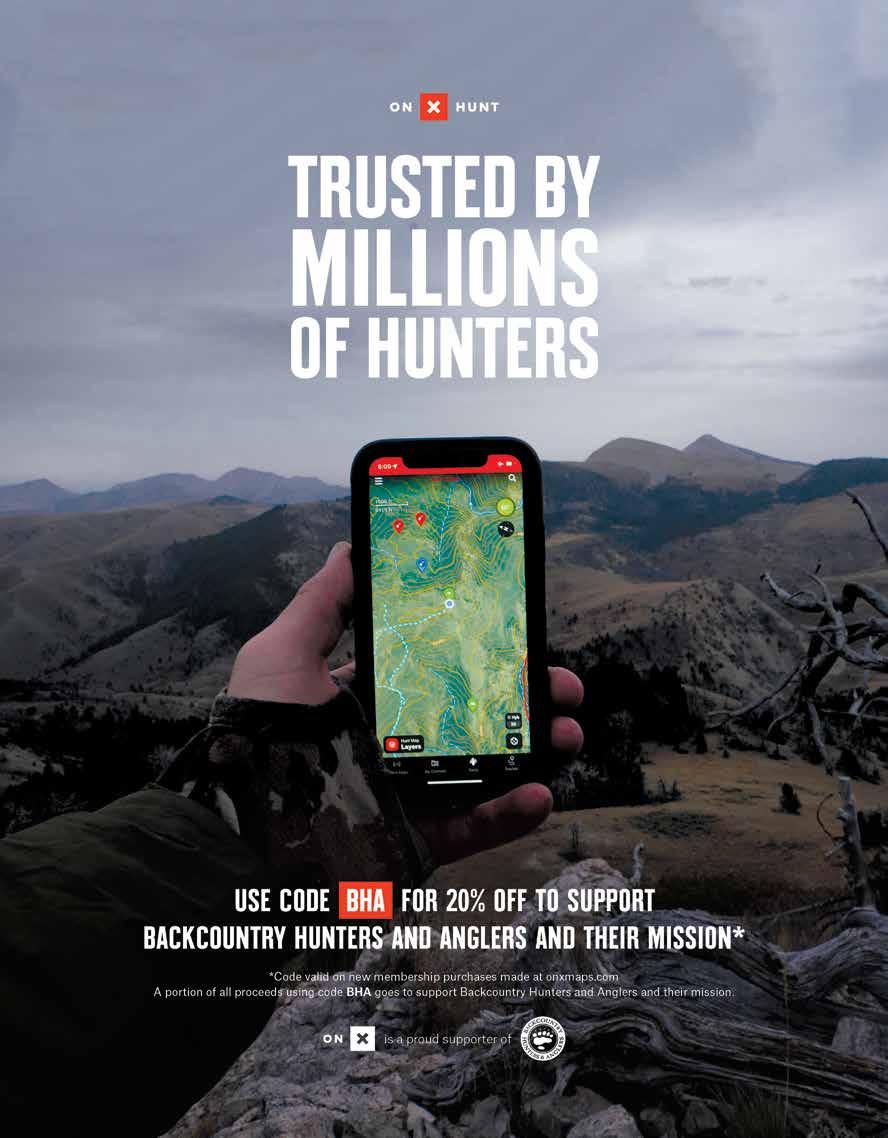
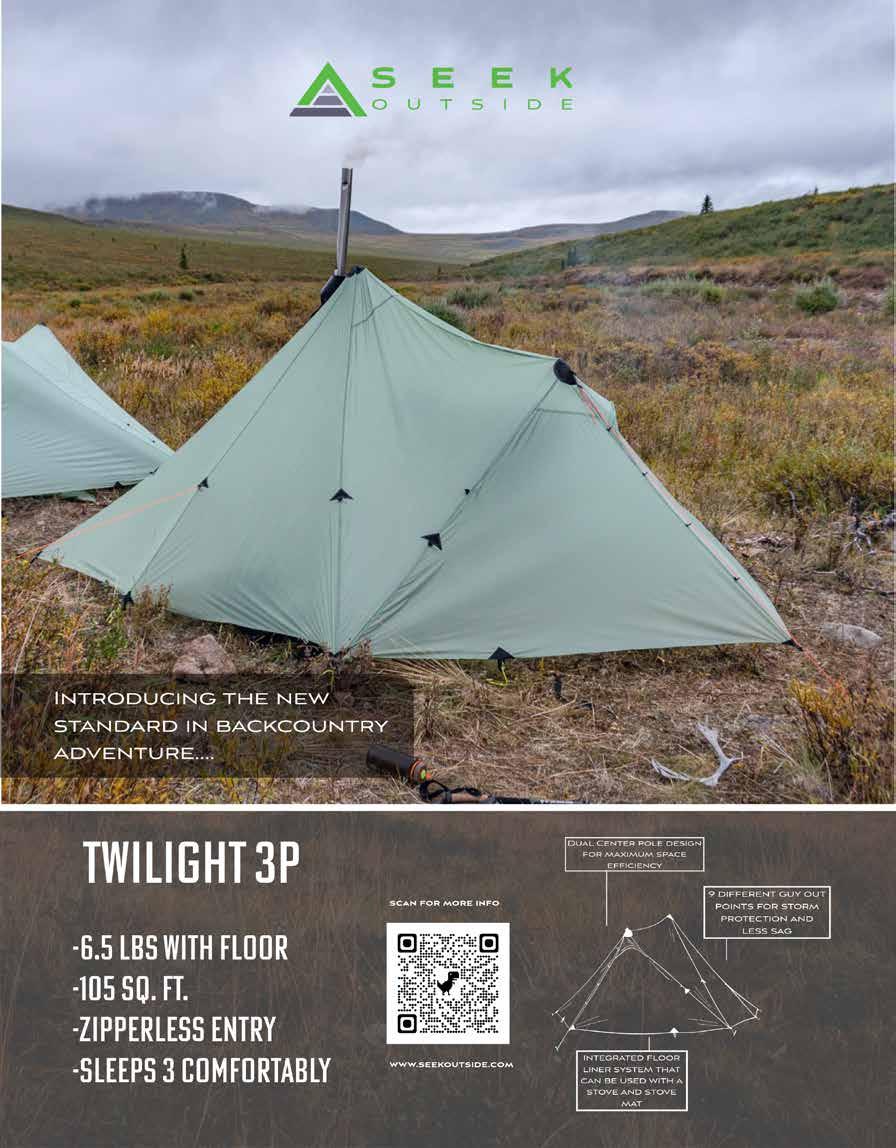

BY DAVID LIEN
Backcountry hunters and anglers value wild country, clean water and intact habitat. It’s a founding principal of this organization, and one that remains a priority today.
But we aren’t the only ones who know their value. Five years ago, I teamed up with rancher Bill Fales to advocate for protecting Colorado’s Thompson Divide from proposed oil and gas development. Bill and his family ranch alongside the Crystal River, south of Carbondale. The ranch has been in their family since 1924. They rely on summer grazing permits in the Thompson Divide.
“West Slope ranches rely on high-quality summer pastures and clean water from the Thompson Divide,” we wrote in an April 2019 Post Independent op-ed. “The area spans dozens of watersheds, provides domestic and agricultural water in the Crystal, Roaring Fork and Colorado River valleys, and supports 8,000 acres of cropland in the North Fork Valley, one of the most productive organic farming regions in the nation.”
“Hunters and anglers … feel the same way about protecting public lands along the Continental Divide,” we wrote. “Wildlife populations along the I-70 corridor have been in steep decline for decades due to poor land use decisions and over-development in some of the best historic habitat.”
Perry Will, a former Colorado Parks and Wildlife supervisor –now serving in the state legislature – said elk in the region just don’t have the solitude they need any longer.
For example, in a single decade approximately half of Eagle County’s elk population vanished. From Vail Pass to Glenwood Canyon, since the 2007 count by CPW, the numbers dropped by 50%. CPW previously issued about 2,000 hunting tags for the area. During 2018, just 200 were issued. “It’s not like the elk are moving somewhere else; they are just dying off,” Will said. In addition, Colorado’s statewide mule deer population plunged from 600,000 in 2006 to about 433,000 in 2018.
Big game (and other) habitat in the Thompson Divide region and across the state is being sliced and diced into ever smaller pieces by the sloppy knives of energy development, road and trail building (legal and illegal) and expanding year-round outdoor recreation, which is why the April 2024 Department of the Interior’s Thompson Divide Administrative Mineral Withdrawal announcement was welcome and long overdue.
The withdrawal protects 225,000 acres of public lands in western Colorado from future oil and gas leasing and mining for the next 20 years and is the result of a decade and a half of community collaboration – with local ranchers, hunters, anglers, businesses and numerous other concerned groups and individual citizens contributing to the long-sought victory.
“For many years, the communities surrounding the Thompson Divide have joined together to advocate for the protection of the Divide from the threat of new fossil fuel development – a use that is not compatible with the livelihoods of those that rely on this landscape today,” said Ben Bohmfalk, mayor of the town of Carbondale in an April 2024 E&E News story. “We thank the Biden administration for finalizing the process to withdraw the Thompson Divide area from new oil and gas leases.”
As mayor Bohmfalk noted, the Thompson Divide – which includes big game migration routes, spring elk and deer calving grounds and Colorado cutthroat trout habitat – is too valuable to develop; ranchers, hunters, anglers and local leaders in western Colorado all agree. Although the Federal Land Policy and Management Act authorizes the Department of Interior secretary to withdraw lands for a maximum of 20 years, our best chance to permanently protect the Thompson Divide and the Continental Divide is the Colorado Outdoor Recreation and Economy (CORE) Act.
Spearheaded by Sen. Michael Bennet (D-CO) and Rep. Joe Neguse (D-CO), the CORE Act would make the Thompson Divide withdrawal permanent, designate 71,000 acres of new wilderness areas and create nearly 80,000 acres of new recreation and conservation management areas in the region.
What Bill Fales and I emphasized in our op-ed over half a decade ago still holds true today: “Healthy, unfragmented public lands in the Continental Divide provide some of the best habitat for wildlife and the best backcountry hunting opportunities in the Central Rockies … We applaud Sen. Michael Bennet and Rep. Joe Neguse for introducing the Colorado Outdoor Recreation and Economy Act. Thank you for your bold and comprehensive vision to safeguard these revered landscapes and support our outdoor recreation economy.”
I am in favor of using our natural resources responsibly, but sometimes oil and gas companies need to take “no” for an answer; this is one of those times. As BHA members know from boots on the ground experience, we are first and foremost dedicated to protecting public lands habitat – wherever, whenever and however we can. However, only Congress can permanently protect this landscape, and we will continue to push for passage of the CORE Act to do just that.
David Lien is a former Air Force officer and co-chair of the Colorado chapter of BHA. He’s the author of Hunting for Experience: Tales of Hunting & Habitat Conservation and was the 2019 recipient of BHA’s Mike Beagle-Chairman’s Award “for outstanding effort on behalf of Backcountry Hunters & Anglers.”





As the leading voice for our wild public lands, waters, and wildlife, Backcountry Hunters & Anglers applauded the Public Lands Rule finalized in April by the Bureau of Land Management recognizing conservation in public land management as a value on par with other uses. The rule represents a long overdue acknowledgement of the tremendous value of fish and wildlife habitat and recognition that BLM land holdings are owned by all Americans.
“Hunters and anglers support the Public Lands Rule because it will prioritize important active management prescriptions to tackle invasive species, restore degraded lands and waters, and conserve intact habitats critical to wildlife corridors,” said Kaden McArthur, BHA’s government relations manager. “With less than 15% of BLM lands currently managed for conservation, this is a critical step forward to properly balancing the use of our largest public lands estate.”
The BLM stewards 245 million acres of public lands that include significant habitat and ecological resources upon which hunters and anglers rely for opportunities to pursue their outdoor passions. The rule clarifies that the management of these public lands for conservation is a valid use and should be considered as such under the multiple-use and sustained yield framework of the Federal Land Policy and Management Act.
“When implemented, the rule will provide tremendous longterm conservation and recreational benefits on land stewarded by the BLM that finally represents the interest of more Americans,” said Patrick Berry, BHA’s president and CEO.
The final rule follows an extended public comment period, including feedback from thousands of hunters and anglers to strengthen and clarify the rule. More than 90% of comments supported the rule, a testament to the importance of conservation across the United States.
The corner crossing legal fight took its next step in May as oral arguments for the legal case were held before a three-judge panel at the 10th Circuit Court of Appeals in Denver.
The case involves four Missouri hunters who used a ladder to “corner cross” from one public land parcel to another without setting foot on private land, navigating the checkerboard layout common in the West. Those legal proceedings continued to focus on key issues centered on public land access rights and private property boundaries.
Ryan Semerad, the lawyer for the hunters, argued that they were within their rights under the Unlawful Enclosures Act, which prohibits private landowners from blocking access to public lands. In contrast, the lawyers for Elk Mountain Ranch argued that the hunters trespassed into his property’s airspace, thus diminishing the value of the private land. U.S. District Judge Scott Skavdahl previously ruled in favor of the hunters, stating that corner crossing without touching private land did not constitute trespass.
BHA and other conservation groups filed amicus briefs supporting the hunters, emphasizing the importance of maintaining public access to millions of acres of federal land and arguing that a ruling against corner crossing would effectively privatize public lands, limiting access to only those wealthy enough to own adjacent properties.
The oral arguments highlighted these points, with both sides presenting their cases on the legality and implications of corner crossing. The judges on the panel peppered both lawyers with a variety of deliberate questions that indicated an interest in the greater implications of this case. The decision of the 10th Circuit will have significant ramifications for public land access across the West.
We expect that the panel will issue a ruling on this case within three months, at which point BHA will be leading the charge on the next steps for this critical issue.


20 Years of BHA with Ben Long and Patrick Berry: Ben Long is a founding board member of BHA, the author of the Hunter and Angler’s Guide to Raising Hell and a lifelong hunter-conservationist of the old breed. Ben came to Rendezvous this year to meet with new BHA President and CEO Patrick Berry of Vermont and help chart a course for the future of the most dynamic hunter and angler conservation organization in history. Join us as Hal, Patrick and Ben look back at the origins of BHA – the people, the fire and the issues – and revel in the memories of where we’ve been and celebrate where we’re headed.

Peter Vandergrift has spent his entire career in the fly fishing industry. He cut his teeth guiding in the shadow of what would be the Pebble Mine and later guided and outfitted fly fishing in Montana and Wyoming for 18 years in total. He then worked at industry giants Simms Fishing Products and Costa. He is currently the Chief Marketing Officer of North Point Brands whose stable of brands include Cheeky Fishing, RepYourWater, RepYourWild, and Wingo Outdoors.
He lives in Missoula, Montana with his wife and two river-rat daughters. Peter is an avid bowhunter, chases upland birds with his black Lab and fishes every corner of the world he can access.
Robert was born and raised in southern Louisiana. It was during a two-month journey through the Rockies that he decided to make a career of conservation.

Robert moved to Montana in 2021 and hasn’t looked back. Splitting his time between hunting and fishing and conservation work, he feels incredibly lucky to spend most of his time in the wilds of the western U.S. As someone who has seen firsthand the impacts of poor access to and poor management of public lands, Robert is passionate about helping achieve the BHA mission.
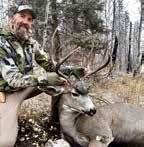
Bard’s passion for the outdoors was instilled in him at a young age hunting the woods of Alabama. He took this passion to the University of Tennessee where he studied wildlife management and went on to work in multiple biological technician jobs. He has monitored satin bowerbirds in Australia, taught fish farming in Zambia and searched for duck nests in the praire potholes of North Dakota.
Bard is also an award winning and internationally touring singer-songwriter living in Santa Fe, New Mexico. He spends countless hours on public lands scouting and hunting solo or with his teenage son.
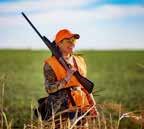
A graduate of Pittsburg State University in Pittsburg, Kansas, Nadia Marji worked her way up through the ranks of Kansas Department of Wildlife and Parks, holding positions ranging from Publications Writer II to serving as Kansas Wildlife and Parks Magazine’s first female executive editor. After 11 years with the department, Nadia hung up her KDWP hat as Chief of Public Affairs & Engagement Officer. Nadia joined BHA as Vice President of Marketing and Communications in May 2024, bringing with her 10-plus years of progressive strategic communications, public relations, marketing and leadership experience. She is a two-time national award winner in publications and communication campaigns and remains the only Kansan to have ever achieved the internationally-recognized Communication Management Professional certification. Nadia resides in Bonner Springs, Kansas with her English bulldog, Louie.
Harrison carries on his family’s passion for the outdoors as a third generation Wisconsin hunter and angler. While attending the University of WisconsinStevens Point, Harrison was introduced to BHA and became the chair of his university’s collegiate club. The organization and the events that he attended had such impact on his life that he now finds himself living in Montana, striving to host events that inspire North America’s conservationists the same way he was inspired.
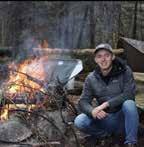
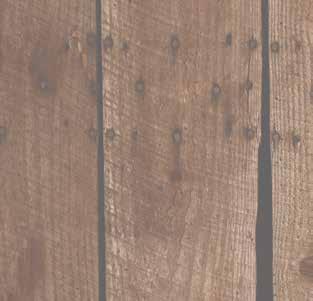

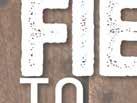






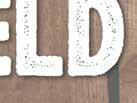
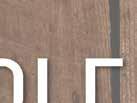







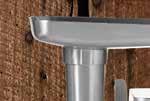

















BENTONVILLE, ARKANSAS
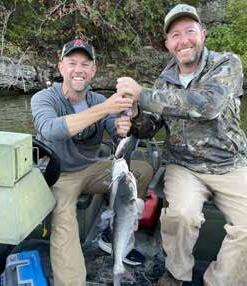
Arkansas Chapter Chair

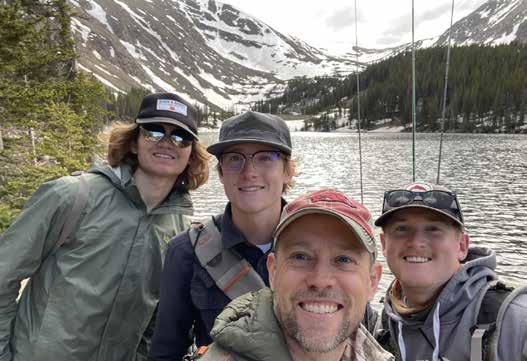
In 2017, I was vacationing with my family around Lake City, Colorado, and my boys asked me what all these “National Forest” signs meant. I gave them a vague answer about “public land” but I didn’t really know, and being the inquisitive minds that they are, they pressed for more. Together we looked into it. We had been recreating on public lands for most of our vacation and had no idea how or why we were allowed to be there. Later on, when I heard about efforts to divest of federal public lands, I was appalled – I had just figured out what they were, and I had so much to explore! BHA appeared on my radar, and I signed up right away. Since then, I have learned that I am part of a scrappy group of likeminded individuals who value the freedom and equality we can all find on our shared public lands and waters!
YOU WERE RECENTLY THE RECIPIENT OF BHA’S MIKE BEAGLE-CHAIRMAN’S AWARD FOR YOUR OUTSTANDING EFFORTS AS CHAIR OF THE ARKANSAS CHAPTER. FROM PROTECTING PUBLIC ACCESS AT PLACES LIKE PINETREE RESEARCH STATION TO HOSTING HUGE EVENTS LIKE THE BLACK BEAR BONANZA, YOU’RE CLEARLY DRIVEN AND DEDICATED TO BHA AND THE ORGANIZATION’S CAUSES. WHAT’S DRIVING YOU?
Protecting access to our shared resources is what I want to do. That takes on many forms. Some people are like me and my family in 2017, who didn’t even know what we had, and we need to help raise awareness about these wild places so that they remain highly valued for the experiences they can give us, just the way they are. Other people are all too aware of how precious their access is and aware of the threats to that access, and it is important to me to speak up for those people who otherwise wouldn’t. But what keeps me going is the belief that right now it is simply our turn to stand up and protect these places, and when our time passes, we should leave them better than we found them.
WHAT’S ONE ISSUE BHA IS CURRENTLY WORKING ON THAT YOU’RE PARTICULARLY PASSIONATE ABOUT? AND WHAT DO YOU SEE AS BHA’S ROLE IN ACHIEVING A POSITIVE OUTCOME?
The thing I am most concerned about right now are the attacks on our hunting and fishing heritage, especially the ones coming from inside the tent. It’s one thing to rally ourselves against a threat from outside of our ranks – like the stacking of the game commission in Washington, which the Washington chapter is fighting so valiantly. But it’s also a big concern when decision makers we think of as traditionally “for” hunting and fishing try to undermine the scientific management of our natural resources or diminish the authority of the agencies we trust to manage those resources – like what Kentucky just went through. To be successful, we need to remain vigilant, build our alliances in advance and stay engaged in the process. We must continually tell our story, or somebody else will try to tell it for us.
WHAT DO YOU LIKE TO DO IN YOUR FREE TIME ON PUBLIC LANDS AND WATERS?
I love to explore them with a rod, a bow or a gun in my hand whenever I can. I’ll never be so zealous about any one species to forsake all the others, so I’m a generalist hunter and angler at heart, and I’m always looking for the next adventure.
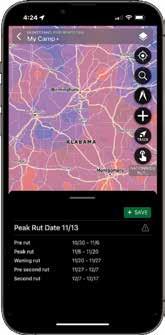
WHITETAIL RUT MAP Unlock the most extensive Rut Map in the country

WHITETAIL ACTIVITY FORECAST Plan your hunt around peak movement times
Join millions of hunters who use HuntStand to view property lines, find public hunting land, and manage their hunting property. Enjoy a powerful collection of maps and tools — including nationwide rut dates and a 7-day whitetail activity forecast with peak deer movement times.

WHITETAIL

Download and map for FREE!










BHA’s Backcountry Bounty is a celebration not of antler size but of BHA’s values: wild places, hard work, fair chase and wild-harvested food. Send your submissions to williams@backcountryhunters.org or share your photos with us by using #backcountryhuntersandanglers on social media! Emailed bounty submissions may also appear on social media.




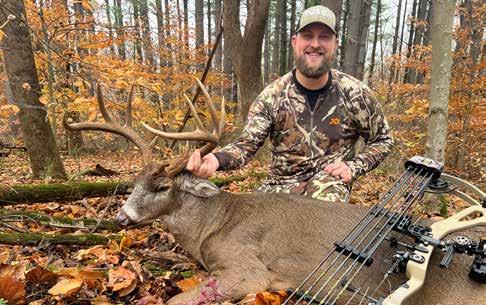

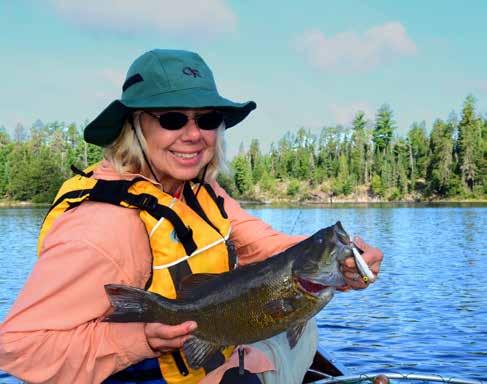



BY MILLIE HIBBS
Find:
1. A cricket
2. A fossil
3. Pick up five pieces of trash from public lands.
4. A bald eagle
5. A blue native wildflower
6. A frog
7. A pinecone
8. A native grass
9. A cloud that looks like an animal
10. Identify a wild mushroom (with adult supervision).
11. Wildflower seeds
12. A wasp (stay clear of its backside!)
13. A piece of flint
14. A spiderweb in the outdoors
15. A nocturnal animal

Listen:
1. Listen and identify three nighttime sounds.
2. Close your eyes on a windy day and listen to the wind for three minutes.
Enjoy:
1. Wading through a stream or river (with adult supervision)
2. Rubbing your hands through moss
3. A beautiful sunset
Millie Hibbs is the 10-year-old daughter of BHA Chapter Coordinator Jameson Hibbs. Residing in Kentucky, Millie loves camping, fishing, wading through streams, collecting rocks, singing, collecting flowers, adventuring and snacking!

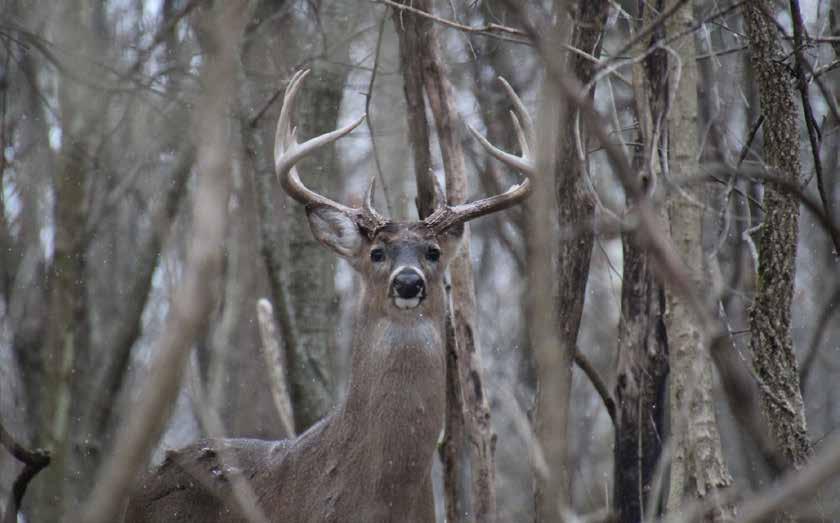
BHA’s Kentucky chapter successfully fights an effort to place wildlife department under the Department of Agriculture, learning valuable lessons and gaining strong partnerships along the way.
BY COL. MIKE ABELL
Science-based management of wildlife is one of the tenets of the North American Model of Wildlife Conservation – which has a long history of success. However, across North America this tenet is increasingly under threat. This year, Kentucky Senate Bill 3 became a lightning rod in the thunderstorm of attacks against our outdoor heritage and the science-based management of public lands, waters and wildlife. The bill would have moved the Kentucky Department of Fish and Wildlife Resources under the direct control of the Kentucky Department of Agriculture and would have given appointment authority of all nine Fish and Wildlife Commissioners to the Commissioner of Agriculture.The danger in this cannot be overstated.
Agriculture science generally seeks to reduce wildlife in order to increase farmers’ yield with no regard for proper wildlife and fisheries management. The Kentucky Farm Bureau, “The voice of Kentucky Agriculture,” lists the following as a state priority: “Seek effective wildlife management that will reduce wildlife populations in an effort to alleviate continued crop and livestock losses.”
It could only take one full seating of fish and wildlife commissioners appointed by the Kentucky Commissioner of Agriculture to extend season dates, expand bag limits and liberalize methods of take to reduce wildlife populations to unacceptable levels.
In opposition testimony on SB3, Sen. Robin Webb (D-KY), chair of the Kentucky Sportsmen’s Caucus, said, “This bill will set us back 40 years and make us the laughingstock of North America.”
The tactics being used to push this type of legislation through are equally as terrible and undemocratic as the actual bill. It was published in the afternoon on the very last day that a senator could legally sponsor a bill, giving us the least amount of time possible to take action before the end of the session.
Unfortunately, over the last five years the KDFWR has become a political pawn in a surreal game of partisan chess. The super majority in the legislature continues to try to reduce the power of the governor, and every year that has included changes to the management and authority of the KDFWR and the appointment authority of our fish and wildlife commissioners.
The critical role that powerful and nimble grassroots organizations like BHA can play – and the coalitions our members can form – becomes fully evident in moments like these. The Kentucky chapter of BHA rallied with our partners to form a coalition to beat this year’s exigent threat.
We beat SB 3 through our grassroots advocacy. It was rumored that because we beat down the bill, the senate would not confirm any of the five fish and wildlife commissioners appointed by the governor. We rallied the troops once again, and on the very last day of the session, the senate confirmed four of the five governor’s appointments to the commission.

ORGANIZATIONS LIKE BHA CAN PLAY – AND THE COALITIONS OUR MEMBERS CAN FORM – BECOMES FULLY EVIDENT IN MOMENTS LIKE THESE.
The Kentucky chapter gained valuable knowledge and experience throughout this fight – which it and other BHA chapters and partners can lean on as we continue to confront these battles against the North American Model we hold so dear.
BHA’s 2021 Rendezvous featured a panel led by John Gale and Gaspar Perricone about building coalitions to fight the forces that seek to separate us from our public lands, waters and wildlife. Kentucky chapter leaders were present, we learned from their hard-earned lessons and went back to the Commonwealth and started working.
The coalition that beat SB3 this year included Backcountry Hunters & Anglers, Safari Club International, Sportsmen’s Alliance, the Congressional Sportsmen’s Foundation, the American Sportfishing Association, BASS Conservation, the Boone and Crocket Club, Delta Waterfowl, the National Wild Turkey Federation, the League of Kentucky Sportsmen, the National Deer Association, Pheasants Forever, Quail Forever, the Rocky Mountain Elk Foundation, the Ruffed Grouse Society, the American Woodcock Society, Trout Unlimited and associated state/local chapters. That kind of network – that kind of coalition – did not happen overnight; the effort started in 2021, so this year’s victory was four years in the making.
Here are the lessons learned:
• Lobbyists are invaluable. We cannot afford one alone. We partner with other groups, and we share our lobbyist with a medical association. The main bill payer in Kentucky is Kentuckiana Safari Club.
• Relationships are everything. You can build them at Rendezvous, in a duck blind, deer camp or at the capital. Great relationships become partnerships.
• Working on legislation, partnership building, and direct lobbying is year-round work. Form a small team who are not only good at it but enjoy it, because it can be exhausting. These are the 5% of leaders in our community who can move the 95%.
• The rest of the chapter leaders and the membership-atlarge should prepare for legislative season the way they prepare for hunting season. It is not a year-round process for them, but they must be ready when the opportunities arise.
• Partnerships must be maintained. It can be as simple as monthly emails, texts and calls to the leaders in the community. But real partners attend each other’s events and work together year-round.
• Real partners agree to disagree quietly and not in public.
• Historical leaders, past presidents and past commissioners are invaluable and should be cultivated as partners. They have wisdom and connections that can move mountains.
• Partners must play to their strengths. Our best partner is Kentuckiana Safari Club. They have more money; we have more members. We can do things they cannot and vice versa.
• Send your legislators and your commissioners copies of your blog posts about chapter activities, especially when the event is in their district. Invite them to everything.
• It is almost more important to thank legislators for their positive actions than it is to point out their shortfalls.
• To start winning and quit defending, we must connect election season with legislative season. A legislator who did good things for us during the legislative season might return to their home district and see a billboard that says, “Thank you, Senator Smith, for standing up for public lands.” The opposite is also true. When they see us taking actions that directly affect their ability to be reelected, we start winning. Sometimes, maybe it is a partner who does this instead of a BHA chapter. It is still teamwork that wins.
If you don’t know where to start, find another chapter to mentor you. We looked to the Pennsylvania chapter of BHA as an example. Their advice and counsel were instrumental in our success. I assure you that someone on our continent-wide BHA team has already solved your problem – seek them out. When you find them, you will have the advice and counsel you need to win.
After the legislative session ended, I sat down and authored dozens of emails to the senators and representatives who helped us defeat SB3.
This response from Senator Higdon sums it up: “Thanks, Mike. You can credit your members that live in my district for their passion and persistence. Perfect example of participating in the process.”
Col. (retired) Mike Abell spent most of his adult life as a U.S. Army Infantryman. He now spends his time hunting, fishing and fighting for our public lands, waters and wildlife as a BHA chapter leader and life member in Kentucky.
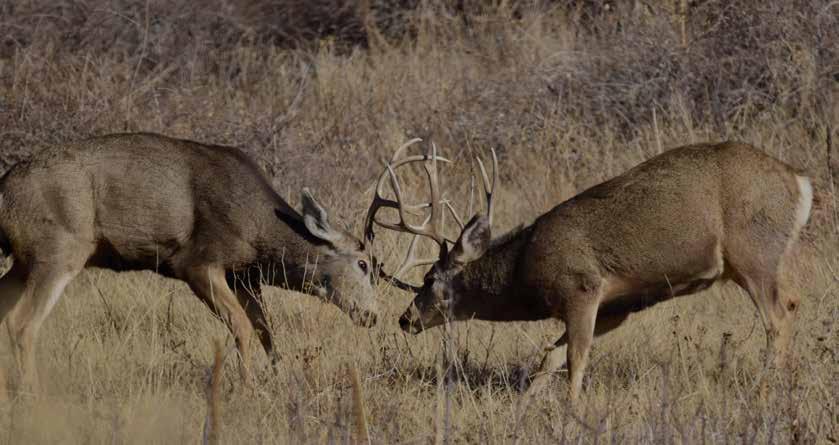
BHA’s Kansas chapter adapts on the fly and calls on grassroots membership to stand up for the North American Model of Wildlife Conservation against an onslaught of bad bills.
BY KURT RATZLAFF
As crazy as it sounds, deer drool on corn spewed from feeders essentially caused all of the legislative issues faced by the Kansas BHA chapter during the 2024 session.
It started when the Kansas Department of Wildlife and Parks held a listening session for the Kansas Wildlife and Parks Commission to determine whether they should explore the possibility of banning the baiting of deer to slow the spread of Chronic Wasting Disease, among other reasons. A couple of the commissioners seemed to have already decided in favor of the ban, and that panicked some hunting businesses who rely on baiting deer with corn. Internet rumors and conspiracies followed.
Apparently, some political favors were called in, and every reference to the discussion of deer baiting disappeared from the KDWP website overnight and has never been seen or heard of again. Not satisfied, when the Kansas legislative session began a few weeks later, a slew of bills were immediately introduced by politicians associated with the business side of hunting. Attempts were being made to abolish the Kansas Wildlife and Parks Commission and replace it with a new commission filled with people interested in privatizing wildlife.
Additional bills were pushing different versions of transferable deer tags, which are a familiar way to privatize or commoditize wildlife. Kansas has a history of transferable tags and a couple of episodes of the Kansas BHA Podcast have been dedicated to the topic. Episode 83, “Why Landowner Transferable Big Game Tags are Bad,” featured the Montana chapter’s Thomas Baumeister describing his experiences in Europe with that hunting system, and Mike Miller, a now-retired KDWP assistant secretary. Miller was on a committee in the early 2000s that reestablished a science-based tag system to replace the transferable tag system that Kansas had at the time. That new system helped make Kansas a destination for
deer hunters from around the globe.
The two bills that set out to “reconfigure” the Kansas Wildlife and Parks Commission were initially characterized as actions taken to avoid the problems seen in wildlife commissions in Colorado and Washington. But clearly, they were attempts to replace the current commission members with new ones. The hearings on those two bills always included more arguments against banning baiting than banning anti-hunters.
Early in the session, the chapter was not prepared for how quickly the hearings were set. We thought legislative committees would value public input and set hearings accordingly. But that was not the case. Those who are politically powerful can and did set hearings with little or no notice and openly sought to suspend rules requiring public input.
In response, the Kansas BHA chapter became quicker and nimbler. With the help of BHA staff, we were able to have action alerts ready at a moment’s notice. Board members developed relationships with their respective state representatives and senators. We used our podcast to get the word out to our members. And we sent out chapter-wide emails with updates on the legislation.
In the legislature, we gave personal testimony concerning the effect of the bills on our way of life and the public’s wildlife; we provided written testimony when none of our members could attend hearings.
The two transferable deer tag bills died in the first half of the session. But the two similar bills seeking to “reconfigure” the Kansas Wildlife and Parks Commission remained stubbornly in play.
We partnered with another organization to offer a written amendment that would establish criteria for commission appointees to meet. The amendment would have addressed the issues present on the commissions in Colorado and Washington. But the amendment went nowhere, proving this effort was not aimed at anti-hunters. This was a group of people and organizations attempting to control
the commission for the purpose of privatizing wildlife.
A point our chapter expressed throughout the process was that the commission had, in fact, acted in a responsible manner and was performing actions in line with the North American Model of Wildlife Conservation.
Eventually, the two commission bills were consolidated into one. Time passed. It appeared the bill was dead. Then a shell game called “gut and go” was utilized to bring the bill back to life. We would eventually learn that a deal had been cut between key representatives and the governor. A different commissioner nominating scheme was to be put in place. In a nod to the concerns raised by the Kansas BHA chapter, our conservation partners, and resident hunters and anglers across Kansas, the final bill included language that “in no case shall a controlled shooting licensee or any employee of such licensee, or any person providing hunting outfitting services or hunting guide services, be appointed to the commission.” We requested different and more enforceable language, but the deal had been cut. The governor had agreed to sign the bill when it reached her.
While the bill had become more tolerable with the changes that had been made, the replacement of the commissioners remained a sticking point since it implied they had done something wrong, which was not the case. Our final chance was to defeat the bill in the legislature, preventing it from reaching the governor. We made more calls, we sent more emails.
Two days were left in the session when the Kansas Senate took
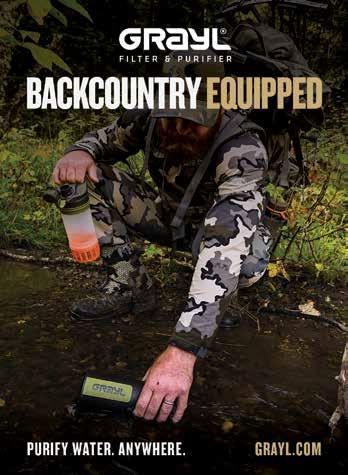
up the bill. Watching on YouTube, you cannot hear the votes being cast, but it felt like it was going to be close. The announced vote was a passed bill: 20-19. One senator, for some reason, then changed her vote to officially make it 21-18. The house passed it overwhelmingly. The bill has now been signed by the governor.
Our future with the effects of this bill remains a mystery. One thing we can count on is the interests who pushed this bill will continue their attacks. They will not care about the impacts to the public’s wildlife or the North American Model of Wildlife Conservation. They are businesses looking to profit off the public’s resources. And while America is the land of capitalism, that principle is not the guiding principle of American wildlife management.
To make us more effective in the future, Kansas BHA is banding together Kansas resident hunters, anglers, trappers and houndsmen to create a stronger legislative voice with the goal of providing access to quality hunting and fishing for all Kansans, regardless of means. Our group will be conducting outreach meetings with legislators over the summer and fall to help them gain a better understanding of the issues we face and the North American Model of Wildlife Conservation. We believe a better-informed legislature will better protect the outdoor heritage we all find so integral to this great nation.
BHA member Kurt Ratzlaff is an avid hunter, retired attorney and connoisseur of cheap bourbon. He is currently the legislative chair of the Kansas chapter of BHA.



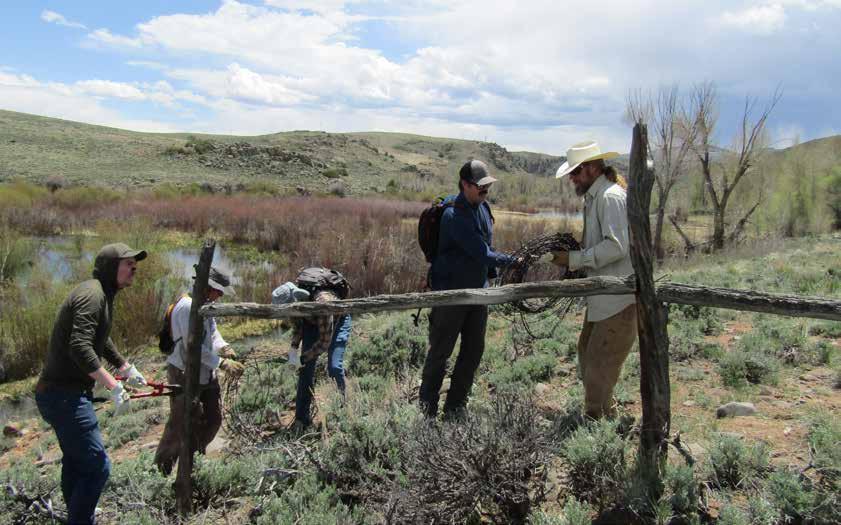
BHA chapters across North America are on the frontlines, battling attacks against the North American Model of Wildlife Conservation and getting their hands dirty cleaning up public lands and waters.
• The Alaska chapter is a partner in the Alaska Copper Ammo Challenge, which aims to educate hunters about how they can reduce the occurrence of lead poisoning in wildlife by voluntarily using non-lead ammunition. The challenge has been offering Alaska hunters a rebate of up to $80 off two boxes of copper rifle ammunition.
• The chapter is holding its first annual board retreat on Kodiak Island centered around the Buskin Lake Crawfish Removal event October 16, 2024.
• The chapter has been engaging on Federal Subsistence Board wildlife proposals and special actions across the state.
• At the chapter’s first Fishing for Conservation event, attendees planted trees on the riverbank to help with erosion control at Dead Horse State Park and then enjoyed an “Intro to Fishing” overview.
• The chapter closely tracked numerous conservation bills this legislative session and had board and general member presence in multiple committee hearings in addition to distributing several action alerts.
• The chapter hosted a MeatEater Trivia Pint Night in Tempe and welcomed several new members!
• A very successful 2nd Annual Catfish Camp was held at Lake Dardanelle.
• Our work continues to identify and create access to landlocked public parcels in Arkansas, in partnership with onX and the Arkansas Game and Fish Commission.
• The chapter hosted a cleanup and OHV sign day at Dale Bumpers National White River Refuge.
• The chapter held an After Work Fish and Paddle event at Pinnacle Mountain State Park, in partnership with AGFC.
• AFI identified its priority landscapes for 2024: prairie ecosystems in Montana, the Dakotas, and northeast Wyoming.
• AFI is hosting three events focused on antelope, mule deer and various
upland species throughout September and October this year. Visit our events page for more details.
• AFI’s Memorial Day membership drive was held with a kickoff party at the First Lite headquarters with the MeatEater crew.
• AFI continues to host virtual skills classes. These are the same classes we use at our in-person events. These recordings are live on YouTube.
• The chapter became a member of the Kootenay Fishing Regulation Advisory Team, advising officials on angling regulations, fair catch and accessibility.
• Leadership was in Victoria for Provincial Hunting and Trapping Advisory Team meetings regarding regulation proposals and changes, advocating for science-based decision making.
• Members volunteered countless hours representing the chapter at trade shows across the province, successfully recruiting dozens of new members.
• The California chapter celebrated the expansions of the San Gabriel and Berryessa Snow Mountain national monuments with a spring turkey camp, which was held a few miles away from the expanded acreage of Berryessa on a ridge known as Molok Luyuk.
• The chapter has been working to garner support for restoring hunting access to the Castle Mountains National Monument. This work has paid off, with Senator Pedilla introducing the Mojave National Preserve Boundary Adjustment Act, a bill to adjust the boundary of the Mojave National Preserve to include the land within the Castle Mountains National Monument. This legislation would reauthorize hunting access to the Castle Mountains while maintaining all resource and wildlife conservation protections.
• The chapter is also celebrating the recent release of the California Department of Fish & Wildlife’s Black Bear Conservation Plan for California. In 2022, the chapter helped fund a portion of the population study to help CDFW update this plan. The newly released plan utilizes additional population estimate metrics that show the number of black bears in California to be between 50,000-80,000 bears, a significant increase from previous estimates.

• Boulder Country Assistant Regional Director Kris Hess wrote an oped, “County Closure of Sugarloaf to Hunting Harms Hunters,” for the April 28 edition of the Daily Camera.
• The Department of the Interior decision to finalize a 20-year administrative mineral withdrawal for approximately 220,000 acres of the Thompson Divide was praised by the Colorado chapter.
• The chapter supports the Dolores River Canyons National Monument proposal.
• Elliot Silbar was elected as chapter treasurer.
• The chapter hosted a Hunting 101 event at Captain Kenny’s in Jupiter in May.
• The chapter hosted a deer scouting educational event at Riverbend Park in Jupiter in June.
GEORGIA
• The Georgia chapter held a Talking Turkey hunting seminar at Sweetwater Creek State Park. We introduced new hunters to turkey hunting, which included how to use a turkey call, processing a turkey and also some wild turkey recipes.
• The chapter has been raising awareness on the potential mining of the Okefenokee Swamp.
• University of Idaho Club President Jacob Young was awarded the Rachel L. Carson Award this year at Rendezvous. This award is intended to acknowledge a young leader who goes above and beyond in their contributions to the conservation, hunting or angling communities.
• The University of Idaho Club coordinated a successful planting project at Craig Mountain Wildlife Management Area.
• The Idaho chapter will continue to hold and support projects throughout the summer. Reach out to a chapter leader for more information.
• 98% of Illinois streams remain inaccessible to the public. Illinois state law contradicts federal law meaning private landowners along the rivers own the moving water and the river bed. Since 2019, the Illinois chapter has and will continue to work to clear muddy Illinois law. Residents, get involved! Tell your legislators and the ILDNR it’s beyond time to clear Illinois stream access.
• Lake Shelbyville Archery Park is near completion. The chapter would like to thank our partners at USACE for the opportunity!
• We had a great turnout at the Wabashiki Fish & Wildlife Area grassroots workday where, in collaboration with the Indiana State University Collegiate Club and Indiana Pheasants Forever and Quail Forever, we built wood duck boxes and removed invasive plants and shrubs. This event was sponsored by a BHA Public Land Owner grant for collegiate chapters.
• We hosted a well-attended pint night at Afterburner Brewing Co. following the Wabashiki event.
• Three chapter board members represented BHA at the Sportsmen’s Luncheon at the Indiana Statehouse where they met with legislators to share BHA’s mission and discuss public lands and conservation concerns.
• The chapter board authored a letter to the editor that was published in regional newspapers, and we continue efforts to educate Hoosiers on the importance of science-based forest management.
• The chapter hosted a booth at the Iowa Deer Classic alongside BHA partner River Brothers Outfitters, where we promoted public lands, recruited new members and held a raffle.
• Board members attended the first Midwest-based BHA North American Rendezvous, where they got the opportunity to learn new innovative ideas from other chapter leaders.
• The chapter is in the process of promoting an auction for a 2024 Iowa Governor’s deer tag.
• In March, Kansas BHA members cleared hiking trails and cedar trees at the Flint Hills Nature Trail near Emporia; cleared brush at the DeSoto Wildlife Area; returned to the Chase State Fishing Lake for a trail and brush cleanup day; and held a BHA sporting clay event at Powder Creek in Lenexa where 16 shooters joined or renewed memberships.
• In April, the chapter held its first Conservation Coffee at Great Blue Heron Outdoors in Lawrence where Ned Kehde provided a history of the fishing industry in Kansas.
• Also in April, Kansas BHA hosted a sporting clay shoot at Michael Murphy and Sons Sporting Clays near Wichita.
• In February, the chapter placed the wood duck boxes we built last year at Harris-Dickerson Wildlife Management Area and also installed goose-nesting platforms at Peabody Wildlife Management Area.
• In February and March, we held two more Conservation Coffee series in Lexington with speakers including Kentucky Afield, the 6th District commissioner, conservation officers, Bluegrass Trout Unlimited, NWTF’s Double Eagle Chapter, a state senator, Canoe Kentucky and a trout fishing guide.
• In March, we went to Country Boy Brewing twice for our monthly pint nights, once for a fundraiser and again to host a turkey talk. AFI held their first-ever Fort Knox pint night. The chapter held a virtual elk talk with Kentucky Fish & Wildlife.
• In April, the chapter DEFEATED Kentucky Senate Bill 3, which would have made Kentucky Fish & Wildlife the first state fish and wildlife agency put directly under a Department of Agriculture.
• The chapter also held a virtual pre-season turkey talk and tabled at an Earth Day celebration in Winchester.
• The chapter hosted a meet and greet for new BHA President & CEO Patrick Berry at Founders Brewing in Grand Rapids.
• The chapter hosted the Grand Rapids Full Draw Film Tour on July 13.
• The chapter is looking forward to another great weekend at our 2024 Rendezvous, July 26-28.
• The chapter added Delaware to the region at the beginning of 2024; this addition included adding Patrick McMaster to the board as representation.
• To be more representative of the chapter’s footprint, the “Capital Chapter” was renamed to the Mid-Atlantic Chapter, which now includes Virginia, Maryland, Washington D.C. and Delaware.
• Events, outreach and access issues continue throughout the region. A kickoff pint night occurred in Delaware to welcome the state to the chapter. Events and networking continues with a workday scheduled at Brandywine State Park to erect new deer stands for hunters this fall.
• The chapter hosted BHA members from around the country for a chapter leader wild game potluck and a welcome party at Unmapped Brewing to kick off Rendezvous 2024.
• The chapter partnered with the U.S. Forest Service in Ely to train new sawyers and instructors for future stewardship projects on federal forest lands.
• In May, the chapter mentored 11 new hunters in a Learn to Hunt Turkey workshop in Southeastern Minnesota.

• The Missouri chapter is hosting the Full Draw Film Tour on August 10. Great films, great prizes and a great time! Get your tickets at fulldrawfilmtour.com before they sell out!
• Stop by Dive Bomb Industries Squadfest July 19 -20 in St. Louis for your chance to win a shotgun and other great prizes from the chapter. Squadfest is a free admission waterfowling event for the entire family!
• Want to see chapter events in your area? Contact Missouri@backcountryhunters.org to learn about volunteer opportunities!
• The Montana chapter raised a record amount for mule deer conservation and solidified a more equitable raffle approach as an alternative to an auction for the statewide mule deer tag.
• The chapter welcomed four new board members: Micah, Luke, John and Manning.
• The chapter supported a 17,000-acre public lands acquisition near Missoula and a 32,981-acre conservation easement in northwest Montana; discouraged the USFWS from developing waterfowl production areas; celebrated the introduction of the bipartisan Public Lands in Public Hands Act; advocated for quiet recreation, large-landscape conservation and wild lands and waters in the Lolo National Forest Plan Revision.
• The chapter has scheduled at least seven summer stewardship projects; please join us!
• The chapter continues to engage on policy issues related to energy development, public land transfers and wildlife management at various levels of government.
• The chapter is collaborating with the California chapter and other organizations to support several stewardship projects for habitat restoration across the Great Basin.
• The chapter also partnered with the California chapter to exhibit at the National Outdoor Recreation Conference, ensuring that hunters and anglers are included in recreation conversations across the U.S.
• Recent workdays have taken place around the region, including fence removal in Maine and a cleanup at Dead Creek Wildlife Management Area in Vermont.
• Connecticut members gathered for a workshop about foraging for edibles among local plants, including invasives.
• Vermont members across the state successfully raised their voices throughout the legislative session to help fight off a bill that would have radically and negatively altered how hunting, fishing and trapping are managed in the state.
• The New Jersey chapter held a trivia night in mid-June. The contest was open to current and prospective members.
• Chapter board member John Provenzale donated a custom-made sinew-backed osage longbow to the 2024 Rendezvous Online Auction. The winning bidder received a one-of-a-kind 64-inch longbow with a draw weight tailored to his or her own specifications.
• The chapter and Kirtland Air Force Base AFI volunteers joined Forest Service staff from the Lincoln National Forest to construct two beaver dam analogs in Bonito Creek in southern New Mexico to improve habitat for future native cutthroat trout reintroduction.
• For the fourth consecutive year, the chapter improved habitat permeability for pronghorn on the Kiowa National Grasslands by modifying and verifying the height of 16.8 miles of fence and completing 0.42 miles of exclosure work, which improved 6,412 acres of shortgrass prairie habitat. Less than 10 miles of interior fencing in New Mexico
remain to be modified!
• Life member and board member Mark Mattaini was appointed by the New Mexico Game Commission to a five-year term on the Habitat Stamp Citizens’ Advisory Committee.
• We partnered with Santa Fe Ducks Unlimited for a Rio Grande River cleanup near Algodones.
• Chapter volunteers gathered to help clean up Three Rivers Wildlife Management Area as part of a stewardship agreement we have with the Department of Environmental Conservation for the property. The crew of volunteers removed close to 50 bags of trash, a big screen TV and a toilet.
• The chapter collaborated with New York City Trout Unlimited and New York Hunters of Color for the Amawalk/Muscoot River Arbor Day tree planting. Over 50 trees were planted on the banks of the Muscoot River to help prevent erosion.
• The chapter was at the Western New York Sport Expo in Hamburg selling BHA merch, talking hunting and fishing and telling folks about BHA’s mission to protect our public lands and waters.
• Chapter members recently served venison smash burgers in Winston-Salem at a successful event to invite folks to try wild game, recruit new members and discuss conservation issues in the state.
• Chapter leaders are talking with members and other conservation-minded folks across the state about top wildlife and public lands issues to prioritize the rest of this year and beyond.
• The chapter will hold its second annual Conservation Banquet, to be held Aug. 17 in Charlotte.
• The chapter hosted volunteer workdays on the Sheyenne National Grasslands and Pipestem Reservoir to upgrade public facilities, pick up trash, replace signage and improve habitat.
• The chapter started the North Dakota BHA Podcast and released three episodes with special guests Hal Herring and Randy Newberg.
• Chapter leaders attended BHA’s North American Rendezvous and participated in chapter leader training.
• In March, several chapter leaders and members traveled to Bentonville, Arkansas, to partner with the Arkansas chapter to host the 3rd Annual Black Bear Bonanza. Attendance was over 1,200 people from numerous states and even Canada!
• The Oklahoma chapter hosted the International Fly Fishing Film Festival at Circle Cinema in Tulsa on March 14.
• Members of the Oklahoma chapter placed third in the Wild Game Cook-Off at the North American Rendezvous! Watch out next year!
• The Oklahoma chapter once again partnered with Quail Forever on a habitat project at Osage Rock Creek Wildlife Management Area on June 8.
• The Oregon chapter held a great event in April – their second Cut and Cook event. With a group of 50-plus, they broke down turkeys and managed to cook up some incredible table fare to share with eager participants.
• The Oregon chapter has prioritized the right to hunt and fish in its current legislation process. With the Oregon Prohibit the Injury or Killing of Animals Initiative still in play, they are working diligently in opposition across the state.
• Chapter board member Samantha Lutz has organized a series of stream restoration projects in partnership with the Western Pennsylvania Conservancy.
• The chapter has completed the first two installments of a three-part fly fishing course supported by a team of board members, volunteers and R3 grant funding through the Pennsylvania Fish and Boat Commission.
• Chapter Chair Adam Eckley testified before the Pennsylvania House of Representatives Game and Fisheries Committee on April 9 in support of legislation that permits Sunday hunting.
• The chapter held a 3D archery shoot on July 13 at the Archery & Bow Club.
• The chapter is currently seeking to fill a few spots on the board to further broaden the reach within our state. Any interested people can reach out to southcarolina@backcountryhunters.org
• The chapter will continue to monitor potential changes to our turkey season regulations that could be implemented as soon as 2025, as well as a bill that could extend deer season in two of our game zones.
• The chapter will be hosting a few pint nights throughout the state later in the year. Keep up to date on new events via our social media.
• The chapter submitted a letter in opposition to the Final Environmental Assessment and Draft Decision Notice for the proposed Golden Crest Exploration Drilling Project.
• The chapter hosted a pint night tour across the state, bringing together members in Rapid City, Pierre and Sioux Falls.
• The chapter added six new members to our board. Welcome Trevor, Chris, Derek, Kevin, Tyler and Andrew!
• The Southeast chapter has teamed up with the Alabama Riverkeepers to generate support for the SHOR Act, a bill to strengthen protection of anglers’ right to know about fish consumption advisories. If you are an Alabama voter, please take a serious look at this act and express your support.
• Louisiana members need to be aware of a few changes to the 20242025 regulations, including LWCF’s notice of intent to conduct a Louisiana resident-only lottery for a black bear hunting season in Dec. 2024 and a ban on the use of drones for wounded-game recovery.
• The Southeast chapter continues to seek leaders for local, regional, state and chapter-wide roles. If you are interested in a leadership position or just want to get more involved, let us know!
• The Tennessee chapter sponsored an archery shoot at the Old Hickory Lake Bowman’s Club. This event strengthened bonds with the mid-state archery community as well as introduced shooters to BHA’s unique role in protecting Tennessee’s public lands and waters.
• The U.S. Army Corps of Engineers’ Nashville District had a comment period last fall regarding the water control manual for Center Hill Lake Dam. The Caney Fork River flows out of the dam and was insufficiently managed to maintain enough dissolved oxygen to support the world class trout fishery. The chapter leveraged its member base to comment for the option that provided a constant flow of 250 cubic feet per second, which will support the fishery. We had many conservation partners in this effort as well.In late April, the USACE announced it was going with this option.
• Legislation was introduced in Tennessee that would allow baiting for hunting this year. BHA and our partners lobbied against this proposed legislation, and it was defeated.
• The fight continues to Save The Cutoff, with the Texas chapter supporting the group in their fight to preserve public access in east Texas.
• This spring, Texas BHA held a cleanup at Grapevine Lake, where volunteers worked with the USACE to pack out a full dump trailer of garbage from the local hunting area.
• The chapter recently held a Talking Turkey event with Chef Jesse Griffiths at Yeti in Austin.
• To engage and educate the community on conservation, the chapter hosted a MeatEater Trivia Pint Night, International Fly Fishing Film Festival, and participated in the Wasatch Fly Tying Expo.
• The chapter launched a Hunting for Sustainability initiative and conducted phragmite mitigation in Farmington Bay to support habitat health and sustainability.
• The chapter continues to work with its Conservation Coalition to identify areas of opportunity in the state legislative session. Currently, a lot of the attention is still falling on the Washington Department of Fish and Wildlife Commission as it has recently added new members to the governing body.
• The chapter looks forward to an eventful spring and summer starting off with their annual Methow Valley fence removal and annual archery shoot in Belfair.
• In March, the West Virginia chapter held its annual trash and trout cleanup on Dunloup Creek. With a great turnout, volunteers joined in to pick up trash along the creek and enjoy some good trout fishing.
• In May, the chapter assisted the Greenbrier River Fly Fishing Classic with their youth day for the West Virginia Children’s Home Society.
• In June, the chapter participated in the Appalachian Fly Fishing Festival and conducted some habitat work in the Snake Hill Wildlife Management Area.
• The chapter will also be hosting a round table via Teams with other sportsmen’s groups to discuss a sportsmen conservation day at the state capitol later this year.
• The Wisconsin chapter responded to recent criticism of the R3 movement by hosting not just one but two Learn To Hunt Turkey events in April – inspiring 14 new public lands and conservation advocates.
• Following the trail blazed by the Arkansas chapter, Wisconsin is kicking off a project to expand public hunting access with a specific focus on landlocked public land.
• Chapter members participated in Wisconsin Conservation Congress and Deer Advisory Council meetings to provide public input and tangibly shape local conservation policy.
• The Wyoming chapter helped defeat the proposed Columbus Peak Ranch Land Exchange after a three-year fight to prevent the swap of state-owned mountain-front acreage for a sagebrush prairie lot.
• The chapter partnered with the MeatEater Auction House of Oddities to raise over $75,000 for the Corner Crossing Legal Fund. These funds will primarily go towards the legal battle that is currently at the 10th Circuit Court of Appeals in Denver.
Find a more detailed writeup of your chapter’s news along with events and updates by regularly visiting www.backcountryhunters.org/chapters or contacting them at [your state/province/territory/region]@backcountryhunters.org (e.g. newengland@backcountryhunters.org).



BY PAUL LASK
We were stepping over and around charred deadfall in the foothill country of Glacier and Lookout mountains in Oregon’s Malheur National Forest. The mountains are the headwaters of creeks where bull trout, coveted among the angling community and federally listed as a threatened species, traditionally spawn.
The North Fork Malheur Basin is Oregon’s highest conservation priority area for the Endangered Species Act-listed bull trout. It’s thought to be home to bull trout that exhibit both resident and migratory life history strategies. Residents live in the North Fork’s cold, clear tributaries and migratory adults in the main river and Beulah Reservoir before voyaging to tributaries to spawn in autumn.
The North Fork Malheur has not been invaded by brook trout, a species that readily hybridizes with and out-competes native bull trout in many of Oregon’s watersheds.
Down here in the bottomlands, Swamp Creek was more of a stream. Unbanked, it braided the squishy ground and early seral greenery dotted with mule deer and Rocky Mountain elk scat. When the Cow Fire of 2019 and Black Butte Fire of 2021 ripped through here, they did what wildfires do, torching trees that toppled into the creeks and made their channels unstable. The loosened sediment that dumped into the water also threw off water temperature rhythms; the overload of soil nutrients heated the water, just one of the handful of threats that bull trout now faced.
The kind of country that rouses the spirits of the angling community and outdoors enthusiasts in general – pristine waterways winding through healthy wilderness – is what bull trout need for survival, summed up generally as the 4 Cs: cold, clean, complex, connected. It’s this mixture that arguably make bull trout “the poster fish for wild places in the Pacific Northwest,” according to Kirk Handley, a fish biologist with the Oregon Department of Fish and Wildlife.
Their habitat is currently being undermined by a warming climate, extended droughts, logging, grazing and pollutants. The young scientist I was helping was deploying an emerging scientific tool to try to maximize the likelihood that bull trout persist into the future in this quickly changing environment.

Ben Wiley is an Oregon State University graduate student who as an undergraduate was the first to detect an invasive crayfish in a tributary of the Tennessee River using eDNA. The “e” in eDNA stands for environmental. Organisms continually shed cells containing their DNA into a given environment. A scientist collects samples from the environment, returns the gathered water or soil to a laboratory to extract and analyze its DNA. Wiley’s creek water, for example, may start to tell the story, through the language of DNA particles, of which segments of habitat in the North Fork Malheur and its tributaries bull trout use the most.
Wiley lugged a thirty-plus pound briefcase housing a pump and filter to our various off-trail locales. Every 500 meters, he and I and an undergraduate from Texas A&M, Sam Scharck, would bushwhack to a waypoint along the creek. Once there, Scharck opened the briefcase and began assembling the pump. Wiley put on latex gloves and waded into the creek. He scooped water into a small cup attached to a hose that shimmied as it pumped water to its other end, a bucket marked with a line inside at five liters. Meanwhile, I took readings of the shade cover and water temperature.
Once the water hit the five-liter mark, Sam flipped off the pump, and Ben got a fresh pair of tweezers out of a plastic bag. He carefully removed the filter inside the cup and placed it in another bag with silica desiccant. We then assembled the top-setting wading rod, a long metal pole with wires attached to a battery-operated computer. With this we would read creek depth and speed, noted with pencil in a Rite in the Rain notebook.
Toss all this data into a pot, and you’ve begun assembling ingredients for your eDNA soup.
From a non-scientific perspective, I felt the three of us – with the clunky briefcase resembling 1950s spy gear, the staff-like
wading rod, the glass-domed shade reading tool in its cloth satchel – were in a vintage science fiction movie surveying a charred but potentially beautiful planet. The kicker was, our efforts were likely more scientifically efficient than traditional methods used to study the watershed.
One commonly practiced surveying method is electrofishing. The day before I joined Wiley, U.S. Forest Service and Oregon Department of Fish & Wildlife biologists had dipped an electric wand into the water so as to temporarily stun and capture its inhabitants. According to Dr. Kellie Carim, a USFS research ecologist, electrofishing for a delicate species like bull trout can be “stressful by the bare fact that you’re handling organisms.” In contrast, eDNA collection requires little training for its practitioners, is highly efficient and can gather information it would take field scientists multiple seasons and crews to collect using traditional methods.
Another surveying technique is redd surveys. Biologists from the Burns Paiute Tribe and USFS have for decades completed trout spawning surveys by walking every inch of the sandy cobbly creeks looking for redds – depressions on creek floors scoured by the tails of female fish to lay eggs in.
While redd surveys are noninvasive, they are also laborious and only allow biologists to make “rough inferences about population size because they only estimate the number of adult spawning fish,” according to Wiley.
“We know that even if fish are present at extremely low abundance (think 1 or 2 fish in a 500-meter stretch of stream), eDNA analysis is very likely to detect those fish,” he told me.
This all relates to the issue of management.
Here in the Malheur National Forest – deemed the “Land of Many Uses” – cattle, whose grazing erodes stream banks, were currently compounding the habitat damage done by wildfires. I was surprised to see cow patties dotting the ground near these remote creeks.
If scientists “missed” trout counts with traditional methods, wrong inferences could be made; if bull trout weren’t detected, for example, decisions regarding grazing could be made that were not ideal for the protection of the fish.
Beyond aiding a fish significant to Pacific Northwest Tribes and the outdoors community, what we do for bull trout can proliferate into healthier habitats for riparian systems as a whole. Bull trout are both indicator and umbrella species. The former means they indicate “overall ecological integrity” of a watershed, according to Dr. Kathleen O’Malley, Wiley’s graduate advisor. And the protections in place for bull trout habitat act as an umbrella for many other species of flora and fauna.
eDNA’s accuracy, efficiency, low cost, and relatively easy fieldwork may lead to more robust datasets for management to make better decisions around these issues.
It’s the science that aligns with the thoughts of Taylor McCroskey, a Eastern Oregon chapter leader for BHA: “As bull trout populations in Oregon have continued to decline, the essential work to better understand habitat utilization, movement and overall population dynamics is imperative to protect these species into the future.”
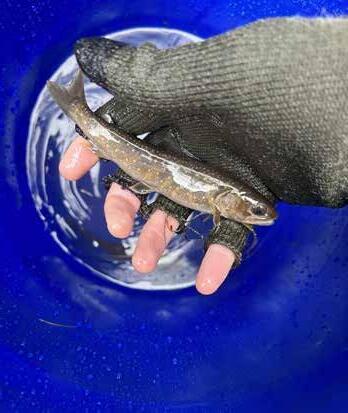
We spent the day working our way up the creek using a faint hunting trail, which wove through the warm pine forest. Grouse thumped from their hiding spots. Deer appeared and vanished. Life was returning to the burn, and as we left the trail to make our way down to one of our last stations, Wiley pointed out a nice calm pool.
“Good bull trout habitat,” he said.
This was some ideal real estate. It was partially shaded, cool, riffling. When migratory bull trout make their annual spawning migration, they almost always return to the same tributary in which they hatched. This homing to their natal streams is accomplished with remarkable precision. And yet here in the Land of Many Uses, the question over how the land would be used, of whether bull trout were even being given the chance to make it up this far, was being posed.
It’s an issue that transcends species and landscape – does the modern world have room for apex predators like bull trout? Do we value wild places for their own sake?
Science is working to help answer the ecological aspects of such questions. Joined with the voices and votes of the people who love wilderness, we have a shot at giving future generations the gift of this culturally, ecologically and spiritually vital species.
BHA member Paul Lask is a freelance journalist specializing in the outdoors, environment and science. He teaches community college writing and literature.

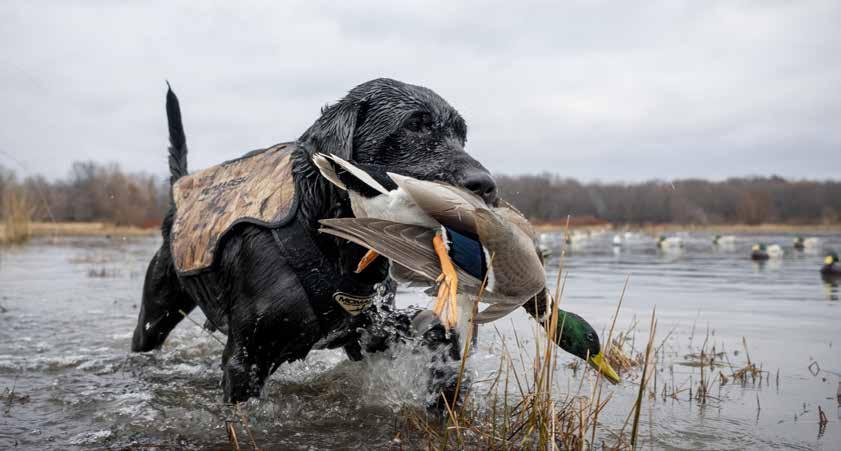
BY CHARLIE BOOHER
Much of our National Wildlife Refuge System is crumbling around us. The landscapes encompassed by the system are changing rapidly, but our collective capacity to manage wildlife habitat, address visitor concerns, provide necessary infrastructure and enforce rules and regulations in these places continues to decline.
System-wide, the NWRS is down at least 800 classified staff from fiscal year 2010 to fiscal year 2024. Discretionary appropriations have remained largely the same since then, as well, and inflation has continued to rise. Between FY23 and FY24, the U.S. Fish and Wildlife Service budget decreased by 4%. It’s not unlikely that the NWRS budget decreases by another 4% in FY25. And without necessary funding, workplans can’t be executed, visitor centers will continue to close, invasive species will continue to spread, and the mission of the NWRS will suffer. There’s no doubt that efficiencies can be improved, which will solve some problems; however, it is equally clear that more funding is needed.
First established by President Theodore Roosevelt in 1903, the NWRS was constructed “to conserve, manage and restore fish, wildlife, plants and their habitats, as well as provide quality wildlife-dependent recreational opportunities that foster wildlife conservation for the enjoyment of future generations.” The USFWS, the agency charged with managing the NWRS, is the oldest federal bureau dedicated to wildlife research and conservation. Further, USFWS is the only agency in the federal government that is primarily responsible for the management of biological resources on behalf of the American public.
Today, the NWRS includes 571 refuge units, which cover more than 95 million land acres in all 50 states and receive in excess of 67 million annual visits. Nearly three million of those visits include hunting and more than 8.6 million include fishing. Most
metropolitan areas are within an hour’s drive of a national wildlife refuge, each of which provide outdoor recreation opportunities that range from fishing, hunting and boating to bird watching, photography and environmental education. According to the latest economic surveys, NWRS lands support 41,000 jobs and $3.2 billion of economic activity every year.
According to USFWS, the NWRS “network protects some of the country’s most iconic ecosystems and the fish and wildlife that rely on them: prairies of the heartland, teeming with native pollinators and bison; hardwood forests of the Southeast, a source of regional and cultural pride; desert Southwest landscapes, home to vibrant and rare plant communities that draw new life during the summer monsoon season. The refuge system also conserves waterways that give life to all of them – critical ecosystems along rivers, streams, wetlands, coasts and marine areas.”
However, without adequate funding and resource management planning, none of this can happen, and the results of chronic underfunding and understaffing are already evident.
Michigan’s Shiawassee National Wildlife Refuge is operating at FY10 funding levels, which means that regular refuge operations, including invasive species control and habitat management, are significantly hampered. The list of deferred maintenance and upgrades to infrastructure and equipment continues to grow. North Carolina’s Pocosin Lakes National Wildlife Refuge and Red Wolf Education & Health Care Facility have both been forced to close to the public in the past five years due to a chronic lack of staff, which fails to serve the public or the mission of the refuge system. Tennessee’s Hatchie National Wildlife Refuge no longer has any personnel, and private philanthropic dollars are having to be turned away due to insufficient internal staff capacity. And equally concerning, Maryland’s Blackwater National Wildlife Refuge is threatened by rising sea levels and infrastructure adaptation is
hamstrung by a lack of baseline staff resources. The list continues to grow, and is likely impacting your hometown refuge, as well.
“As the only system of federal public lands focused primarily on wildlife conservation and habitat, the National Wildlife Refuge System requires a substantial increase in appropriated funding to effectively fulfill its conservation mission and provide opportunities for wildlife dependent recreation,” said BHA Government Relations Manager Kaden McArthur. “While visitation has increased 38% over the last 13 years, and the USFWS has been charged with two million new acres of land to manage and steward, the refuge system’s budget has only increased by 3% in nominal dollars. Inflation has rapidly outpaced that increase, leaving the professionals tasked with managing the system consistently shorthanded. As hunters and anglers, we need to give them a hand to get back on track.”
While it is critical that we continue to support the National Wildlife Refuge System, we must also ensure that refuges are being managed appropriately and according to the National Wildlife Refuge System Improvement Act of 1997.
In June 2023, USFWS promulgated a rule that facilitated public hunting and fishing opportunities on 48 new National Wildlife Refuge System units, bringing the total number of system units open to hunting to 436 and the total units open to fishing to 378. However, these expansions have come with additional regulations for hunters and anglers, including blanket bans on the use of lead ammunition and tackle. While sometimes these restrictions are
regulations relative to the biological integrity, diversity, and ecological health (BIDEH) of the NWRS. As proposed, these rules would eliminate agricultural activities on refuge system lands, ban native predator control and restrict the use of chemical vegetation management unless otherwise permitted. In practice, should this rule be finalized, the refuge system staff who are left would be spending more of their time filing paperwork than conducting habitat management projects, serving visitors and planning for the future; in short, these rules will hamper the ability of USFWS professionals to achieve the mission of the NWRS.
“We want to help the Fish and Wildlife Service however we can. Refuge lands are vitally important to hunters and anglers,” concluded McArthur. “However, we need to make sure that the Service continues to work with us in making the policies that guide the refuge system that our community has worked so hard to create and steward.”
BHA member Charlie Booher is a conservation lobbyist at Watershed Results LLC and holds degrees in wildlife biology, public policy, and natural resource conflict resolution from Michigan State University and the University of Montana. Outside of the office, you can find him hiking the mountains of Western Montana and relearning how to hunt and fish in the Northern Rockies.
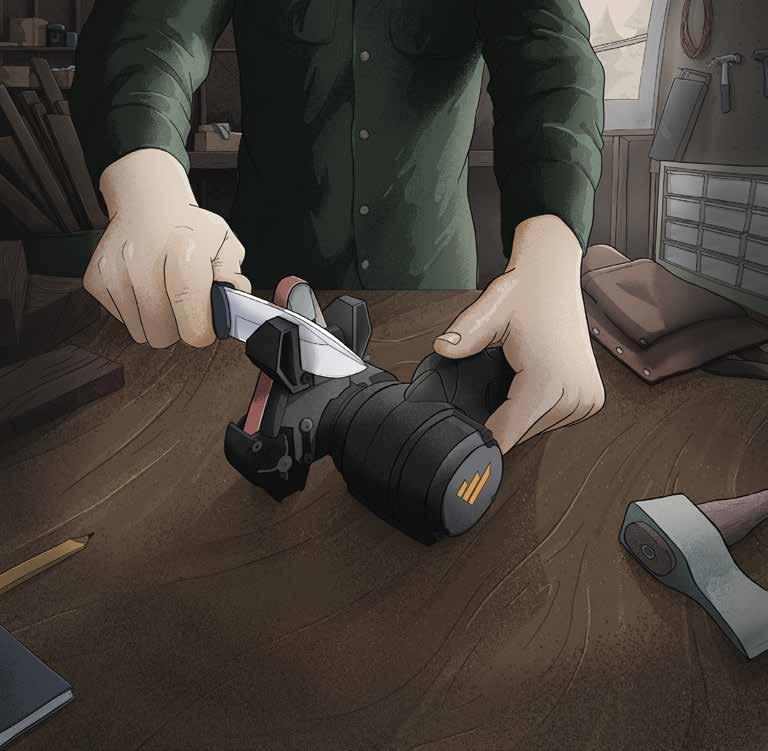
Experience shaving sharp edges on all your knives.
The KNIFE & TOOL SHARPENER Mk.2 is easy to use and delivers best-in-class sharpening for all knives and edged tools.
Sharper than the day you bought them.

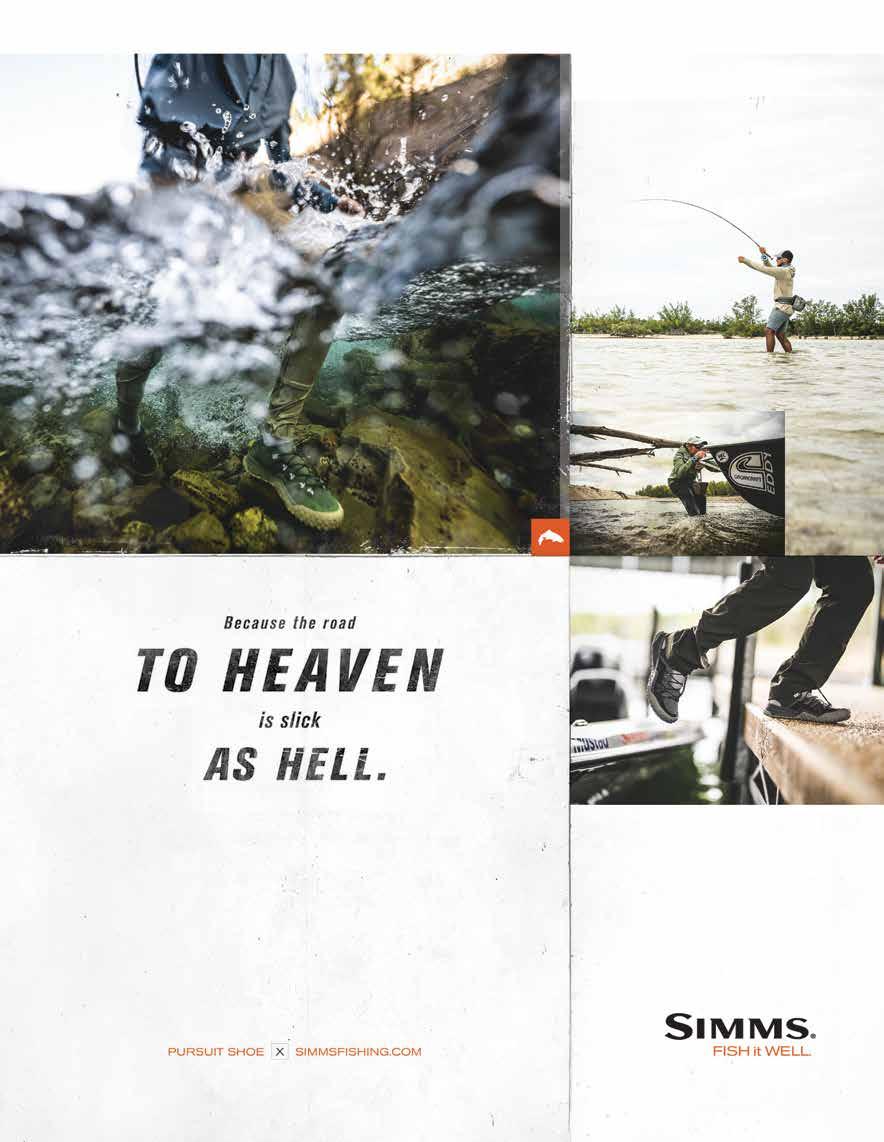
the hike. the hunt. the harvest. the adventure. the journey. the spot. the story. the meal. the catch.
the fearless
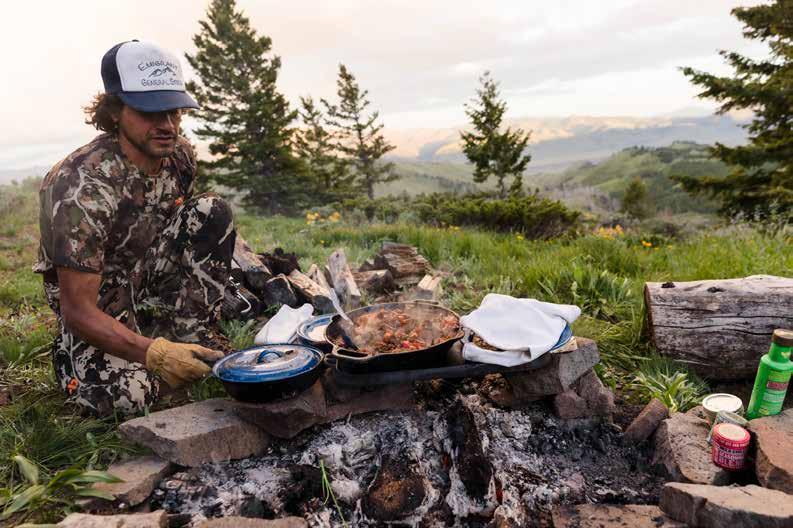
Get 10% off any order with discount code BHA10

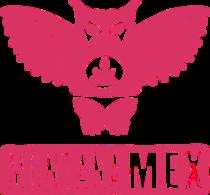


BY HARLEY McALLISTER
I’ve been on a number of week-long backcountry hunts. At first, the filth I was experiencing on my body was simply a minor distraction. But later, it grew to be a detriment to my state of mind and overall commitment to the hunt. I knew there had to be a better way, and I have since settled on a routine that has helped me not only on my annual hunts but also in my everyday life.
My growth in this area started with a distant female relative who happens to be a total badass. My wife’s aunt is Matty McNair, the first person to lead an all-women expedition to the geographic North Pole, and the first American to ski to both poles. As I read about her exploits, I learned some of the techniques she used and came away with a few ideas that can help all of us be more successful in the backcountry.
Background
The biggest lesson that I learned from Matty is that bathing – or rather, a lack of bathing – is something you can prepare for.
For most of human history, humans did not bathe every day. Or
every week. Or every month. Now, they also had a lot more health problems, but the simple fact is that today’s expectations in this regard go against most of human history. Today, most people wash every day using a wide range of chemical products to strip away sweat residue, oils and other things that our body produces through skin secretions from the sudoriferous (sweat) and sebaceous (oil) glands. Then, we use moisturizers and other products to try and put some of that back. In a way, it’s sort of a silly, self-defeating cyclical process.
But our bodies are amazing for the simple fact that they respond to stimuli, and we can train bodies to adjust to new conditions. This is what exercise is all about, but we can use this reality for other purposes, as well. If we start to wean ourselves off this process of stripping away and then replacing our skin’s natural moisturizing elements, the body will respond, and we can find a new equilibrium.
In short, we need to learn how to get by without showers. It’s not hard, but it does take some time. Starting at least a month in advance you will want to stop using soap on your body every day.
(You should still wash your hands with soap after using the bathroom.) Begin by continuing to shower on your regular schedule, but start skipping the soap with every other shower. After a week, try using soap only every third shower, and then ramp it up by only showering every other day.
I can imagine you recoiling at the thought of being filthy and losing friends who no longer want to be in your presence. But trust me that your body will respond by secreting less material, and you will strike a new balance.
I won’t try and recommend a specific regimen for exactly how to do this. I am pale and freckled, have very short hair and live in a dry climate, and your skin and hair are different than mine. It also depends on activity – the day you go for a 10-mile run might not be the first day you want to try skipping a shower. Your experience will vary, but challenge yourself to try showering, and especially applying soap, less frequently. One helpful aid in this process is to use a micro-fiber wash cloth. Wiping yourself with one of these does a better job of removing unwanted elements than simply spraying with water alone, but it still avoids the negative effects of chemically attacking your skin.
By the time that I am ready to go on my week-long adventure, I am typically showering only a couple times a week and using soap once a week. In fact, year-round I no longer shower daily, and I feel my skin is healthier for it. And yes, my wife still lets me sleep in the same bed that she does.
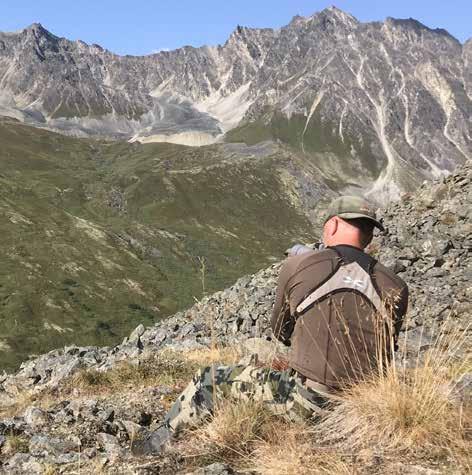
clean in your mummy sack instead of feeling like a pile of dirty gym socks in a laundry bag.
Once you are in the field and working hard, wet wipes are your new best friend. However, they can be hard on the environment, so be careful to choose some that are truly biodegradable. There are a few brands out there that are designed specifically for this application rather than a baby’s bottom; they tend to be a bit larger in size, and they start to break down within just a few weeks.
For my typical regimen, I plan on using two wipes per day. One wipe is reserved for going potty. I take along toilet paper to do most of the wiping, but then I finish with a wet wipe to ensure that I am really clean before I resume activities. Everything gets buried appropriately, and I’m on my way again refreshed.
The second wet wipe is reserved for the end of the day as I prepare to get into my sleeping bag for the night, and it follows a certain progression down the slope of nastiness. You might choose a different routine, but I suspect you won’t stray too far.
I start with a clean wet wipe and use it to clean off my face, neck and ears. Next, I take this same wipe and use the other side to clean off my armpits, before switching sides again and heading down to the nether regions to do a little clean up in that area. I don’t mind if I transfer a little face sweat to my crotch, but I definitely don’t want the reverse to happen! Finally, I use this cloth to clean out the areas between my toes that have been carrying me through the mountains all day, then dispose of it appropriately. A single large wipe can do a lot of cleaning if managed properly, and you’ll go to bed feeling
Another helpful item when planning for extended stays outdoors is a second stick of anti-perspirant. I have a special stick of odorless anti-perspirant that is used for nothing else, because it goes where no anti-perspirant has gone before. Right before I leave, I take my final shower, and then I apply this anti-perspirant to my groin area. It seems to last for at least the first two to three days, which gives me a great head start in keeping things pleasant while I’m out there. Try it, you’ll like it. Just make sure you mark this stick well with danger labels so that some unsuspecting person in your household doesn’t borrow it on accident.
Conclusion
The steps outlined above are easy to implement and should go a long ways in helping you be more comfortable, and more focused, on your next backcountry excursion. With a little bit of preparation, and a few inexpensive modern conveniences, you will find that your outdoor adventures can focus more on the beauty of nature and less on the stink it took to get you there.
BHA member Harley McAllister is a board member for Orion, a longtime outdoorsman and a devoted father to eight children. He and his wife Abby have written a series of guidebooks for families planning vacations to the national parks called Adventuring with Kids.
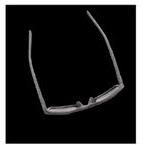





































































































BY JAMIE CAMERON
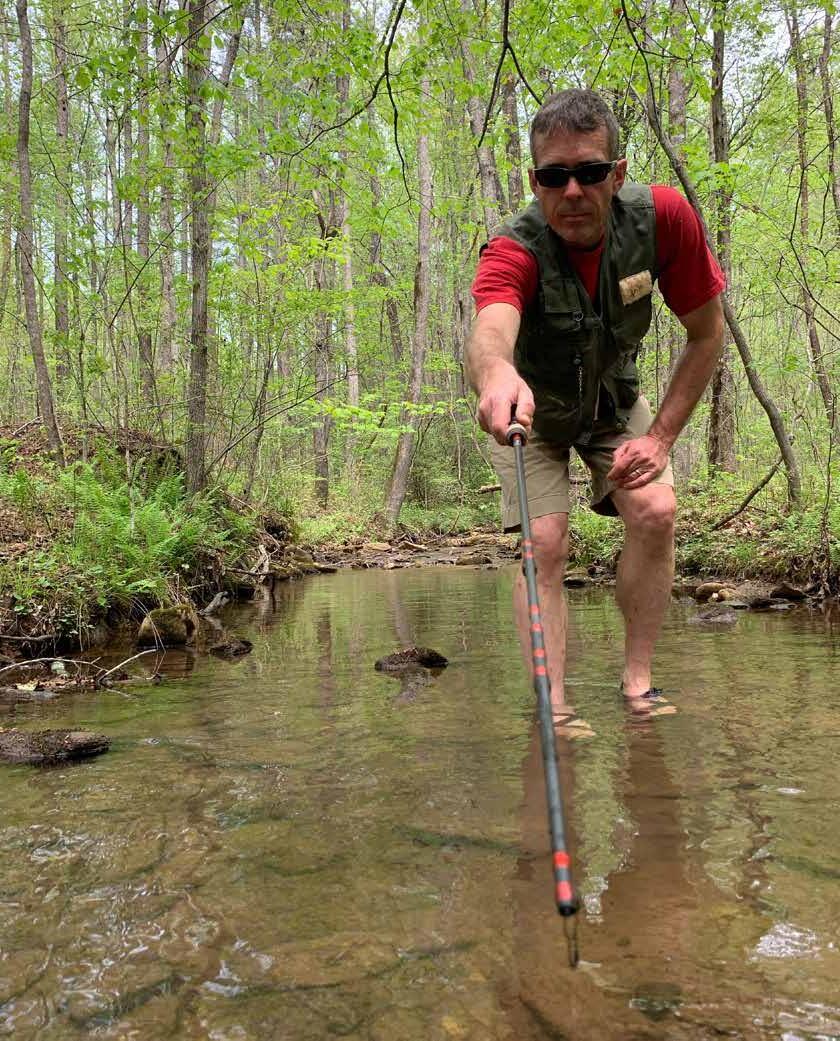


There’s a new breed of outdoor recreationist hanging around fresh and saltwater public access points across the country. Maybe you’ve noticed them. They look like your typical angler but something’s off. They carry quivers of stubby little rods, no reels. They take lots of hero shots, but it seems like they’re just taking pictures of their own, empty hands. They could be serious biologists with their mutterings in Latin and waxed-canvas shoulder bags, filled with clear plastic vials, magnifying glasses and field guides, but there’s too much highfiving and a decidedly unprofessional amount of cussing. If you haven’t bumped into them yet, you soon will. Social media
accounts, chat rooms, forums and websites dedicated to the angling world’s newest obsession are popping up all over. It’s called multispecies fishing, and it might just change the way we think about the aquatic environment and how we place value on the creatures within.
Multi-species fishing is the pursuit of all fishes great and small, for the purpose of ticking off as many different kinds as one possibly can over the course of a day, a year or a lifetime. A multi-species angler keeps a roster of all the fish they’ve caught, called a “life list.” Unlike conventional fishing, where the quest often focuses on the longest or the heaviest, multi-species anglers get excited about rarity and level of difficulty. The vast majority of North America’s 1,000





or so species of freshwater fish have long been categorized as bait – or are too small to even be bait. These are the micro-fish that separate the casual multi-species anglers from the seriously afflicted. Many of these fish are spectacularly colored, rivaling the most splendid tropical reef species, and they’ve been living unappreciated in your local creeks and rivers, right under your wader boots.
The idea of seeking out and identifying the thousands of fish species that swim in our public waters is catnip to me. I’ve been consumed by a similar fascination with birds for more than 45 years now, so this multi-species fishing thing is right up my alley; it’s birdwatching for fish. This is how I found myself wading calf-deep in the cool, clear waters of western North Carolina’s South Toe River last summer with a couple of hardcore anglers who’ve taken to multi-species fishing with a passion that makes my bird obsession seem comparatively quaint.
Tim Boyer is the president of the Western North Carolina Muskie Club, but on that morning he handed me 36 inches of the butt end of repurposed fiberglass flyrod with a scant length of tippet material tied directly to the tip. It was rigged with a hook so small it was hard for me to see, and a seemingly oversized split shot crimped half an inch above it. Tim’s target species for the day was his “lifer” banded darter, a member of the bottom-dwelling family of freshwater fish that often prefer fast moving riffles, where they lie in wait underneath rock ledges for bits of food to whip by.
“Where these darters prefer to live, the current is too strong for the springy end of a conventional fishing rod. You need to be able to place the bait within three inches of his face and hold it there,” he explained.
With that, Tim handed me the bait – a 2-inch section of gas station red wiggler, curled into a snuff can lid. “That should last you all day,” he said straight-faced. “Use these nail clippers to cut a tiny donut of worm and thread it onto the bend of the hook with these hemostats. If you think your bait is too small, it’s probably still too big.”
With that, we were off. Joined by Tim’s microfishing mentor, Ryan Patrick Sonier, we waded three abreast, peering down in front of our feet in water depths from six inches to three feet, for fish that might stretch the tape as long as your pinky finger.
The rise of multi-species fishing has opened up vast new possibilities to anglers from around the world. No longer must anglers restrict their efforts to the “game” species, crowded boat ramps and expensive tackle and technology. The gear can be as simple as a salvaged rod pulled out of a
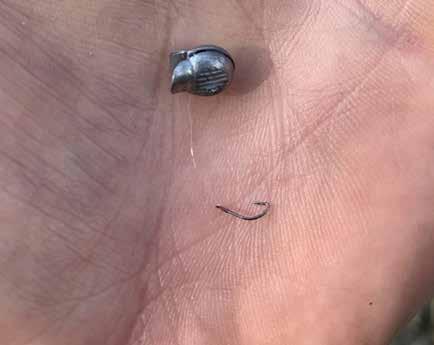
Figuring out where these fish live and how to get them to bite forces the multi-species angler to think about habitat and fish behavior.

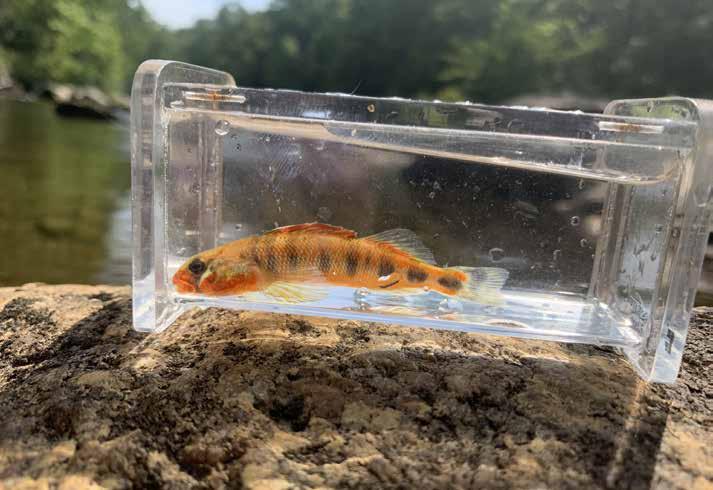
The southeastern U.S. is home to the highest freshwater fish diversity in North America. Alabama holds the title for most native species found within a single state, an astonishing 325.
dumpster, a spool of light leader material, a container of split shot and a box of size 22-28 hooks from the fly shop. Shallow wetlands, tiny creeks, swamps and roadside ditches can be home to some of the most reclusive species on the continent. Figuring out where these fish live and how to get them to bite forces the multi-species angler to think about habitat and fish behavior. It’s a short cast from being a casual angler to becoming an amateur ichthyologist, and “geeking out” on micro-habitats, morphology and taxonomy is part of the fun.
Tim pointed out a school of small minnows following in my footsteps as I crossed a sandbar. “Those’ll be Tennessee shiners. You’ll end up hating them eventually because they’re so aggressive it can be hard to get your bait down to a target species, but they’re a good way to practice your technique and get your list started.” I dropped my microscopic worm bagel into the scrum and watched it get swarmed immediately by the 1.5-inch predators. I lifted the rod tip and a tiny, wriggling, bright silver fish came to my hand. Tim was quickly at my side to offer a dehooking demonstration and a clear plastic container the size of a box of rifle cartridges for getting pictures. Photos are important for documentation and identification that might require several angles and close scrutiny
back home with an open field guide or posting to multi-species forums with expert advice. With that catch, I was on the board.
The southeastern U.S. is home to the highest freshwater fish diversity in North America. Alabama holds the title for most native species found within a single state, an astonishing 325. If you include saltwater, and multi-species fishing definitely includes saltwater, the number then grows by 100. Every spring and summer, more and more multi-species anglers make road trips to the Southeast to fill in the gaps of their life lists: Tallapoosa bass, Carolina madtom, redfin pickerel, American brook lamprey, tangerine darter, warpaint shiner, notchlip redhorse … you get the picture. But regional specialties occur all over the country. Anglers in the West can expect quite a different array of species in their river drainages from those listers in the Northeast. When you consider saltwater ecosystems and the incredible diversity of the oceans, you can easily see why a serious multi-species angler might find their own version of heaven sitting on a concrete bulkhead somewhere on the Gulf of Mexico with a half pound of fresh shrimp and a sabiki rig.
A couple of hours into my inaugural multi-species venture and things were going well. I’d caught both green-fin and gilt darters, river chubs, a rock bass and a fingerling smallmouth, but I’d
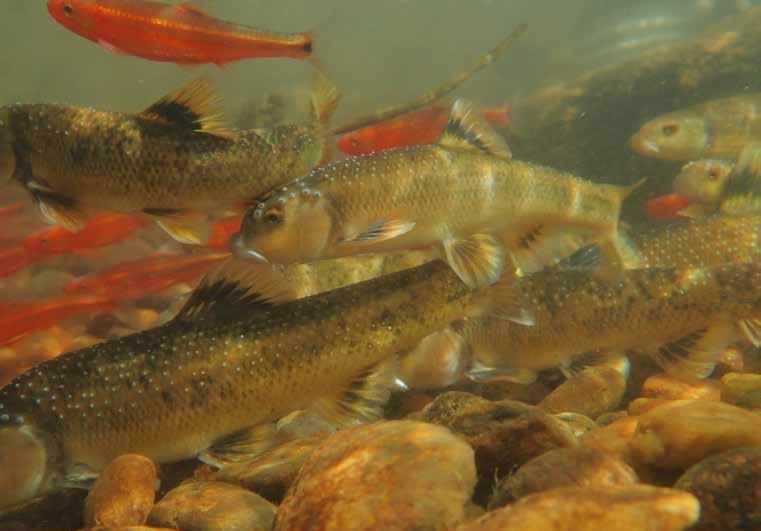
lost track of my companions. On the opposite side of the river I spotted Ryan, crouched motionless, like a great blue heron waiting to strike. His wiry figure contorted into an impossible pose as he held a bait in front of a tiny rock crevice. It took longer to find Tim, but eventually I noticed him dead-man floating in mask and snorkel. He’d switched to a rod the size of a sorcerer’s wand and later explained he’d found several banded darters on the bottom. “Snorkel fishing, man. It’s a thing,” he shrugged.
Over the next several hours, Tim remained resolute in his ambition to catch a banded darter. His single-minded focus on the darter (which stretched into six solid hours) was a testament to the potential effect this growing interest in fishes other than traditional gamefish might have on anglers and how state fish and game agencies allocate funding and management. A plurality of our native fish populations are declining for all the reasons we know almost by rote: channelization of rivers and streams, pollution, rising water temperatures, more frequent flooding, human encroachment, sedimentation, pesticides, dams and so on. But those declines and extirpations have been happening in a vacuum – nobody noticed aside from a few dedicated freshwater aquatic biologists. With new interest spearheaded by amateur anglers and naturalists looking for something a little different, fisheries biologists have a public invitation to focus more of their attention, and budgets, on these declines.
By the time the afternoon sun had fallen behind the trees, my day in the river had left me tired and cold. I thanked Tim and Ryan
for their guidance and patience and wished them luck. Neither one of them appeared to be ready to leave anytime soon. As I turned to head up to the road where I’d parked, I thought about the river and all its micro-habitats that the different species depend on; I’ll never look upon a body of water as a homogenous environment again. Aquatic life requires a diversity of habitats that only healthy waterways can provide.
An elated shout from the middle of the South Toe brought me back. Tim had finally caught his darter – a slim, snub-nosed fish with bold vertical bars on its flanks. He seemed as excited with the 2.5-inch minnow as he’d have been with a 45-inch muskie. Suddenly I didn’t want to go home anymore. Suddenly, I wanted to stay and try to add one more species to my list.
BHA life member Jamie Cameron is a North Carolina State Parks ranger. As such, his duties include natural resources management, law enforcement, search and rescue and wildland firefighting. His passion lies in opportunities to educate young people about the outdoors and teach them to become stewards of the land.
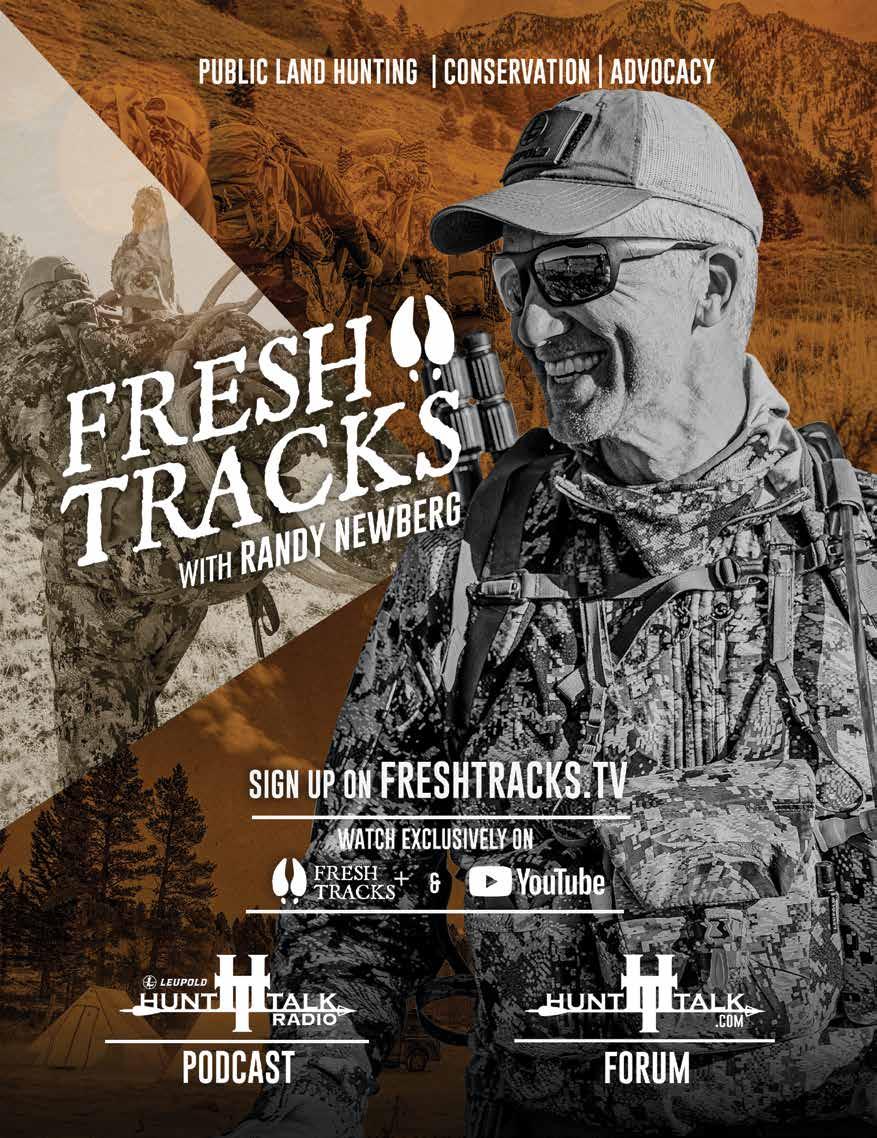

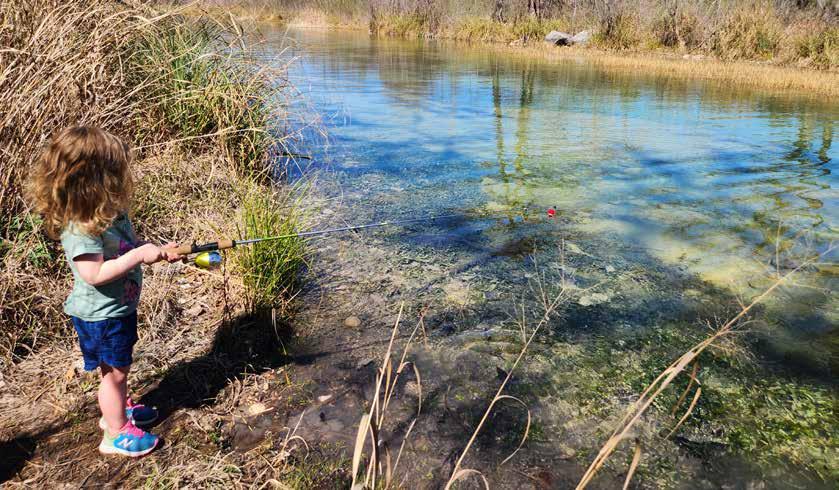
BY K.C. HUXTABLE
I’m standing under a 300-year-old cypress tree along a riverbank. It’s a comfortable 72 degrees in the Texas Hill Country, and cold, clear Frio River spring water flows from around a bend on my left. My family is fishing in the busiest of our 88 state parks, fully cognizant of our luck in snagging a campsite just three days prior. Texas ranks 35th in state park acreage per capita, and fate plays the biggest role in securing a last-minute reservation.
My gaze shifts toward my feet where my son, fishing pole in hand, stares intently at a dot on the surface of the water, floating away from us. His bait, again. Casting is a generous term. He insists on independence but lacks almost all hand-eye finesse. His bait, once guided by rod, line, sinkers and hook, takes its own independent path, now on its own, floating down the Frio.
As parents, my wife and I try to instill an appreciation for the outdoors as foundational to how we’re raising our kids. Although part of our motivation for this is to teach life lessons like patience and endurance, our kids just want to have fun, and on this trip our son just wants to catch fish. I’ve set the expectation that we may not catch anything, that luck plays a role, and that the fish maybe just aren’t hungry, which are all truths. But, I also want him to get hooked into the sport, to have a hunger for our next trip and to develop a passion that one day will circle back to him as an adult teaching me something about life by taking me fishing. Yes, there’s a selfish element there; I’m aware of that. But I’m only human.
“Daddy, look!” My son’s words snap me back into the moment.
The Texas Parks and Wildlife Department stocked the Frio just a few weeks prior, and sure enough, he sees a decent-sized rainbow trout flanked by smaller brothers and sisters just a few feet off the riverbank. We cast in their direction, but they don’t seem to care. We switch up bait. We try a lure or two. They retreat from the casting splash, then return with as much interest in our traitorous treat as a 4-year-old has in fine caviar. I’m sure it has nothing to do with my son who’s throwing rocks in the river to see the water splash. But that’s OK because seeing the stocked trout re-stocks my son’s motivation. We walk away empty handed, but I remind my son, “Now we know there are fish in the river, and maybe tomorrow they’ll be hungry!”

Despite living in a state known for its small amount of public land, my family and I can enjoy these moments because of a growing appreciation among Texans for lands and waters held in public trust. Understanding Texas’ legacy of private land ownership requires a nuanced understanding of how Texas joined the union as the 28th state in 1845. Unlike most western states – which transferred large chunks of public land to the federal government, free of charge, to meet conditions of statehood – Texas maintained ownership of almost all land not otherwise owned by individuals or businesses. The legislature, understanding the revenue-generating potential of land sales and misunderstanding the value of its natural resources for the common good (especially in western Texas), sold much of this land to private entities. Thus,
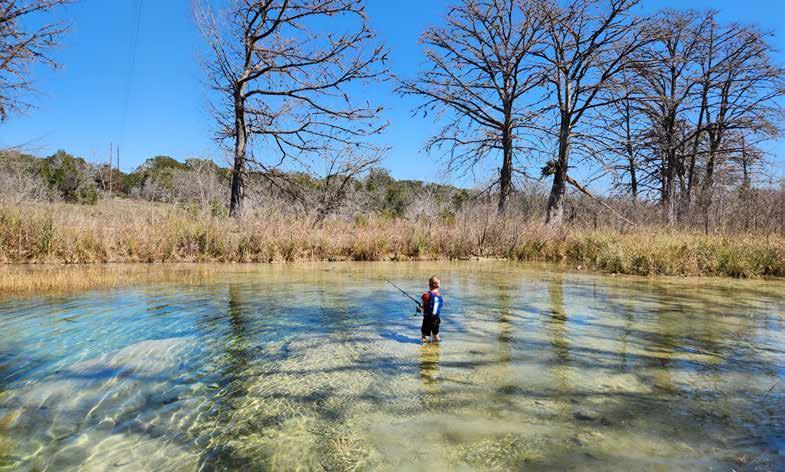
The good news: Texas voters just gave TPWD a massive win for conservation and public land on the 100th anniversary of the Texas state parks system, a win that provides a steady funding stream to acquire and develop new public land for generations to come.
from its founding, private landowners dominated the landscape in the Lone Star State. With less than 5% public land today, many of our natural resources are still guarded by private interests. Wildlife and wild places are often capitalist money-making ventures, and outdoor recreation in many forms is a pay-to-play pursuit characterized by leases, access agreements, high-fences, exotics and luxury wildlife “experience” excursions – all on private ranches. Add a growing outdoor-hungry population exceeding 30 million Texans, and our per capita public land deficit sinks deeper every day.
The public opportunities that do exist are in high demand, and are therefore limited, to keep access and use sustainable. Many state parks offer draw hunting opportunities to manage wildlife populations, but these are limited in number and often extremely regulated. TPWD also runs a robust trout stocking program that provides over 365,000 trout opportunities in lakes, rivers and ponds throughout the state (the same trout my son and I targeted). Getting to these waters can be difficult, however. Although navigable streams in Texas are public and therefore open to “navigation, fishing and other lawful purposes,” entry points to these waterways can be difficult to find because of the sheer amount of private waterfront property. The Guadalupe River, rated one of the top 100 trout streams in America and stocked annually by TPWD and the Guadalupe River chapter of Trout Unlimited, has only one public access site within the special
“trout zones” and one leased public access site just downstream from the zones. Unless you “know a guy,” you’ll be paying an access fee.
That’s bad news for public land seekers.
The good news: Texas voters just gave TPWD a massive win for conservation and public land on the 100th anniversary of the Texas state parks system, a win that provides a steady funding stream to acquire and develop new public land for generations to come. In November 2023, Texas voters overwhelmingly passed Proposition 14, a bipartisan constitutional amendment to create the Centennial Parks Conservation Fund. This $1 billion endowment fund, created entirely from a budget surplus, levies no additional taxes onto Texans yet enables TPWD to acquire and develop new state land from willing sellers.
That’s the key verbiage that led to such widespread support for Proposition 14 in a state weary of perceived land grabs: from willing sellers
In short, it’s a two-part equation: Proposition 14 provides the cash; willing sellers provide the land.
In 2023, over 90 organizations across conservation, business, agriculture and recreation sectors joined hands to advocate for Proposition 14 under the Texas Coalition for State Parks. Among these supporters were several local and regional organizations, but rounding out the pack were national heavy-hitters across a broad spectrum of environmental advocacy backgrounds – including
REI, L.L. Bean, The Nature Conservancy, Audubon Texas, Defenders of Wildlife, Ducks Unlimited – Texas Chapter and the Lone Star Chapter of the Sierra Club. BHA provided grassroots advocacy to support Proposition 14.
And it couldn’t have been timelier. Just months before the ballot measure, TPWD lost its lease on Fairfield Lake State Park, a 1,400-acre recreational area providing camping, fishing, horseback riding and wildlife viewing opportunities to over 80,000 people per year. The landowner got the best price possible when they sold the acreage for tens of millions to a developer for a luxury gated community, complete with a private golf course. TPWD briefly considered eminent domain to retain the property but eventually withdrew the proposal due to potential public resentment. Now, what once provided outdoor recreation opportunities for hundreds of thousands of Texans will be bulldozed to accommodate wealthy private landowners. Fourteen other Texas State Parks are also leased and therefore susceptible to loss.
The ballot measure passed in November sets TPWD’s conservation efforts on a path toward expansion, but Proposition 14 isn’t a magic bullet, and public land acquisition won’t happen overnight. TPWD is already developing six parks, including the 40,000-acre Chinati Mountains State Natural Area, under state ownership since 1996 with no projected opening date. The 1,700-acre Davis Hill State Natural Area provides access to the Trinity River just outside of Houston and has been under state ownership since 1983 yet is landlocked by private property and therefore inaccessible. In 2021, TPWD acquired the 2,253acre Powderhorn State Park along the Texas coast, which will provide camping, fishing, hiking and birding opportunities when it opens.
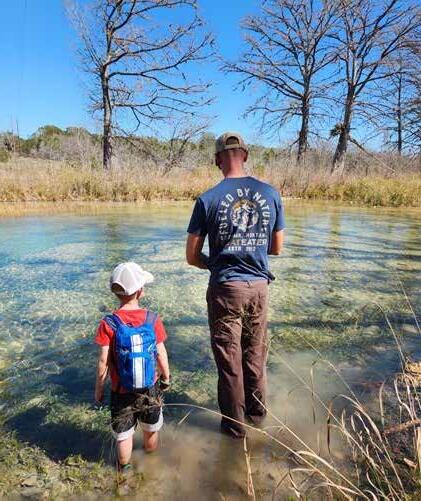
Developing a state park is time and resource intensive and requires negotiations, contracts, environmental surveys, use agreements, easements, infrastructure development, state and local government engagement, public comments, hiring and more. In simple terms, it is hard and takes a long time. Proposition 14 passed with a huge majority, 79% of the vote. This means more than just the start of a gradual process to rebalance the public-private land ratio beyond our measly 5%. It also means that the vast majority of Texans are supportive of the wildlife and wild places we hold dear. Texans spoke loudly in favor of public land: They want more of it.

We’re done with lunch – peanut butter sandwiches on a rock under a tree in our Texas public land – and we grab our poles. One more chance before we head home to close out our weekend. We follow the path down to the river, a different spot further upstream. We do a little scouting. Sure enough, I find a small group of fish, several small and one larger. I excitedly tell my son, and we both step out on a submerged limestone ridge to get a good cast. I cast – nothing. I cast again – nothing. I cast a third time – bite. Hookset. I immediately hand the pole to my son to reel, and he does so with vigor and a smile. I remove the rainbow Kastmaster from the eight-inch spotted bass’s mouth and show
my son how to hold a bass, his first. Without hesitation, he places his thumb on the lip and holds it up for my wife and daughter to see. Then, a gentle toss back into the river and another big smile. He’s happy. We’re all happy. He caught a fish, and he wants to do it again. Maybe these two days taught him something about patience, endurance and luck, even if he doesn’t realize it. These lessons are the magic of outdoor pursuits – adventures we can take as a family because we have access to public outdoor spaces.
Although it takes a bit of planning to access Texas’ wild spaces, it’s possible. Our public land reputation isn’t the greatest, but Texans spoke in 2023. We said we value public land and wildlife. We said we want more of it. And now, more is on the horizon.
BHA member K.C. Huxtable is a father, a husband, a Marine and a lifelong student of the woods. He values every minute in the outdoors, but prefers those times when his family and friends are by his side. Connect on Instagram @huxman_outdoors.
The opinions expressed are those of the author alone and do not reflect those of the U.S. Marine Corps, the Department of Defense, or any part of the U.S. government.
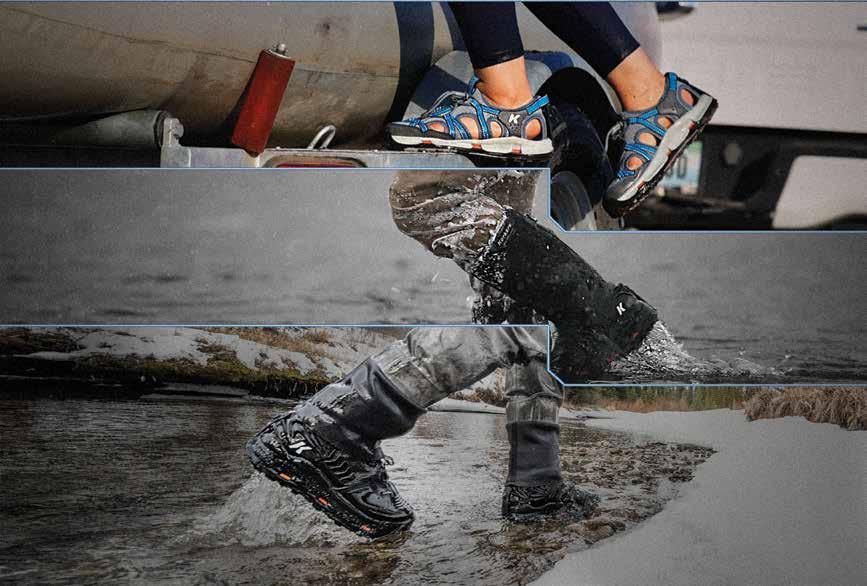
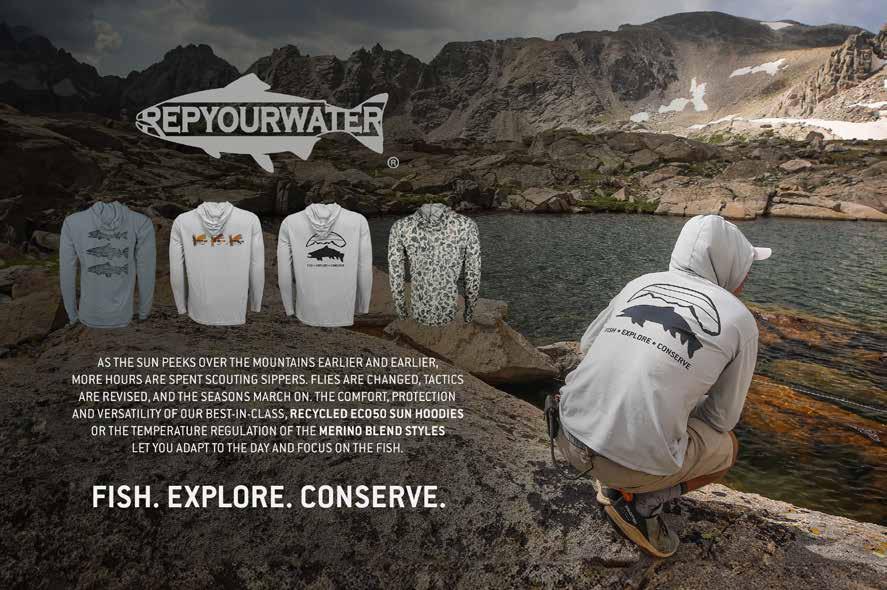



BY MICHAEL DREW
Many years ago, in the heart of Northern Michigan, my younger days were painted with endless hours exploring the woods, each season offering its adventures. My parents, recognizing my innate explorer’s spirit, granted me the liberty to immerse myself in nature; their only request being my presence at the dinner table. Within the forest’s embrace, I crafted realms of my own: forts meticulously built from sticks, hidden bunkers, bridges that spanned swamps and marshes.
into recurring dreams, where I’d find myself narrowly escaping its pursuit, reaching my front door with but a moment’s grace before the bear’s looming presence.
Photo: Michael Drew
Upland birds, small game and deer were my fellow companions among the hardwood forest and swamps I frequented. I found challenge in stalking those animals. The peak of my accolades involved getting within 15 yards of a bedded buck before startling him. As the mature eight-point stood up, a surge of anxiety washed over me, wondering what he might do next.
Yet, the fleeting fear of that buck was eclipsed by the awe and respect I reserved for the true monarch of the woods: the American black bear.
During my formative years, the black bear held a place of profound reverence in my heart. I was enchanted by its formidable prowess and sheer strength. This admiration occasionally translated
Nature has a remarkable way of restoring balance, even when we endeavor to bend it to our whims. Alter a river’s course, and witness how it gracefully meanders back to its harmonious state. Disturb a forest, and in time, it rejuvenates, brimming once more with intricate ecology and biodiversity. In the same vein, a child raised by the woods will inevitably feel its call and return to its embrace.
For me, like nature’s tendency to reform back to its design, after time away building a career in marketing, I felt the draw back to what had never truly left – a need to be in the woods. As a boy, I once roamed a forest a few hundred acres in scope whereas I now found the opportunity to enjoy the three million acres of public land in the Natural State of Arkansas.
This brings me to the story of a bear named Tyson. The Ozark National Forest in Arkansas offers a growing and healthy population of black bears. For years, I’d dreamt of bowhunting them on public land. It was a bear encounter during a backcountry deer hunting trip
The hunt would underscore the wisdom in trusting your instincts.
in the fall of 2022 that turned dream to reality.
Having immersed myself in books, articles, and podcasts, and after seeking wisdom from seasoned bear hunters and engaging with state biologists, the path forward began to illuminate. Together, my hunting partner Luke and I meticulously studied maps and traversed mountain terrain in search of sign, a quest that often left us only with bug bites and drenched in sweat. Yet, our determination never wavered, leading onward to the inaugural week of Arkansas’ 2023 black bear archery season.
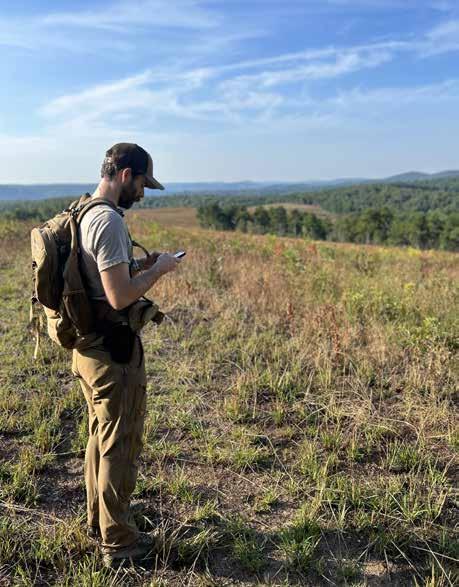
my inaugural bear hunt, and I had spent a mere two hours perched above.
It felt too miraculous to be my story. Yet the euphoria soon collided with an arduous two-day quest.
In what felt like a mere heartbeat, there we were, perched high in trees, a few hundred yards apart on a mid-September morning – the first light of dawn still an hour away. Every scouting session, every moment of study and every shot we had practiced throughout the year converging on this moment.
After just a couple serene hours observing deer and other wildlife foraging below, a text from Luke interrupted the tranquility – a message that would forever remain etched in my memory: “I’ve got a bear heading your way.”
My heart raced. As I reached for my bow, I harbored doubts: Could I really find a bear on public land without the aid of cameras or bait? But Luke’s eyes hadn’t deceived him. A robust, chocolatecolored bear ambled down the trail.
Pausing broadside, 40 yards from me, it began foraging. I aimed, recalling my hours of practice, and loosed my arrow. I marked the spot where the arrow struck and watched the bear dash, its retreat echoing with a final, haunting death moan in Luke’s direction.
Descending from the tree, I grappled with the surrealness: It was
Luke and I convened; the next steps uncertain. Forty-five minutes later, finding my blood-covered arrow provided a glimmer of hope.
That Saturday was an education. It defied belief: How could a grievously injured bear bleed so little, making tracking feel like an inscrutable puzzle?
The hunt would underscore the wisdom in trusting your instincts.
As hours of searching waned, doubts infiltrated. Had I erred in my shot placement? The bear’s absence loomed larger with each passing moment, leading us to the tough decision to retreat.
The following morning, after a sleepless night and discussion after church, Luke and I were united in our belief: There lay a bear in the woods, awaiting discovery. My neighbor had suggested watching for circling birds – a hint that soon became pivotal. Reviewing our map, we noted a stretch of creek drainage previously overlooked. As we explored, several blackbirds took flight, prompting a renewed determination. Descending the rugged terrain, a cliff edge loomed ahead. I peeked over, and there he was.
The joy in my eyes relayed the news before words could. Embracing Luke, we approached the bear – its magnitude even
Tyson, the chocolate phase black bear, became not just a symbol of my return to the wild, but a guide leading me back to the essence of who I am and reigniting the fires of fascination and respect for the magnificent creatures with whom we share our world.
more striking than in our memories.
We felt privileged in touching the bear’s brown fur, observing the creature at close range and truly understanding the unique allure of these magnificent bears. With its lustrous brown coat, formidable paws armed with sharp claws, and a regal demeanor, he was a sight to behold. Sharing this profound experience for the first time was a cherished honor. We christened the bear Tyson due to a partially severed ear and scars etched across his body — testaments to prior encounters, perhaps with stray arrows or skirmishes with other bears, battles in which he evidently emerged victorious.

As Tyson lay there, a testament to the raw yet enthralling tapestry of life and the deep connections that are forged in the heart of the forest, I couldn’t help but be transported back to those childhood days, running freely among the trees, a young explorer learning the ways of the woods. Tyson, the chocolate phase black bear, became not just a symbol of my return to the wild, but a guide leading me back to the essence of who I am and reigniting the fires of fascination and respect for the magnificent creatures with whom we share our world. As I stood there with Luke, a kindred spirit in this journey, I knew that this encounter, both harrowing and profoundly beautiful, would be etched into our minds forever.
With the forest as our witness, we silently thanked Tyson and the Lord for granting us the privilege to venture deeper into the
mysteries of the wild and for rekindling the primal connection to the land that hums in our veins. As we ventured back home, the forest seemed to acknowledge our journey, offering a silent salute to Tyson, the warrior bear with the battle-scarred ear and a spirit as untamed as the winds rustling through the oak leaves. With full hearts and a story that spanned childhood dreams and adult realizations, we promised to carry Tyson’s story forward – a timeless tale of reverence, resilience and the complex, yet beautiful web of life that binds us all to the great, pulsating heart of the wild.
BHA member Michael Drew, a devoted outdoorsman, has been hunting and fishing his entire life. He lives in central Arkansas with his wife and four children.
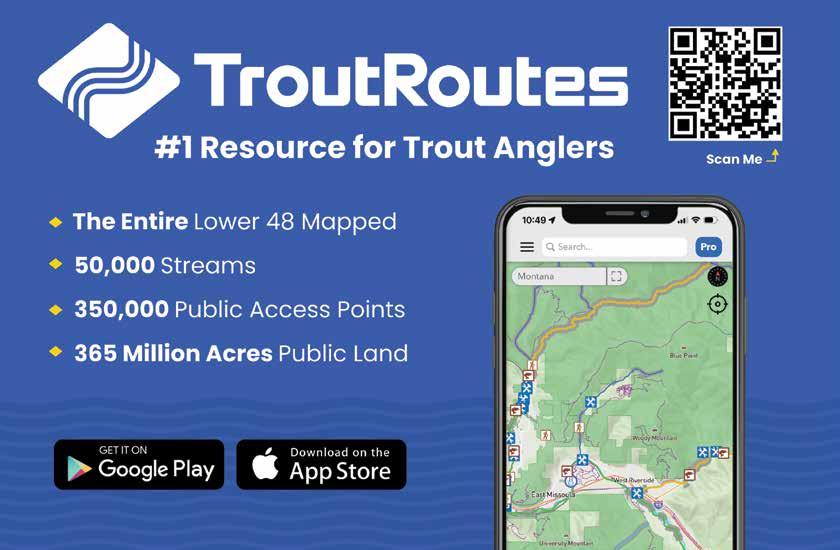
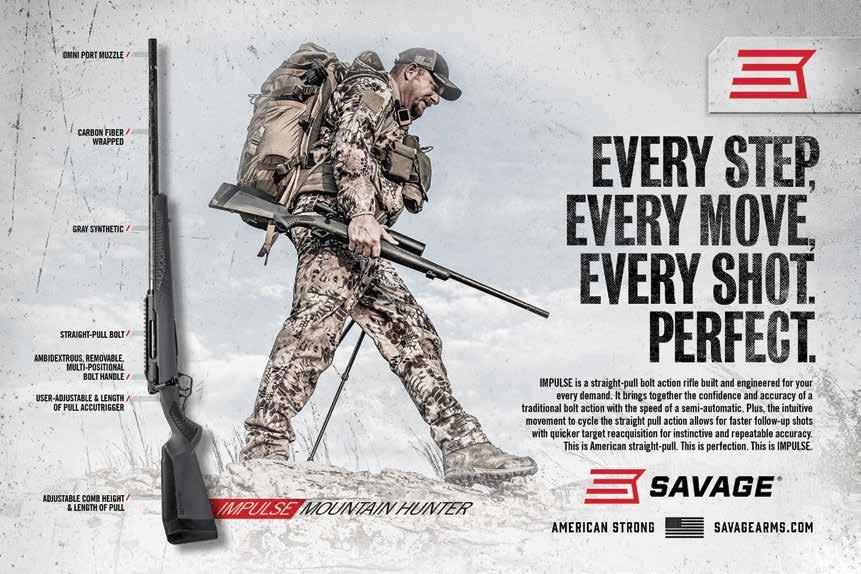


BY HEATHER E. GOODMAN
My dad, ecstatic when he turned 12 and gained his hunting license, skulked the woods, creeks and mountains of Pennsylvania for over a decade – and then before boot camp and Vietnam, he laid down his gun and did not pick it up to hunt again.
Until October 2006. At the edge of a dried-out cornfield in Turtle Lake, North Dakota, my parents joined me, my husband Paul and Paul’s extended family for an annual pheasant hunt on the farmland Paul’s dad grew up on.
At nearly the same moment, my brother Travis – who has lived in Wyoming since 1999 and had never before hunted – learned to hunt elk with a buddy.
Both men fall in love. One with pheasants going off like popcorn and deer hooves racing past in the next cornrow over, the other with bugling elk crashing through aspen and pine as owl hoots fall from the sky.
Years pass. Paul and I meet his family and my parents up in North Dakota for another hunt. Then, Dad, back at home in Pennsylvania, begins hunting deer with his friends from Trout Unlimited, trekking hills of pine, oaks and brambles that roll
to a low creek. Travis learns to call elk on his own, begins to understand their language, intuits where they most want to be and switches to bowhunting.
Paul, his father Cal and their uncles and cousins continue to improve the land and the cabin they’ve built on an old farm in upstate Minnesota. Spruce Creek: 300-plus acres of lilting fields, tracks of birch and scrub oak and a dark, sweet creek slipping through spruce and tamarack. Paul’s brother Seth flies in from Queens for hunting weekends. Paul’s sister kills her first turkey there; I try, but fail to do the same. We gather for hunting and non-hunting weekends, watch the new seedlings grow and discover antler sheds in the spring.
The years are good. The cabin in Minnesota is completed, and the trees and grasses the family has planted have improved the diversity of the land and the deer habitat. Paul’s family invites my family to visit Spruce Creek, and they fall in love with it, too.
These invitations – to corn and soybean fields, birch and oak ridges, pine and bramble slopes, aspen and lodgepole mountains – are the opening of hearts, the inviting in, the sharing of greatest joys.
My dad and his friends preserve more stream banks and plant
The invitation: Be under wide-open sky with me; study tracks in the mud. Listen, be still with me.
more riparian buffers, and the deer seem to reward them for this. When Paul and I move to Pennsylvania, Dad and friends invite Paul to hunt with them, and I’m eternally grateful to these men because I know this is part of why we stay.
My brother asks Paul to apply for the Wyoming elk lottery, and though Dad would love to apply, the hiking is too demanding. Paul is drawn his first year. The only kind of lottery he’s ever won, and the kind he’d most want to win. We’re all elated. There’s no way my parents and I are going to miss out on any of this, so the four of us fly to Wyoming for 10 incredible September days. Travis and his wife Hadden welcome us with open arms. After months of long hikes with weights in his backpack and practicing elk calls, Paul is ready. The brothers-in-law hunt almost every day, and Trav calls in an elk for Paul. Paul draws his bow back, but at the last moment, the tremendous five-by-five turns, and it’s Trav’s shot, and he takes the stunning animal. Two days later, on the next hunt, the elk are elsewhere, but Paul takes a regal six-point mule deer. That night, the six of us sit around Trav’s and Hadden’s tarp-covered table, butchering the deer, talking of full bellies. The entire 10 days are charmed and glorious.
And then the years are not good. Spruce Creek is sold because the cousin that shared ownership becomes intractable. Cal’s wife Nancy rushes Cal to the hospital, and we learn he has grade four glioblastoma, an aggressive form of brain cancer. We get fourteen months – some of them good. Then Cal is gone. It is March 3, 2017.

For a long time, the world is silent. We see birds but cannot hear them. The sun is out, but we cannot feel its heat. Spring is coming, but we cannot taste it beyond the lumps in our throats.
In January of 2018, Trav asks if Paul wants to apply again. He does. And one of the first good things happens: Paul wins. Again. We decide to drive out, taking two whole weeks of vacation.
The invitation: Be under wide-open sky with me; study tracks in the mud. Listen, be still with me.

In the years between Paul’s elk hunts, Trav soaks up more elk podcasts and knowledge from friends. He absorbs what the woods and elk teach him. And he opens Jackson Hole Still Works with his buddy, and the distillery consumes his life so that his only days
off in the fall are given to the elk. Though those days are few and far between, the rest of us relish them almost as much as Trav, and we beg for stories which he happily shares. Dad lives vicariously through him – in fact, we all do.
When Paul applies, he knows that because Trav has to work, the hunt will be more on his shoulders. For that and many other reasons, Paul asks if his brother Seth can apply for the lottery, and Travis, of course, says “yes.” Seth doesn’t win but he, like the rest of us, can’t miss out, and again Travis and Hadden welcome the whole slew of us.

Trav is Paul’s guide the first two days, Seth joining and learning from them. They hear a lot, see a bit, but only one arrow is knocked, none released. On the third day, Trav has to work, so I get to be the third.
Before Wyoming, the brothers hadn’t hunted together since Spruce Creek.
It is a thing to watch.
We are at the trailhead Travis told us about before dawn. We swallow last sips of coffee, pound a granola bar, add last layers and strap on bear spray.
We pick our line and hike, silent and single file, for an hour as the sky colors. In the green-yellow light of morning, the brothers study maps they’d scrutinized the night before, occasionally talk terrain and wind, listen, disagree, listen and decide on a direction. They point out sign and scat, breathe a low whistle if they need someone’s attention.
The brothers are not so different from one another. They’re smart, scientifically-minded, kind-hearted and active. But their out-of-the-woods time demonstrates that they are, after all, brothers, and their chatter is full of the frivolity of brotherhood: ridiculous old stories, annoyances and endless movie quotes.
But in the woods, they are different. Quiet, of course, but also calmer, more studied – in mind and body. No extra movements: instead, meditative walking, hyper listening. In this work they are at peace, at ease in a way they never are anywhere else.
Four hours in, we follow an animal trail through thick evergreens along a thin creek. We’ve only heard two elk calls, neither a response to Paul’s calls, and we’ve spotted no animals, even with binoculars aimed at the opposing bluff.
Dispirited, we come to a muddy wallow 12 feet wide. There, evidence we are absolutely not alone. We already know this of
course: We’d seen bear claw gouges on a thick aspen; scrapes on pines; and piles of bear, mule deer, moose and elk scat. But in this wallow, tracks are stacked on each other like discarded playing cards, highways lead out and back, all greenery grazed and gone. We bend and study for a long time. I take pictures. We compare our hands to animal prints. We whisper to each other about what we observe. We’ve seen wallows before, but never one this big nor this busy; it’s the town bar.
Buoyed, we move on, still following the creek. There’s more
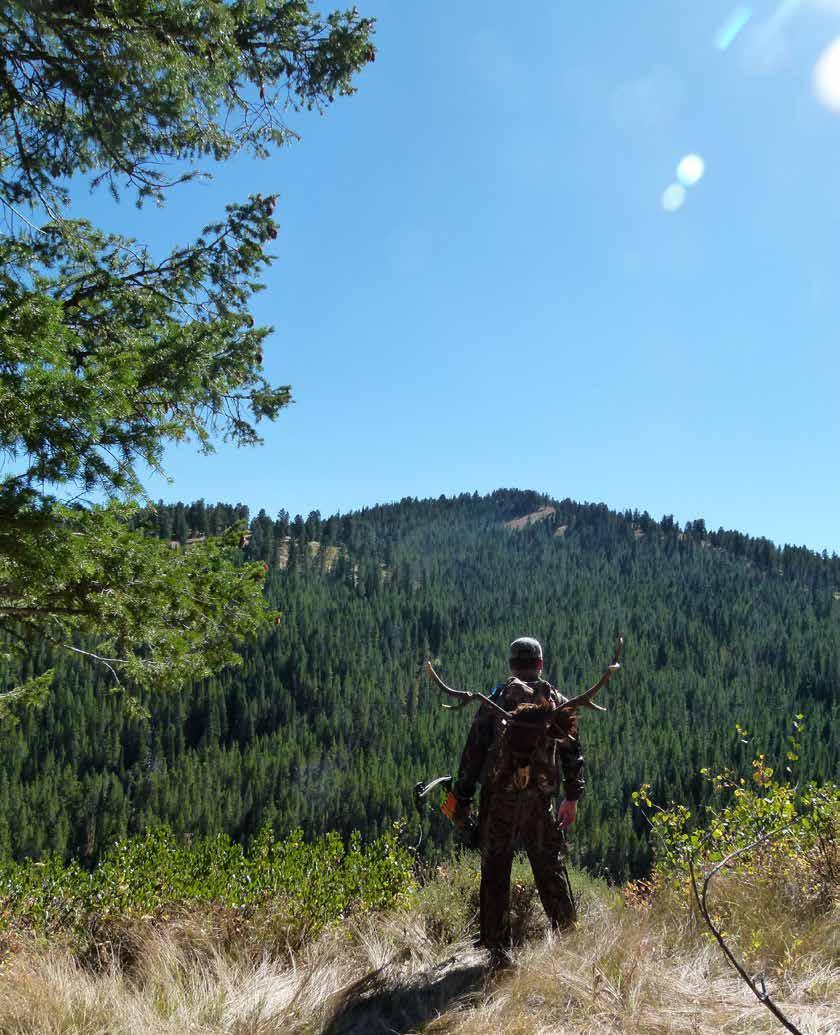
But in the woods, they are different. Quiet, of course, but also calmer, more studied – in mind and body. No extra movements: instead, meditative walking, hyper listening. In this work they are at peace, at ease in a way they never are anywhere else.
deadfall, and soon we scrabble over hundreds of downed trees so large that we must climb over them one leg at a time. We make too much noise in woods too thick.
And then,of course, we smell the elk and find the bed we kicked him out of. Next, a thrilled, heated rush of studying maps, planning, hurried hiking and circling back when the deadfall again becomes pick-up sticks for giants. Even when Paul calls, we hear nothing but our own heavy breathing, our own missteps that break dead branches.
Close to mid-afternoon, and finally out of the deadfall, we stop to shed more layers and have a snack, then hike an evergreencovered hillside and walk hushed steps on pine needles. The sun’s hot, but in the den of pines, it’s cool. Wind blows and occasional pockets of white light – not dappled sunlight, but disco ball light – ricochet around us. And suddenly, in a beam of dazzling sun, an elk carcass.
The wide V of the lower jaw sits upright, all teeth intact –perfect. A spine bigger than a dryer vent hose. Strewn ribs. A shoulder blade as big as a Thanksgiving platter. Not a hint of meat anywhere. We fall on it, starving for the story. Down the hill six feet, Paul finds the skull, the only bone still covered in fur. The rack: four-by-five and pristine other than the mouse-nibbled tip of the tallest tine. We whoop. It is a kind of victory. Though we are due nothing more than what we’ve already been given, it feels like a trade for hours in the deadfall, the silent-not-calling-back woods. We find three legs scattered farther. And then back at the original site, I find a rusting arrow, broken off six inches, and then the broadhead. We scrutinize the skeleton and try to tell ourselves
the story of the last moments of this ghost animal.
Paul straps the skull and antlers to his pack. I carry the jawbone and pocket the broadhead. For the rest of the day, we follow Paul’s antlered back, the sun setting in front of us so that I watch the brothers’ silhouettes – even quieter now.
When we emerge from the forest and have cell service, I dial my parents and ask them to pick us up. “Do you have an elk?” Mom asks.
“We have stories.”
Our feet and legs are lighter knowing my folks are on their way. As we walk, soaked in sweat in the sunny, dry heat, we trade bad song lyrics and old jokes. When Mom and Dad find us 45 minutes later, it’s with cold beers and excitement that matches our own about what’s on Paul’s back.
Back at the house, Trav and Hadden have come home from work, and we yelp and hug, swap stories and toast cans of Rainiers on the deck. Camo and bows hang from pegs. The dogs, Cask and Boone, retrieve the balls Dad throws. Mom asks questions; everyone wants to know it all. Sun blazes through aspens, and the crisp air smells of the woodstove’s smoke. We are happy, joyous.
Seth checks the map and reveals it was a 12-mile day. Not the day we set out for, but a damn good day – our feet sore and lungs full. To say nothing of our heads and hearts.
As dusk falls and night comes in, we begin moving inside, talk about showers and dinner. Paul and Seth don’t hug, don’t even high five, but they do click cans and look each other in the eye and complain about their aching legs. They don’t mention Cal’s

name, but they don’t have to. He is all over their faces and in their muscles and bones.

Paul’s hunt ends without an elk, hampered by weather too warm. We pack up the car, jamming clothes and boots into any available space to make room for the skull and rack. Now it’s mounted on our garage, watches over us in the garden, reminds us of all the hunts we’ve been lucky enough to share with the ones we love, looking forward to the next.
Out in Wyoming, the night freezes begin the week after we leave, and Trav takes a beautiful bull with a single arrow. After he emerges from the woods, he sends photos, and we celebrate over the phone. We aren’t there, but we are as close to being with him as possible.
The invitation is enticing, welcoming. We ask: Behold with me this land that feeds and gives breathing room, this land that gives each to the other in a way nothing else does.
Heather E. Goodman’s work has appeared in Gray’s Sporting Journal, The Boston Globe, TROUT Magazine, and the Chicago Tribune, where her story won the Nelson Algren Award. She teaches high school students and lives with her partner and pups along a creek in Pennsylvania where she occasionally catches tiny, stunning native brookies.
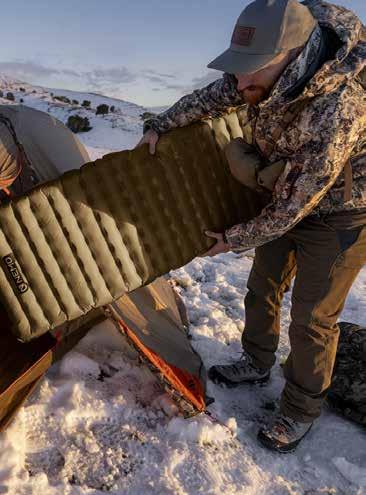




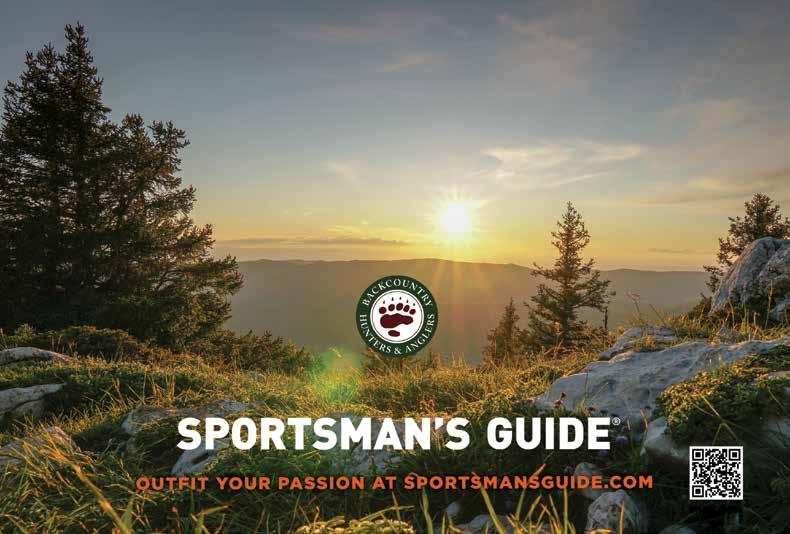
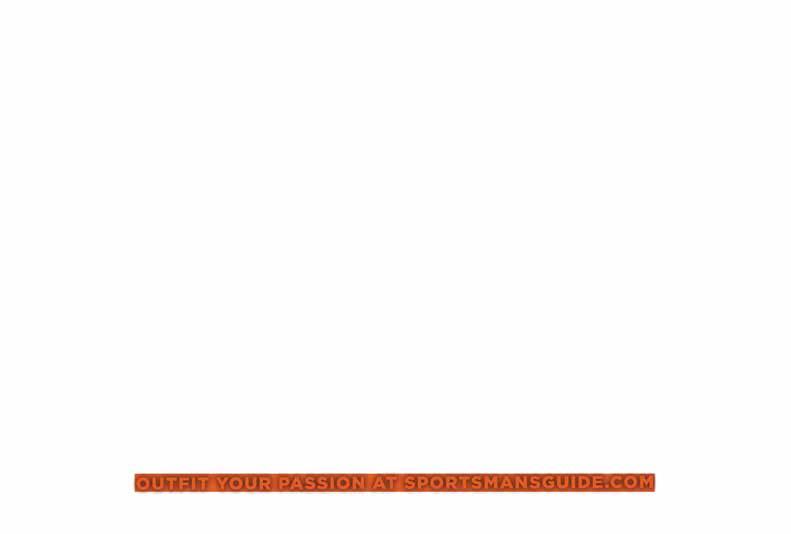


NRS Approach rafts give you the flexibility to fish anywhere, anytime, anyhow. They’re designed to fit between the wheel wells of a full-size truck on the roof of an SUV—no trailer or boat ramp required. Every detail has been examined for angler comfort and convenience. The NRS Slot Rail frame system lets users easily adjust the placement of the seats, oar mounts, and foot bar to optimize the rower’s position and weight distribution. You can also dial in your setup for the coming adventure, from full-luxury fishing to an ultralight format for light-and-fast missions. We include dry box seats, integrated angler trays and rod holders, a quick release anchor system, and motor mount. 16-inch side tubes and a thick drop-stitch floor insert enhance buoyancy, and welded PVC construction resists abrasion on shallow and overgrown streams. No boats give you more options for exploring different ways, and places, to fish.


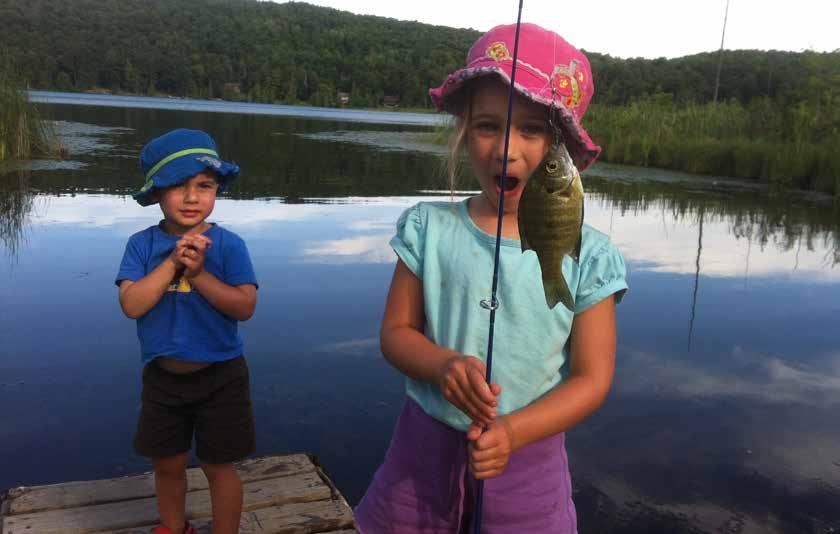
BY JESSE C. McENTEE
“That’s moose poop,” I said, as we walked up the old logging road where striped maple saplings popped up around us. The resident moose population had stripped many of the trees of their green bark. Hooved prints pressed into the ground, stirring up flaky brown leaves from the previous fall. My son placed his hand next to one of the distinct prints left in a drying patch of mud; the size difference between his 4-year-old hand and the moose’s print reminded me of those prehistoric fossilized prints of dinosaurs that archaeologists find.
Earlier that week, we ventured onto Monkton Pond with our vintage 17-foot Grumman canoe. My 6- and 4-year-olds hooked Canadian crawlers and cast them overboard with red-and-white bobbers in tow to keep the bait off the pond’s scummy bottom. An absolute pumpkinseed slaughter followed. When the kids were bored sitting in the canoe and had run out of juice boxes, we fished from the boat launch.
As the years passed, I continued to hike, explore, deer scout and fish with my two small children. If there was a new area I wanted to check for deer sign in preparation for the upcoming fall, I packed the car with snacks, water and some kid’s books on tape and hit the road.
I became adept at matching my own desire to get out and see new territory with the necessities of small children. They needed stimulation, exercise and fun.
Getting our vintage 75-pound canoe off the roof of our station wagon solo took a little figuring. Paddling that same aluminum canoe alone with two toddlers on a windy lake is challenging. I know because I tried many times. My young co-pilots understood the concept of paddling, but functionally, it just wouldn’t work. But place a little electric trolling motor on the stern with a lead-acid battery in the bow, and now you have a solo parent’s optimal exploring and fishing machine – one that’s well-balanced and powerful enough to spend a day catching panfish.
Every parent develops hacks that make their life easier or allow them to maintain some functionality with young children. Whether adding a trolling motor so you can still hit up your favorite local spots or figuring out a few quick weeknight go-to meals that create minimal dishes to clean up, these tools help streamline a chaotic time in family life.
Looking back at this period, I realize my ultimate parenting hack was convenient access to public land. Town properties, wildlife management areas, state forests, national forests, state parks, national parks, wildlife refuges, wilderness areas and countless rivers, lakes and shorelines formulated my kids’ playgrounds. These lands and waters became my parenting partners during the most arduous and lonely times I’ve had as a parent.
I spent plenty of time outdoors before I became a father. Kids, however, inspired me to systematically search for publicly accessible areas to discover. I’d scour the list of Vermont’s wildlife management areas to see which would provide something new and if they were feasible for a 4-year-old to tromp through.

Vermont has 105 wildlife management areas totaling over 103,000 acres managed for various species, from birds to amphibians to moose.
While my young kids settled into afternoon nap time or another episode of Sesame Street, I looked for new WMAs on the map. Sometimes the most fun thing about a WMA is discovering it. While state parks have clear signage and parking, WMAs are easy to miss with minor signs and obscure parking. (I once drove back and forth past the parking area for a 900-acre WMA near my house six times before spotting the patch of field designated as “parking.”)
Desperate for activities to do with my kids, I’d stumbled upon a type of property I didn’t know I had been looking for. WMAs are free to access, unmanicured, and few have designated trails. In a phase of parenting dominated by library story hours, playdates and naps, the WMA’s wild and uncrowded nature rekindled my own spark for adventure just when it was in danger of going out.
Today, I continue to foster my teenagers’ love for the outdoors. I still trick them into going on “hikes” (aka deer-scouting trips) with
me. These outings inevitably end up as moose spotting or as bushwhacking adventures where we see the novel and unexpected.
In their day-to-day lives, my kids are often indoors in the classroom, in front of a screen, driving or looking at their phones. But there are still moments when they go outside, on foot or skis, and we share that special appreciation of the woods. The scent of spruce trees lingers, and there’s no cell service. As the road noise dissipates and a grouse launches from behind a log, startling us, it doesn’t take long to be in that familiar territory we started venturing into over a decade ago. We may get swarmed by mosquitoes or step into a bog that fills our boots to the brim with cold water, but these aren’t unfamiliar experiences.
Undeterred by these minor inconveniences, the memories we create together act as a mechanism to convey my love of the land to them. In turn, with gratitude for the vast amount of open land this nation has to offer, my hope is they become lifelong stewards and informed advocates for preserving these spaces as wild and open.
BHA member Jesse C. McEntee is a writer from Vermont. His work explores pressing issues related to wilderness through the prism of hunting and fishing. You can learn more about his work at jessemcentee.com

MAXIMIZED VERSATILITY
Based on new revolutionary material technology, R8 Core is designed with a forward-thinking lens of what we’re seeing out on the water where one rod needs to show even greater range.
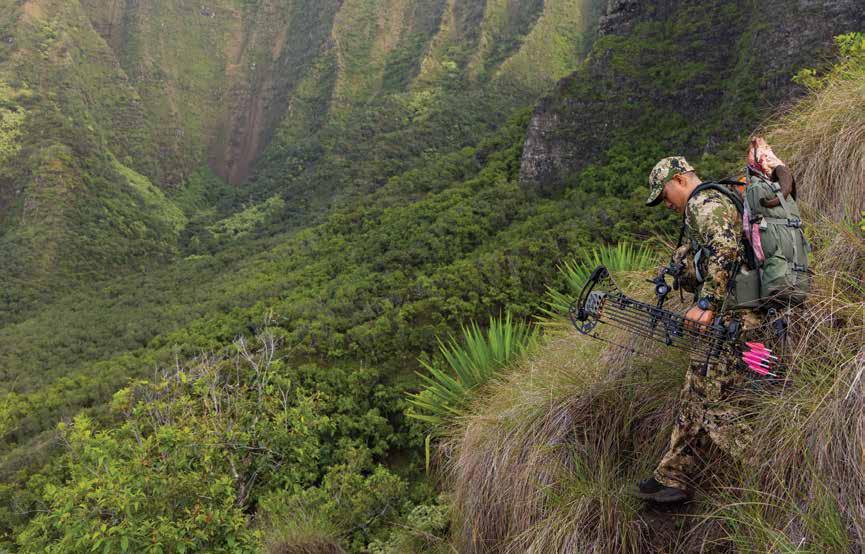


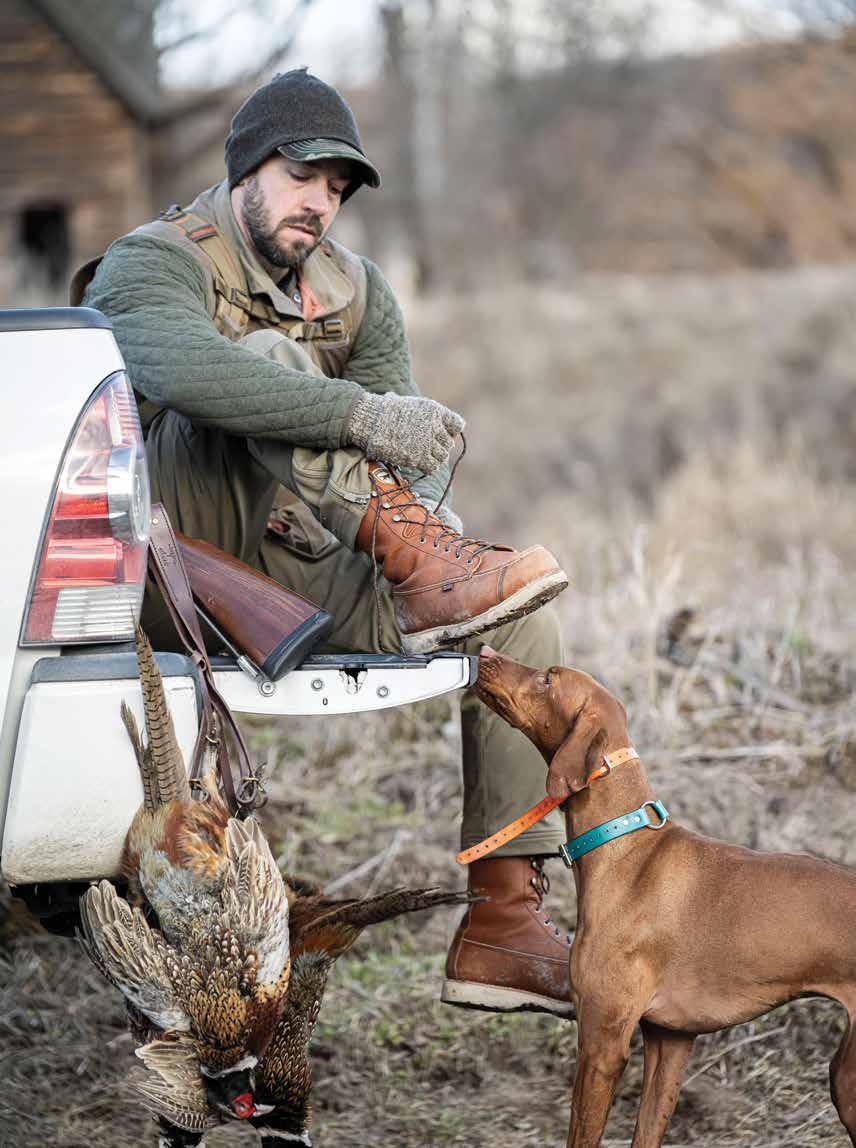

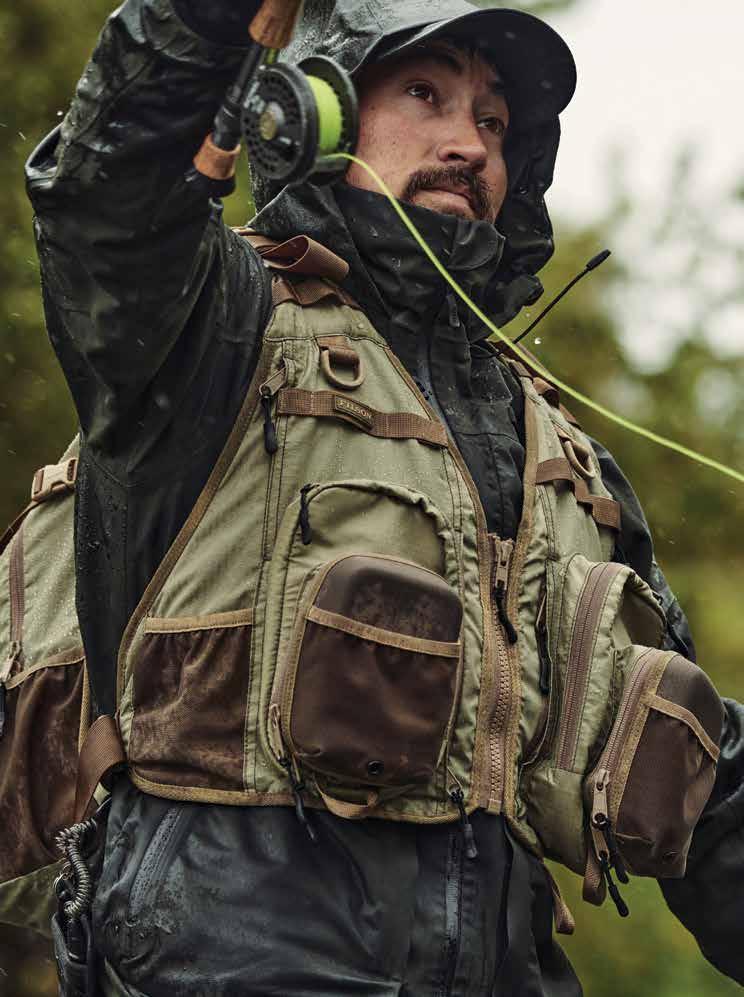


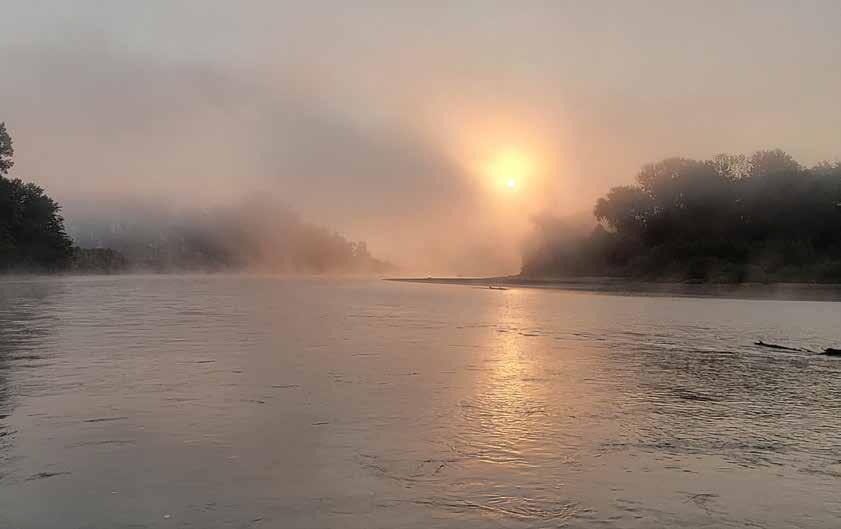
BY T. TRAVIS BROWN
I’m not going to tell you which river because over the course of two days of drifting, I didn’t see another soul except for one bank angler and a guy blaring Jimmy Buffett from the deck of his house on stilts. And I want it to be the same next year. But I don’t really have to mention the name, because these rivers are all over the Midwest and throughout much of the country. They were once busy arteries of transport, but many of them now offer the feeling of wilderness solitude that so many of us pursue.
It was an unlikely place for a backcountry adventure – one of the large, muddy-looking rivers we cross on our way between interstate exits, with a watershed made up of corn and soybean fields interspersed with patches of bottomland forest. This river isn’t surrounded by vast tracts of untouched lands, but after floating a few miles from the nearest road crossing, the only sounds I could hear were late summer insects and water bubbling around logs and through riffles. Thoughts, worries and anxiety melted away like the traffic noise in the distance. The water, which had looked muddy from the bridge, was clear enough to see the fish that were my main focus.
The idea for this trip came about when I realized that early goose season, early teal season and mourning dove season all provided opportunities on the river, and bowfishing would be there to rescue the trip if other pursuits failed. I bowfish our local rivers whenever the flow is low enough to allow for clear-ish water, and this happens most reliably in late summer here in Indiana. My primary targets are the Asian carp that have invaded our waterways in the last few decades.
Bowfishing Asian carp checks several boxes in my opinion. First, they are filter feeders that tend to feed up in the water column, rather than on the bottom. This means that they are relatively low in heavy metals and other toxins that bioaccumulate to higher levels
in more predatory fish or those that feed among the sediment. We don’t have pristine rivers where I live, and, as someone feeding children, this is my most important consideration. Secondly, they are extraordinarily abundant and compete with native fish, so any fish I remove from the river benefits the ecosystem. Third, they have white, flaky meat that lends itself well to many applications once you have learned to deal with the many “Y” bones found in the flesh. Harvesting these fish also provides me an opportunity to use my black locust selfbow. This seems to be an ideal application for a handmade bow and compared to my other bow, which I use to hunt deer, this one has brought home more poundage of protein.
Besides the potential for bringing home some meat, there is a lot of time to think while relaxing between honey holes on a trip like this. My mind empties, leaving room for new thoughts that don’t revolve around tasks or worry, and my soul fills back up. I start to think about the river itself: What did it look like when Native Americans were here? I’m sure the water was clearer, and there was more forest, but what did their fields and villages look like? Then, I think about the darker days of the mid-1900s, during the height of our disregard for the natural world – rivers so polluted that they caught on fire. What I am seeing today is likely a healthier river than those dark days, but it is nowhere near fully recovered, as evidenced by the careful choices I make regarding which fish to eat. But those choices are not limited to this river. Heavy metals like mercury are a nearly ubiquitous problem, even in places that look pristine, due to airborne transport via coal smoke and legacy pollution from industries that have long ago vanished from the riverbanks.
A bald eagle, one of our brightest symbols of ecological recovery, takes off and flaps down the river, and it occurs to me that I likely would not have seen that a few decades ago. I know that a ban on DDT and related pesticides helped with the recovery of bald eagles, and I can’t help but wonder if the Asian carp I’m hunting have bolstered eagle populations in recent years? These are the kinds of

The image of the foggy sunrise, with a steel coffee cup in my hand, still conjures up feelings of peace and selfreliance, which stems from a couple of days spent hunting my way down a river with minimal gear and plenty of resources to pursue.

questions that pop up when you have time to observe and think. As someone who is accustomed to seeing the “world of wounds” described by Aldo Leopold (the cost of an ecological education), this has been a day of optimism.
Camp is a simple setup, with a comfortable sand bed under my sleeping bag and abundant driftwood, and I take some time to explore the large riffle next to the sandbar. I’m surprised to find many small longnose gar sitting on the bottom of the shallow riffle, snatching tiny fish as they go by. I manage to arrow a few of these to take home; the alligator-like flesh is one of my favorites, even though I avoid eating a ton of it for the same reasons I favor Asian carp meat.
Sunrise makes the whole trip worthwhile, as I drink campfiremade coffee and watch the orange sky glow behind the mist rising off the river. I get an early start down the river and manage to miss all three shots at a group of Canada geese flying over on their morning commute. Later, I bag one goose and a dove, but once again, my homemade bow has been the star protein producer of this trip, with a half dozen Asian carp and some small gar in my cooler.
As I enter the final leg of my journey, through a small section of public land, I catch a sweet, overripe scent on the breeze. Alerted

to their presence by my nose first, I finally spot the small grove of pawpaw trees on the bank and add two gallons of the perfectly ripe fruits to my larder. They are also a welcome boost of energy as my paddling takes up a more frenzied pace. I need to make it to the boat ramp on time to meet my wife, who has been kind enough to allow me a couple of days of solitude while she deals with the craziness of work and teenagers, while still agreeing to come pick me up; I wouldn’t keep a woman like that waiting.
I know I am headed back into the fray, with plenty of busy times ahead, but I carry some of the river’s tranquility with me. The image of the foggy sunrise, with a steel coffee cup in my hand, still conjures up feelings of peace and self-reliance, which stems from a couple of days spent hunting my way down a river with minimal gear and plenty of resources to pursue. It does my heart good to know you can still find that wilderness feeling if you look hard enough here in the Heartland.
BHA member T. Travis Brown is a wildlife biologist and lifelong hunter-gatherer living in southern Indiana.






























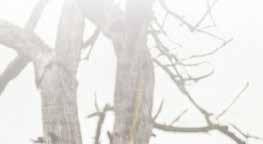





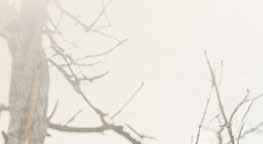




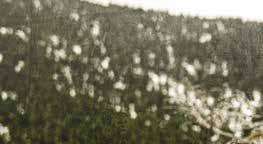

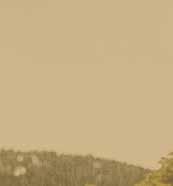



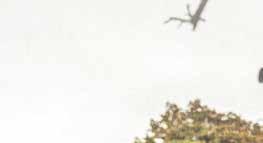




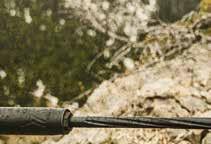




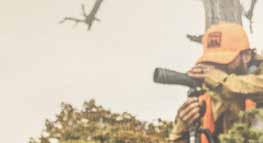


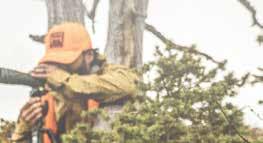



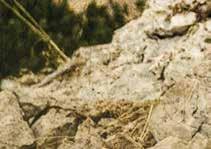

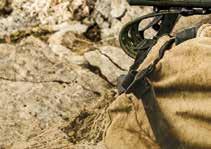





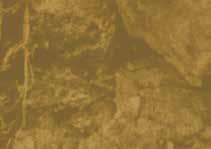







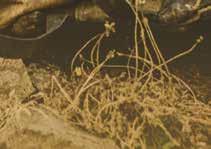








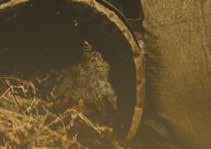

Meant to complement the historic Mark V® and Vanguard® lineups, the Model 307 is a 2-Lug, fully cylindrical action compatible with many aftermarket accessories. Proudly built in Sheridan, WY, the Model 307 will be available in a wide range of Weatherby and nonWeatherby calibers. Nothing shoots flatter, hits harder or is more accurate than a Weatherby. Learn more at Weatherby.com



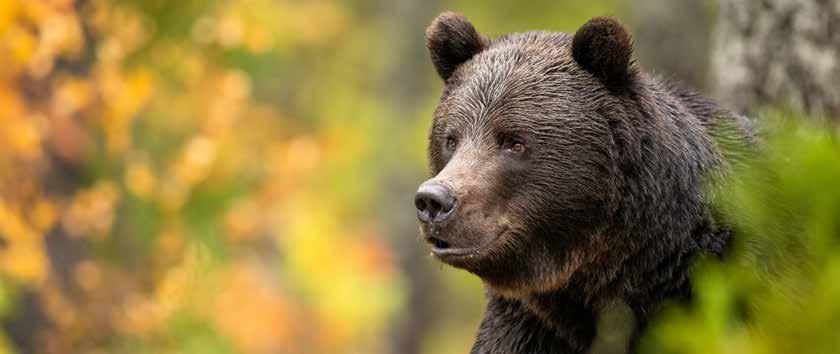
BY DAVID O. MILLER
It’s been said that you are most alive at that moment when you believe you’re about to die. If that saying holds true, my two elk hunting buddies had more life in them at that moment on a cool September morning than anyone can begin to imagine.
For many who love the outdoors, bowhunting for elk in eastern Idaho is about as good as it gets. Being one with the majestic pines, the lazy rivers, hills and valleys, the smell of fall in the air and the shadows of rugged mountains combine to awaken the senses that have been dulled by our busy lives. The elk’s call stirs the blood inside us, renews us and is a catalyst acting as a reminder of who we are, even if just for a few days a year.
Hunting in proximity to the Greater Yellowstone Ecosystem has a unique set of challenges. The biggest, by far, is the presence of grizzly bears – the top of the food chain. While we spend time pursuing the elusive wapiti, we’re also sharing space with grizzly bears at a time of year when they’re actively foraging for valuable protein to sustain them through the long winter months.
When we could, my friends Jon and Dave and I hunted together. I’m a bit older and the three previous days of running the ridges were taking a toll. So, instead of slowing down my friends, on Sept. 22, I decided to just go trail sit in one of my favorite spots, while they set out to chase the occasional distant bugle.
I reached my spot before daylight and settled in for a few peaceful moments of solitude with hopeful thoughts of a big bull wandering down the trail looking to add to his harem. Silence enveloped me.
The next moment, the world changed for my friends. The silence that had filled my ears was replaced by the deafening sound of gunfire. Six or seven shots, so fast they sounded like one, jolted me from my self-induced trance. I knew something bad had just happened.
Jon and Dave were closing the distance between themselves and a bull that was verbally gathering up his cows. Their plan was to get as close as possible to the bull, then lure him in with some sweet cow mews and an occasional, but not serious, challenge bugle.
Jon saw it first: an elk carcass left by a previous hunter, less than 20 feet away. Dave saw it too, but the next thing he saw could have been his last. I will describe it in their words, relayed to me later.
Dave: “I saw the carcass but was still trying to process what it was. I didn’t smell the rotting mass because I was recovering from covid and couldn’t smell anything. The next thing I saw was the sow grizzly coming over the top of the carcass at a full charge, straight at me. In my head, there was no sound, no smell, just bear. There
was also a cub trailing right behind her. There were two other cubs, as well, that were still by the carcass. Everything seemed so fast and so slow at the same time. As her paws hit the ground on my side of the carcass, she turned her head to look briefly at Jon, then without straying her course, turned back toward me with purpose and determination. At that moment, I knew I was in trouble as she easily launched herself airborne toward me. She was so close, all I can remember seeing was teeth, claws and eyes that sent a message that said only one thing: She wanted me dead. I don’t remember grabbing my bear spray or even deploying it. At an arm’s length from my face, her eyes met mine, locked in a deadly gaze. I felt the pain and death that was about to consume me. Then as fast as it started, it ended. It was as if someone took a sledgehammer and hit the bear on the side of the head, knocking her from my face and onto the ground at my side. She was so close at the moment the hammer hit her, if I had the ability to smell, I could have smelled her hot breath. In an instant, the large cub surged over the lifeless body of the sow as I emptied what little remained of the bear spray directly into its nose and eyes, leaving a bright orange spot. The spray did its job, immediately turning the cub away. He was joined by the other two as they went squalling into the dark timber. As I looked down in disbelief and shock, I was still holding the can of bear spray and still pushing the trigger of the now empty cylinder.”
Jon: “When I saw the carcass, I knew we were in trouble. Before I could even begin to process the danger, I saw the sow flying over the carcass and headed straight for Dave. She did not have far to go, and she was moving fast. I could tell the bear was committed as she was in full charge at Dave, who was only an arm’s length to my right. I don’t remember hearing the bursts from my 10mm, but strangely enough, I could see the bullets hitting the bear’s body one after another, but with no apparent effect. I could hardly keep up with her charge but remember her briefly glancing my way and quickly regaining her deadly focus on Dave. At that instant, I felt in my heart that my friend was about to die. My next-to-last shot shattered a small tree between us. The next shot connected with the bear’s thick skull, and she was blasted away from Dave’s face as she fell in a heap at his feet. My emotions were running wild, but I remember most vividly the unimaginable relief that we were alive, and the feeling of heartbreak because I just killed a magnificent animal. What I remember most about the attack is the indescribable sound coming from the bear as she charged us. It was a sound that I cannot compare to anything else. It was a deafening, gut-wrenching, primal shrieking, death-defying roar.”
Jon confessed to me that it’s something he still carries around in
his head and will likely never forget.
After the bear fell, the cubs scattered making an awful racket. My friends did not stick around. Once they had gone what they felt was a safe distance, they stopped and just looked at one another with the same unspoken question, “What just happened?” When they did try to speak, the words came out only as mumbles, unable to form their words. When Jon composed himself enough, he called the local fish and game agent and explained as best he could what had happened. They agreed to meet at a designated spot in the nearest town.
Two agents showed up and were very respectful and understanding of what the two hunters had just experienced. They wanted to know if they were OK and if either of them was injured. The agents did their jobs and asked all the required questions – after all, a federally protected animal had just been killed.
deterred. The sow came out of nowhere so fast and so determined that the only thing that could stop her was the gun.
In many other bear encounters, bear spray has helped resolve what could have otherwise been deadly outcomes. So, why does bear spray work most of the time but not always? Maybe it just depends on the bear’s motivation and attitude. In this case, the sow was not only on a food source but also had three cubs that she was protecting. To say that she was committed to eliminating the threat to her cubs and food source is putting it mildly.
The next moment, the world changed for my friends. The silence that had filled my ears was replaced by the deafening sound of gunfire. Six or seven shots, so fast they sounded like one, jolted me from my self-induced trance. I knew something bad had just happened.
Once Jon and Dave gave their statements, they agreed to meet up later to take the agents to the scene.
What should have been a routine inspection of the scene turned out to be anything but: Eight agents showed up including two wildlife biologists. All were armed with rifles, shotguns, pistols and a tranquilizer gun. It took Jon and Dave a little while to locate the site, which is filled with a combination of dark timber, short pines and some gnarly, thick foliage.
When they did arrive, what they found took every person there by surprise. After taking several shots to the body and one to the head from Jon’s pistol several hours earlier, the bear was still alive. Everyone stared in disbelief as the bear raised her head and started to get up and charge the group. Although badly injured, the sow still possessed the will to eliminate anything or anyone who got in her way. There was no question about what had to happen next. The agents did their job and quickly dispatched the bear.
There was hope the cubs could be located, captured and relocated to someplace safer, where they would have a better chance of survival. Unfortunately, they were nowhere to be found.
Once the scene was secure, the agents went about the task of figuring out just what had happened. After measuring distances and observing the position of the carcass and spent rounds, they all concluded it happened just like the hunters told it. The spent rounds from Jon’s 10mm were found only three feet from where the bear now lay dead. They surmised that at the time of the attack, the sow and cubs were likely in a day bed when the hunters came upon the carcass. They estimated the sow began her charge on the far side of the carcass approximately 35 yards from the hunters. It only took seconds for her to cover that distance.
We all hope that we’ll be prepared the moment an emergency requires us to respond. Jon instinctively called upon a lifetime of experiences that day to help him respond at just the right time and in just the right manner. It was almost as if Jon had spent his whole life preparing for this one moment that would save his friend’s life.
Those of us who hunt and share the outdoors with bears must be prepared for a chance encounter. Be vigilant of where you are and where you are going. In bear country, you should always carry bear spray and know how to use it. In this case, the spray had little or no effect on the charging sow. However, the cub was completely
Dave always carries bear spray; he does not carry a gun. Many times, I’ve seen him not only carry bear spray in his free hand but also with the safety off and finger on the trigger. He is aware of his surroundings and always ready for something he hopes he will never see. But if Dave had been alone that day, the outcome would most likely have been his death or, at a minimum, severe injury. Even with the speed of the bear, Dave was able to deploy his bear spray with amazing accuracy. Proof of this was evident by observing the orange contents of the spray covering the bear’s chest, neck and head.
I have reflected on this quite a lot. What would I have done if I had encountered that bear while alone? I have been taught to always use bear spray first. I believed the gun should be a last resort. No reasonable person wants to kill a bear in a chance encounter situation, if at all possible. I believe now there is no set answer to “what would I do?” Everything that needed to happen for Jon and Dave to escape with their lives that day did happen – just the way, and in the amount of time, that it needed to.
The only thing that saved both their lives that day was the fact that Dave was not alone. That day, he hunted with his best friend Jon. I have also chased elk with Jon for the last five years and from the very beginning, he told me to always carry bear spray – and a gun. “What kind of gun?” I asked.
He said, “Carry the biggest gun you can effectively carry and shoot well.” I did some research online and at local gun shops and decided that a 10mm semi-auto was my best option to carry while in the woods with grizzly bears. I was so convinced that my family and I gifted Jon one just like mine in appreciation of his friendship. He received his gift only a few months earlier from the time he saved his friend’s life with it.
There will always be debate over whether to use bear spray or a gun when confronted with a grizzly. I don’t think any of us can really know the answer until that moment of truth arrives when we are feeling “most alive.”
I will continue in my quest to harvest my first elk. I will do it in places that elk and grizzlies call home. But I will always remember, I’m in their neck of the woods. I will carry bear spray and my pistol and know how to use them both. I just pray that I choose wisely for both me and the bear.
BHA member David Miller is a retired military veteran and lives in Louisiana. He has spent the last seven Septembers enjoying the challenge of bowhunting for elk in eastern Idaho.


NEW AMBIENT 75 HOODIE
ADAPTS TO CHANGING WEATHER CONDITIONS AND LEVELS OF ACTIVITY.

ENGINEERED TO BE DURABLE AND PACKABLE WITH LOWBULK PRIMALOFT® EVOLVE ACTIVE INSULATION.

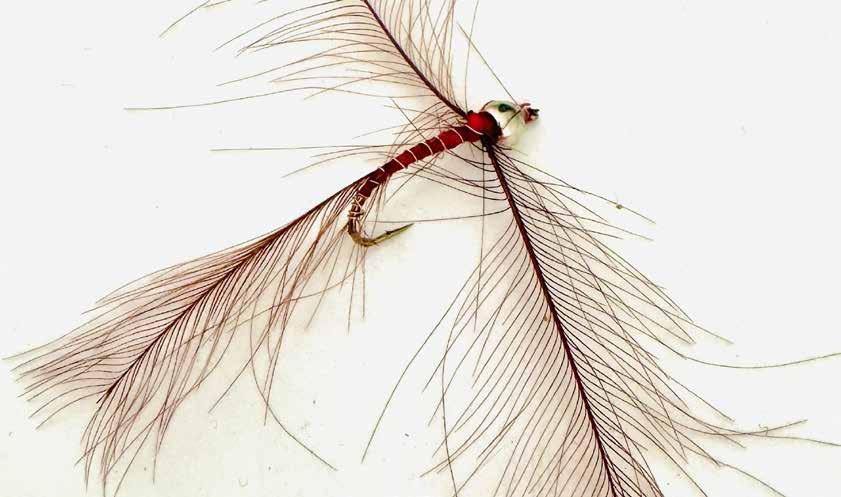
BY MATTHEW MEYER
“It’s called a Graham Float Spurt,” I replied to the man who’d just asked about my choice of fly.
He’d been eyeing me from the path for a few minutes, like a tourist in a cathedral, unsure if it was appropriate to approach the priest lighting candles.
I don’t think of myself as a fly angler or, perhaps better put, I’m pretty sure those who do would not. I can tie my own flies, and I catch fish with a fly rod, but quiz me on the merits of Euro versus traditional nymphing or the intricacies of leader and tippet formulas, and I promise to disappoint.
This is not to say I’m against expertise or diving into the nuances of a subject; I appreciate both. But my approach to fly fishing is more haphazard, more improvised, and I put a premium on playfulness and experimentation over strict adherence to traditions and mores.
When I tie a fly, for example, I rarely follow a pattern. Sure, when I first started I watched instructional videos and learned the standard repertoire. I tied wiry Elk Hair Caddis, Adams dry flies, Woolly Buggers and all of the other patterns one would expect to find in the Platonic fly box. But once I’d picked up the basics, I struck out on my own.
Sometimes I’ll tie a fly and then give it a name, but more often I’ll ask my wife for a moniker and fashion one to match. She has a knack for sparking the imagination – Bartleby Prefer-Knots, Chamber Pot Leviathans and Stasi Nightwatchers are just a few of her inspired appellations.
This, incidentally, was how my current fly, the Graham Float Spurt, was hatched.
The man, who had now moved from the path to the bank of the river just 10 or so feet from where I was wading, nodded his head as though what I said had meaning.
“They any good on this stream?” he asked, seeming to want something more concrete to take away.
“I wouldn’t fish with anything else out here right now,” I replied.
This was true since I only had three identical flies with me that day.
He gave a quiet, knowing chuckle, as though to imply, Of course I knew that. I was just making sure you did.
Just then, I felt the explosive tug of a trout strike and instinctively lifted the tip of my rod to set the hook.
“Whoa!” the man yelped reflexively. “Get him!”
Twenty seconds later, I had the seven-inch brown trout in my net. My new companion peered over the bank, beaming with approval. Without lifting the small fish from the water, I gingerly removed the hook with a pair of hemostats and released him back into the cool, dark pool from which he’d just been extracted.
“Nice job, man! You don’t keep ‘em?” my new companion asked, delighted by the performance.
“Sometimes, if they’re over 12 inches, I brine and smoke them. They’re delicious.”
He watched for a little while longer, envious of where I was and where he was not. I could sense there was something else on his mind.
“I just got into fishing,” he said finally. “Started during the pandemic. I’m not very good though, not like you.”
I am objectively not a good fly angler.
The man took off his bucket hat and wiped his brow with a sleeve.
“What was the name of that pattern again? I gotta get me some of those.”
I waded over to the bank and snipped off the fly, handing it to him.
“Here,” I said, “Take this one. Might be tough to find in the shops.”
BHA member Matthew Meyer is a graphic designer turned attorney turned writer who lives with his wife in northern Colorado. When Matthew isn’t enjoying the public wilderness and waters outside his front door, he enjoys cooking, playing music, Brazilian jiu-jitsu and, of course, tying new flies.






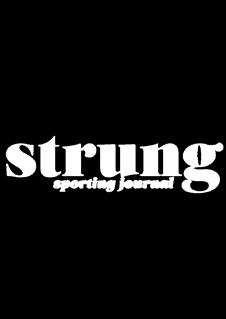



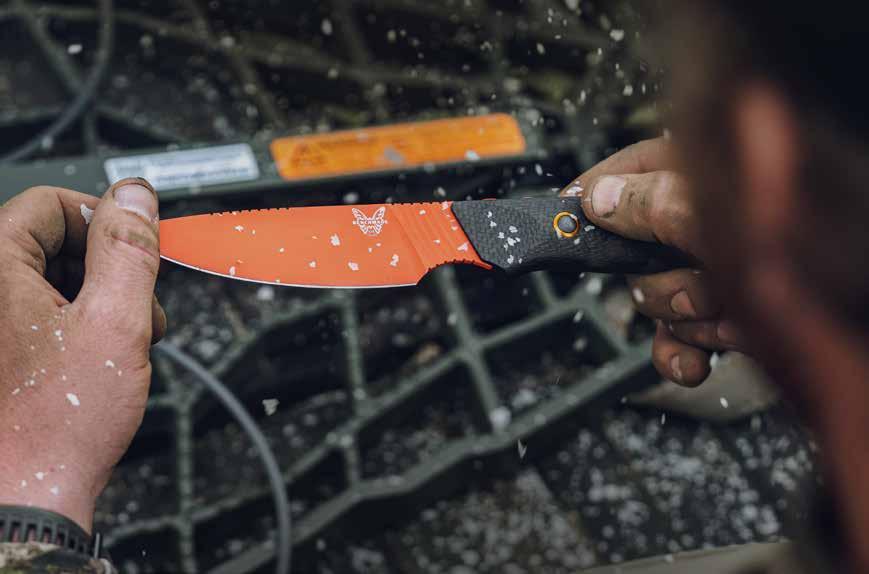

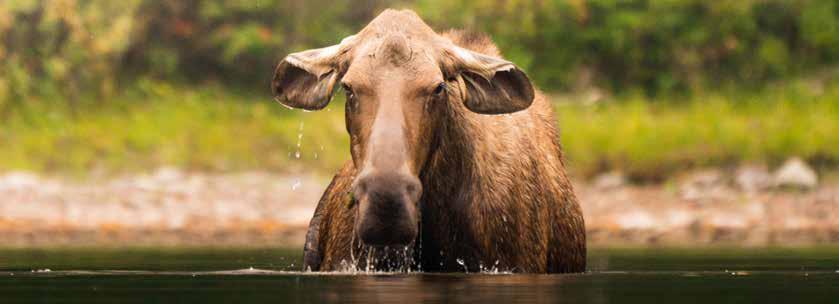
BY ERIC NUSE
It’s sunset. I’ve been in a treestand for three hours watching the proverbial grass grow. Then I hear a light crunch in the leaves. My heart instantly starts to pound. I am on full alert, “alive man” as Barry Lopez characterizes it. So what is going on within me that my heart rate goes through the roof when game is afoot?
I used to think that hunters who die of heart attacks succumb because they’re out of shape and have overdone it physically. I know now that it’s more likely the same phenomenon that drove my heart rate into the danger zone – a deep, primal excitement of the hunt.
Author Richard Nelson reported, “During a year I spent in the Arctic coastal village of Wainwright, I was struck by the fact that Inupiaq men lived to hunt as much as they hunted to live.”
Hunting evolved as a necessary skill and the resulting high-value protein was critical to the evolution of the human brain. In a recent address, Shane Mahoney said, “I am a firm believer that the hunting traditions of mankind have given us art, language ... technology … [and] the capacity to share. In short they have given us our humanness.”
The thornier questions are: Is hunting still important to humans in the modern era? Does it still contribute to us being human? And if so, is it a good thing?
One could argue that Homo sapiens are the most destructive species ever unleashed on the world. We have so overshot our evolutionary fitness level that our population and resource depletion are causing potentially irreversible environmental harm. Unregulated hunting was one of those harms. However, I contend that modern fair chase hunting contains a seed that could spark a transformation of our relationship to nature. I am cautiously optimistic because this love of the hunt has sparked a transformation before.
In the late 1800s, sportsmen became alarmed at the depletion of game in the U.S. They put their political and monetary might behind what we now call the North American Model of Wildlife Conservation and brought game back to the abundance we now enjoy. In those days, reversing the decline of game looked nearly as unlikely as reversing climate change does to us today. But despite the odds, hunter-conservationists led the way and convinced enough concerned citizens that through game laws, enforcement and habitat conservation, we could have sustainable wildlife populations into the future.
For 10,000 years, since the advent of agriculture, most humans have been increasingly alienating themselves from natural processes. This trend accelerated with the Industrial Revolution and the resulting rise of cities. With well over 50% of the population now living in urban areas, the divorce from nature is even greater. Couple this with digital technologies and virtual worlds, and you have a
vast population which has minimal direct contact with nature and its cycles.
According to the late Jim Posewitz, founder of Orion - The Hunter’s Institute, “Hunting is one of the last ways we have to exercise our passion to belong to the earth, to be part of the natural world, to participate in the ecological drama, and to nurture the ember of wilderness within ourselves.”
Hunters face the tension between their intent to take game and the lure of overwhelming technologies that improve our odds but diminish the hunt. Mindful hunters have developed the concept and practices of fair chase hunting.
Through a variety of laws, codes and self-imposed limits on method of take and equipment, the hunter dials back the years to when humans just barely had an edge over their prey so they could survive as a species.
So how does this fair chase hunting help the current dismal state of affairs between humans and nature? Key to realigning our behavior with nature is the self-imposed restraint based on the hunter’s respect and reverence for the processes that sustain life and their love of the hunt.
If the majority of people thought about their actions, from procreation to energy consumption, the way mindful hunters think about wildlife and their habitat, we would be living in a much more sustainable world.
What if individuals, families, communities and nations adopted the hunters’ fair chase restraint to all aspects of life and said, “No” to our penchant for overwhelming our environment? What if we said, “No” to the idea that all growth is good? What if instead of measuring our prosperity by money and possessions, we measured it by the health of our environment, our relationships with other living beings and the natural beauty and wonder we pass on to future generations?
Does hunting make us human? It certainly once did, and I posit that it still does. Genetically, our DNA is the same as the hunters we were 20,000 years ago. Can we rekindle the positive traits that hunting contributed to humanity? Can enough people learn the restraint of today’s ethical hunters, so that humans and all of nature will have a home 20,000 years from now?
Eric Nuse is a retired Vermont Game Warden, hunter education administrator and former Executive Director for the International Hunter Education Association. He currently serves on the boards of Orion - The Hunter’s Institute and the Vermont leadership team of Backcountry Hunters & Anglers. He has a degree in Wildlife Management from the University of Maine. Eric is an avid hunter, angler, conservationist and wilderness canoeist.
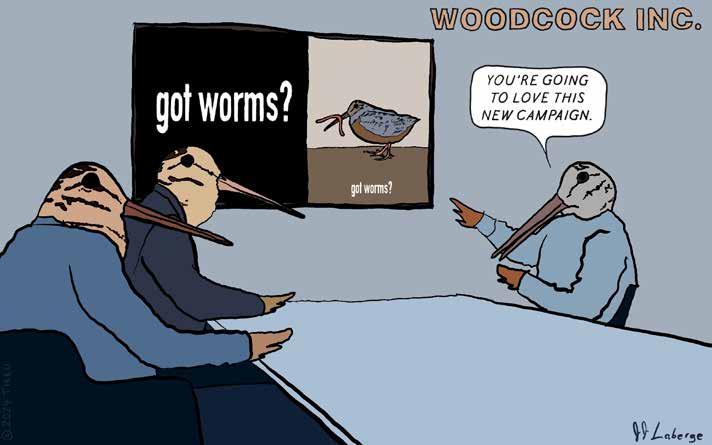
member JJ
is the creator of Clade & Genus, an online comic that focuses on the business of nature. His inspiration comes from spending time in the outdoors within Northern Ontario’s vast public lands pursuing whitetail, moose, ruffed grouse and woodcock. You can find Clade & Genus on Instagram @cladeandgenus or online at www.cladeandgenus.com
You can choose to make one donation at a time or become a sustaining donor and make monthly donations. All donations are fully tax-deductible and go toward securing the future of hunting and angling –ensuring that you have access to public lands and waters and healthy fish and wildlife habitat when you get there.
Our shared lands, our responsibility. We are working to diversify our funding sources to ensure that BHA will always be working on behalf of our wild public lands, waters and wildlife – for generations to come –by establishing a $1 million endowment. This investment will grow and become a perpetual funding stream that exists to support the future needs of our organization, regardless of any unpredictable challenges beyond our influence. Give today to form the root structure that will sustain BHA for many years to come.

Including Backcountry Hunters & Anglers in your plans for the future will create a long-lasting impact for our wild public lands, waters and wildlife. Your commitment to BHA will allow the next generation of conservation leaders to continue our work as part of your legacy. Including BHA in your will, trust, retirement account or life insurance policy is one of the easiest and quickest ways to support the future.
Support BHA every time you search online by using search engine Bing’s Give Mode.
Please contact admin@backcountryhunters.org or visit backcountryhunters.org/donate for more ways to support BHA.






BY CAMERON J. KIRBY
The beach was framed by hills, rolling like the waves below. Seagrass spasmed in the breeze as we descended the dune toward a secluded stretch of the Oregon coast. It was nearing dusk and the opportune time to hunt for free-range bait. With shovels raised above their heads, my two sons ran toward the water; unknowingly, yet almost instinctually channeling William Wallace’s last stand against the English. It was time to conquer some crustaceans.
The very nature of sand revolves around how consistently it’s inconsistent, so much so, that it’s often used as a metaphor for life. Yet, once you’ve decoded the type of inconsistencies to look for, locating subterranean creatures becomes second nature, especially if you’re wearing polarized lenses (as nature intended).
There were two main creatures we were hunting for: the mole crab (Emerita), and the ghost shrimp (Neotrypaea californiensis). Fortunately, both leave small divots in the sand and can be captured comparably: Dig away from the ocean, about 4 to 6 inches below the divot. They’ll both attempt to find refuge in the water and by doing so, will dig straight toward your hands or shovel. They also make excellent fishing bait; like a New Englander, the fish can’t resist some fresh shellfish.
The mole crab is commonly known as a sand flea, and though it looks sinister and triggers a primitive ick factor, it’s harmless and safe to handle, even for children. They are filter feeders that, I imagine, long for something solid to hold, with the corresponding mandibles to see it through.
The ghost shrimp range in size, but max out around 4.5 inches long and are frequently found in the stomachs of local fish.
Supervising my boys, I walked the beach with a drink in hand, full of melted ice in the color of whiskey – the only true ghost of these parts. “Hey, there’s one.” I loosely pointed as they ran toward the next indent, their shovels and hands furiously digging away to unearth their prey.
“I got one!” my oldest yelled as he hoisted the mole crab over his head. As a father, I had a secret pride in their comfort level in grabbing these repulsive critters with their bare hands. It’s a simple thing, but I know I’m doing something right, especially in this modern world when it’s easier to hand them an iPad and allow technology to entertain them. They were outside participating in the natural world, taking their rightful place at the top of the food chain.
“Throw him in the bucket,” I said, as I admired their collection thus far. The surf perch wouldn’t stand a chance.
The best time to catch these denizens of the swash zone is around dusk, during an outgoing tide. Not only will you catch plenty of crustaceans, but you’ll simultaneously enjoy a beautiful sunset during golden hour and sufficiently wear your kids out before bedtime. Since you’ll likely need to store your newly acquired bait, I’d suggest storing it with sand and ocean water in a cool place like a cooler or a refrigerator. For longer-term storage, you can rinse them off with fresh water and freeze them. If you’re feeling especially adventurous (or desperate for calories), you can fry them up and eat them, or so I’ve been told.
It’s convenient to buy bait at the local outdoor store, and it gets


you out on the water a hell of a lot quicker, but if you have the time and inclination, hunting for your own can be an entertaining way to fill an afternoon. It can also be a fine teaching aid in the intricacies of the food chain. Food is everywhere, yet sometimes you must invest for a palatable return.
Sportsmen and sportswomen have a rich history of knowing what their prey eats and capitalizing on it: from fly anglers watching the hatch and kids digging up worms for their local fishing hole, to upland hunters inspecting the gullet of their birds, and everything in between. It pays to hunt the food of your food, even if it’s just to have a good time.
After your investment has matured and you’ve successfully caught your surf perch, you’ll need a delicious way to eat them. Like most white fish, they work well in a taco (what doesn’t?). Below is my goto fish taco recipe that I use to make friends and impress enemies.
Ingredients:
• 2-4 white fish fillets (gutted, scaled and deboned)
• 1 tablespoon minced garlic
• 1 chopped sweet onion
• 1 can of drained pineapple bits
• Small bag of macadamia nuts (optional)
• Flour
• Salt
• Pepper
• Butter
• Oil
Directions:
• Melt half a stick of butter in your pan until it’s evenly coated, then add your chopped onion and allow it to cook until it’s caramelized (may require more butter as it cooks down). After your onion is well on its way to caramelization, add your minced garlic, pineapple bits and macadamia nuts – set it to low heat, stirring occasionally.
• Gut, debone and scale your fish; pat dry and add a light coat of flour mixed with salt and pepper.
• Prepare another skillet – heat it on medium before adding the oil, this will help prevent the fish from sticking to the pan. Add your fish and fry each side for about two minutes or until the cross-section is flaky and the skin is crispy.
• I prefer using raw flour tortillas that require cooking over the stovetop, however, any tortilla will work. (Warm them up – we’re not Neanderthals.)
• Assemble your taco, and add your preferred hot sauce. A homemade crema also pairs well and balances out the sweetness of the pineapple.
BHA member Cameron J. Kirby is a Pacific Northwest native who enjoys exploring wild places with his family and friends. As an avid outdoorsman and naturalist, he enjoys hunting, fishing, a good book and an even better whiskey.
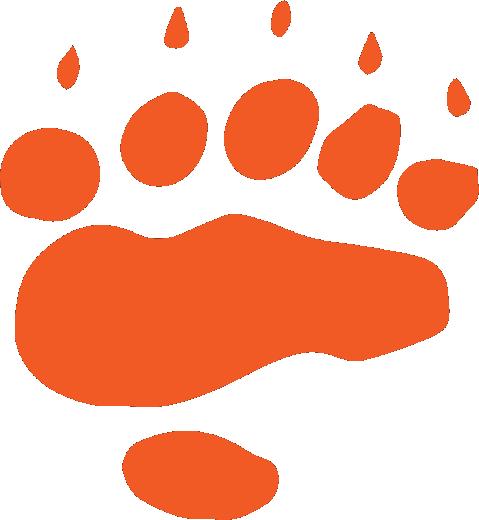
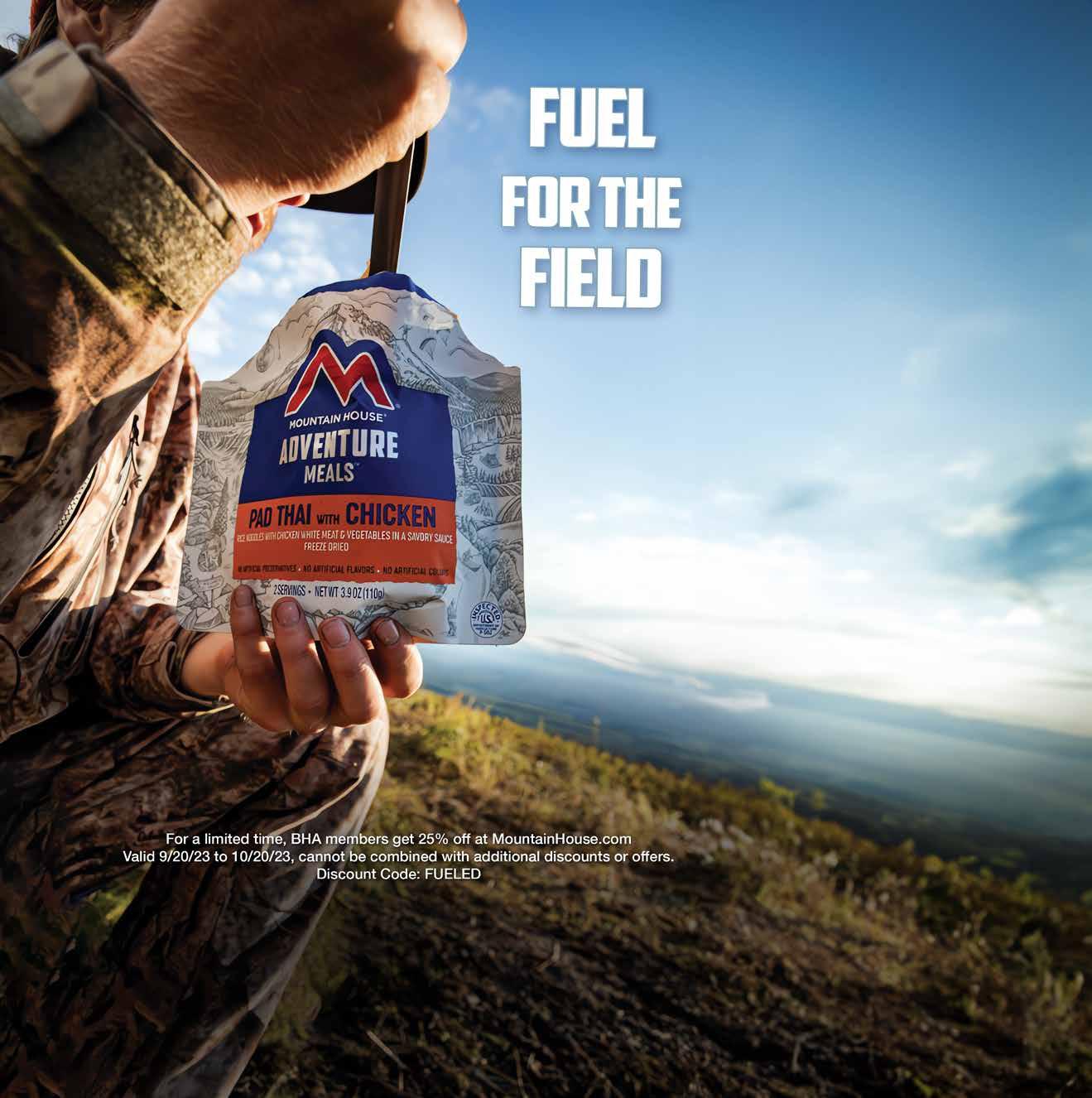

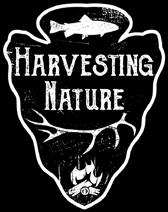

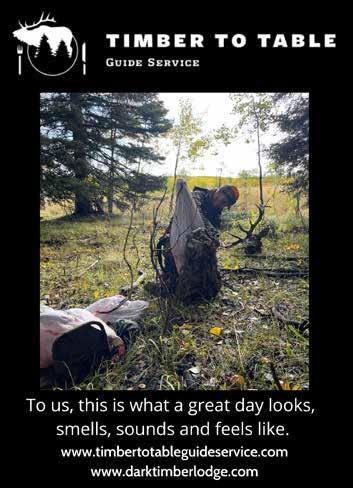








If you follow hunting and fishing “influencers” on social media or by watching YouTube, you could easily be influenced into thinking that these folks kill a big bull or buck or catch a giant fish every time out. And it’s easy to fall into the trap of expecting the same for yourself. Of being so confident – or naive – as to think everything will go the way we dreamed.
In my experience, it’s also easy to feel pressure to have as exciting of adventures or as great of stories as your peers. My predecessor, former Backcountry Journal editor, Sam Lungren, had an exciting wilderness adventure to share in nearly every issue’s installment of End of the Line. And honestly, five years ago, when I began my tenure as editor of this magazine, I felt a lot of pressure to perform similarly and share grand adventures and hunting successes here.
Of course, I could embellish some and make a story out of something. But the truth is, that really isn’t my life right now. Mine is more that of a husband and father to a 4-year-old and an editor who spends most of his time staring at a computer screen. My wife and I, of course, do our best to share our love of public lands, waters and wildlife with our child and to make lasting memories in the field and on the water. But they are our own type of adventure, and the unfortunate truth is that they don’t often make for edge-of-theseat reading. But it’s my guess – and my hope – that a fair amount of you can at least relate to our situation.
One thing parenting has made me better at is leaving all expectations at the door. Think you’re going to take your kid to catch a bunch of fish? Or go hunt morel mushrooms in the river bottom or shed hunt up that mountain? Your kid might – and likely will – have other plans. Case in point, a few weeks ago I took my daughter bass fishing at a local pond. She’d been asking to go for a couple weeks, and the weather and our schedules finally cooperated. She was excited for it.
However, as we pulled into the parking lot at the pond, she noticed that the state park had a playground. I tried to distract and shifted back to the fishing, parking at the opposite end of the park. We went fishing, and she caught a pretty nice bass on a nightcrawler in her first 10 minutes. We were both thrilled – maybe me more so. We returned to fishing, but after another 20 minutes she said she was done. “Already?” I asked.
“I want to go to the playground.”
I’m trying really hard to never push fishing on her, to let her explore at her own speed, so I relented. End of day tally: 1 fish, 30 minutes of fishing, 30 minutes of playground, 90 minutes of driving.
Lately, I’ve been reminded of another truth: Sometimes, no matter how much you plan and prepare, your adventures just aren’t
going to go right – no matter how hard you try. Murphy’s law can and will show its ugly teeth from time to time.
For me and my family, that’s pretty much been the rule not the exception in recent memory. For the past two years, our adventures have been defined by nap times, illnesses and mishaps.
There was the overnight float trip where we had a great day swimming, fishing and floating. But then it never cooled off that night, and at midnight, our toddler, who’d really never been up much past nine, was still awake, overheated, exhausted and crying. When that was followed by an earth-shattering thunder clap 30 minutes after finally closing our eyes, and a wildfire sparked on the mountain just above, the trip turned into one you’d hope to soon forget.
Then there was covid in November that derailed the entire month and my long-planned backcountry elk hunt, which kept getting pushed back until it didn’t happen at all.
And then there was covid again, here just last week, on the second day of a family trip to Alaska, resulting in my wife missing her grandmother’s ash-spreading, followed by the cancellation of our family adventures for the rest of the week and a lot of time and money wasted.
It’s funny the way time works, however. Something in the human brain seems hardwired to forget the bad with the passing of the days, months and years. The memories that remain are those little moments that stood out in contrast to all the shit. The exhausting and even frightening float trip goes from “never again” to planning to do it again this summer: “Do you remember how warm and clear the water was?”
And the deep, lingering sadness of a canceled elk hunt is replaced with the memory of the last half-day of the season, still sweating out the fever, where my frustrations pulled my weakened limbs 4,000 feet up a seldom-hunted mountain – where I didn’t kill anything but found a mule deer track so huge that I first mistook it for an elk. And just like that, all those negative thoughts were replaced with dreams of the coming fall.
And then the recent Alaska trip, where there were those little moments of happiness: the moose sightings for our daughter and her playing in the lakeside mud under towering mountains and spotting my first two brown bears, which I glassed up across the valley while soaking in our rental’s hot tub.
And the kid who asks, “Daddy, when can we go bass fishing again?”
-Zack Williams, editor


